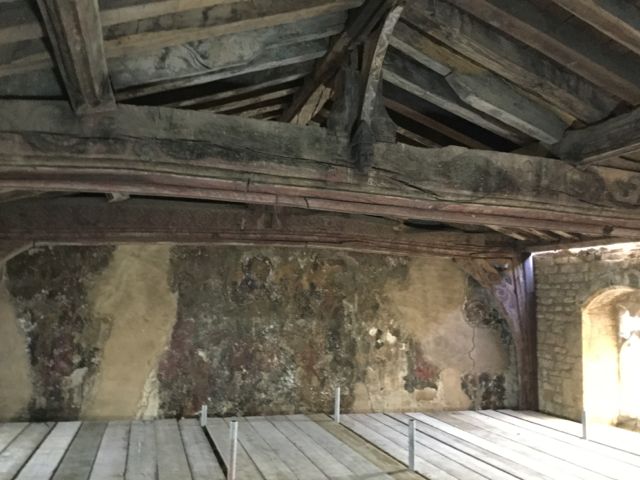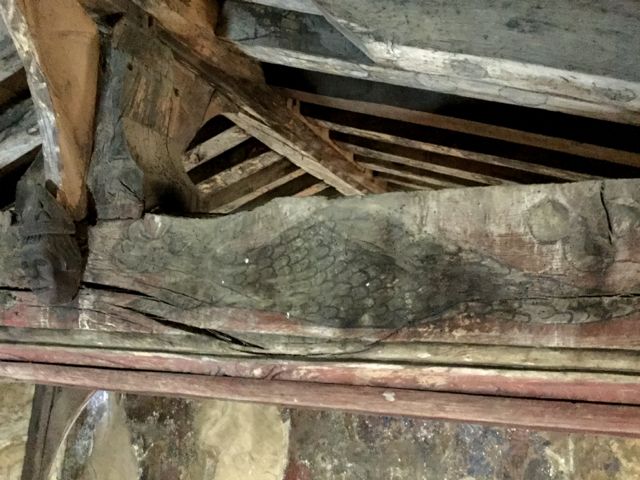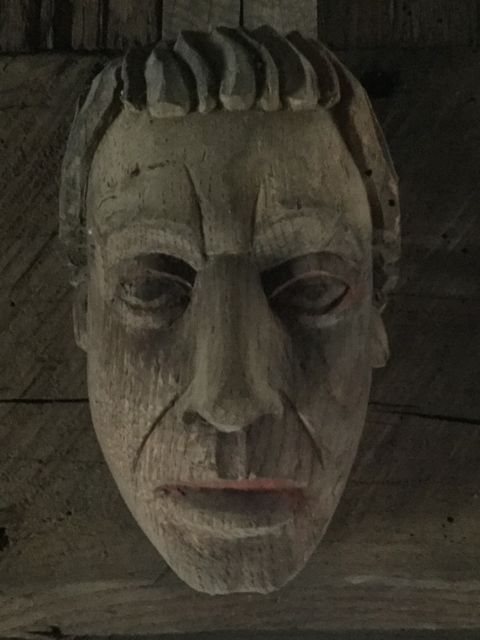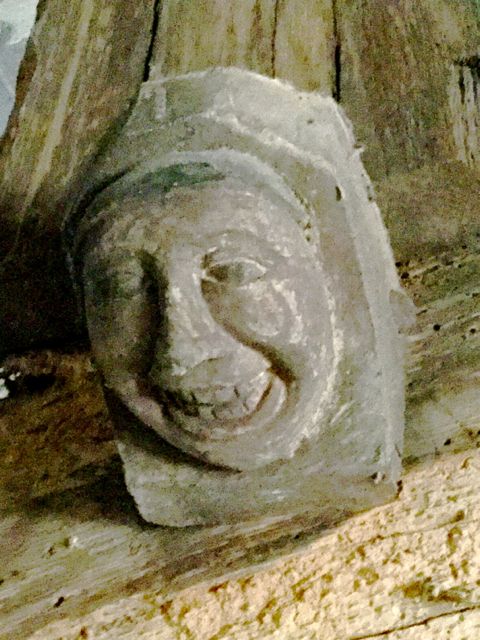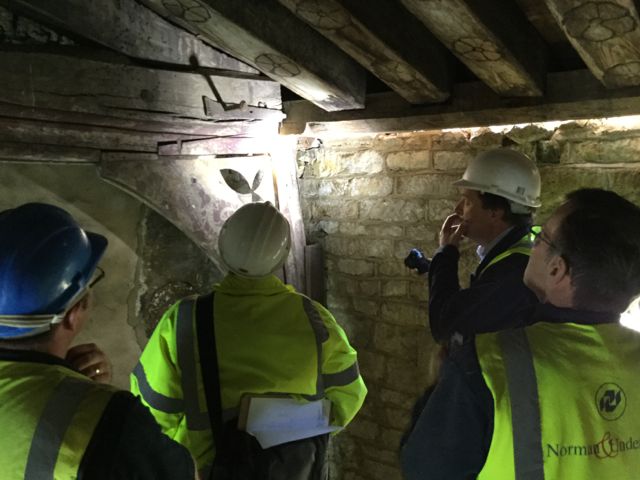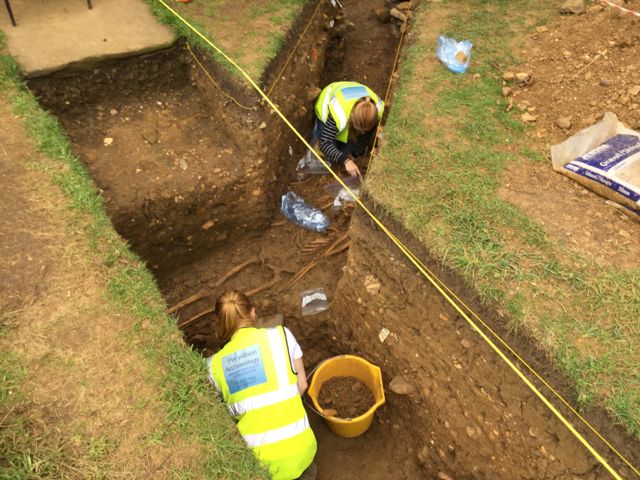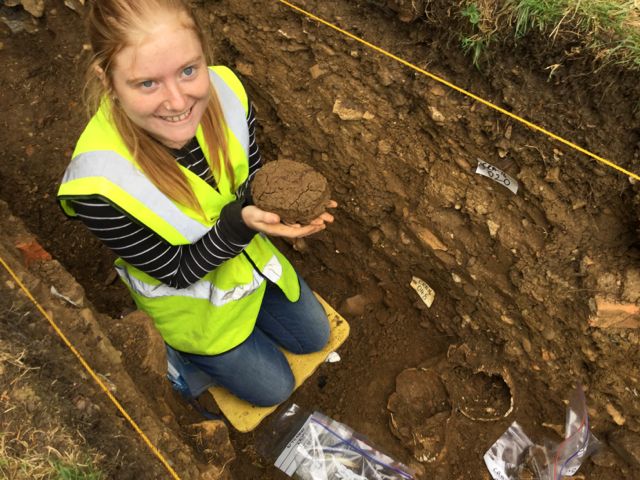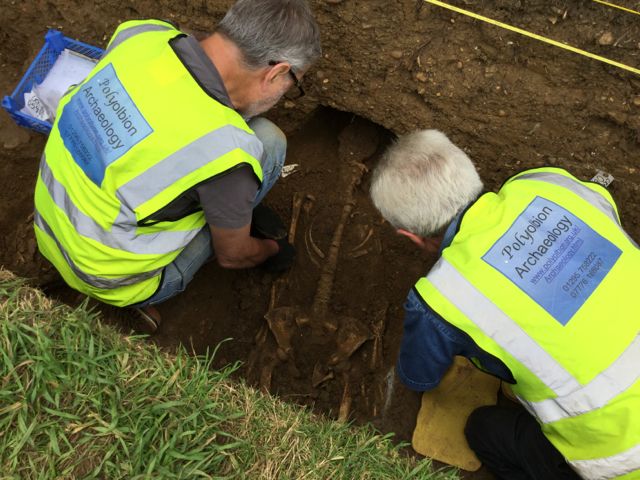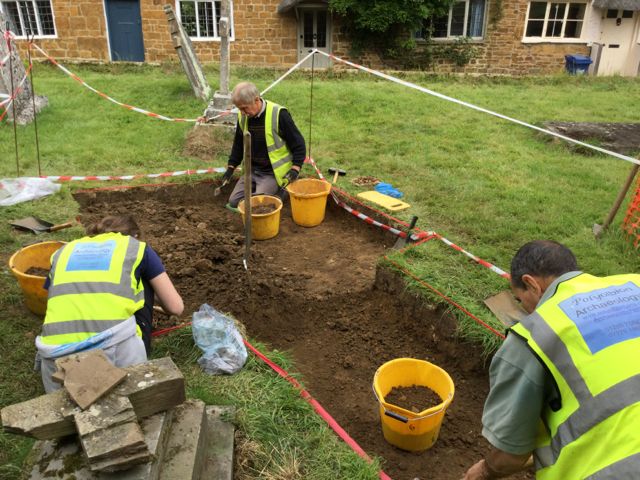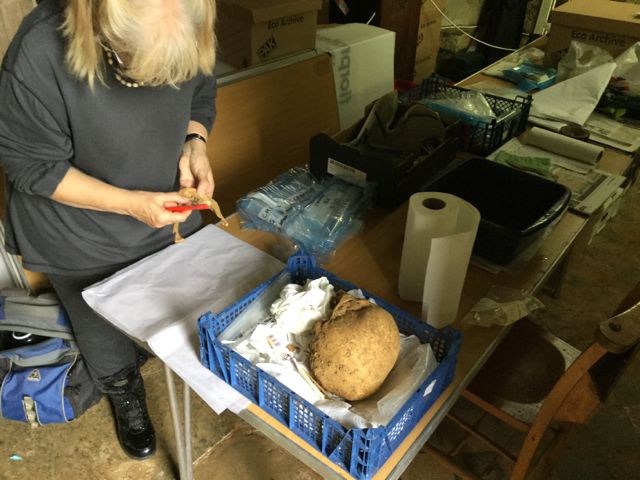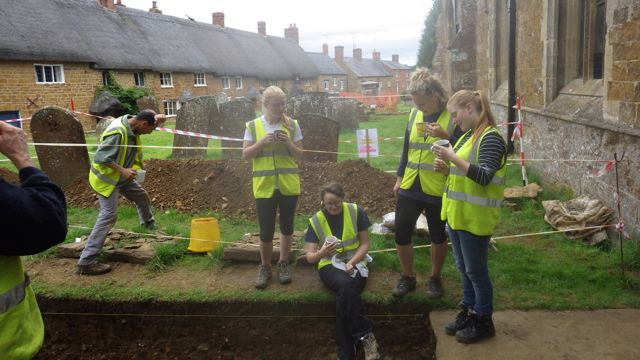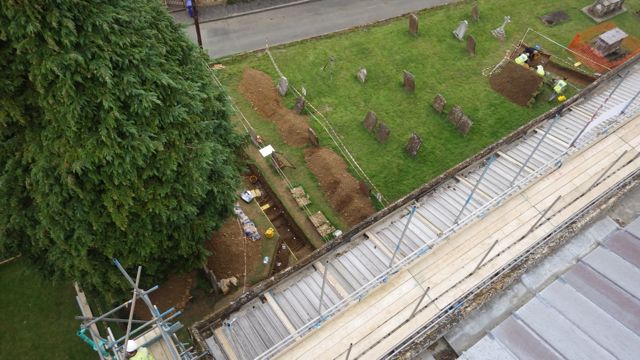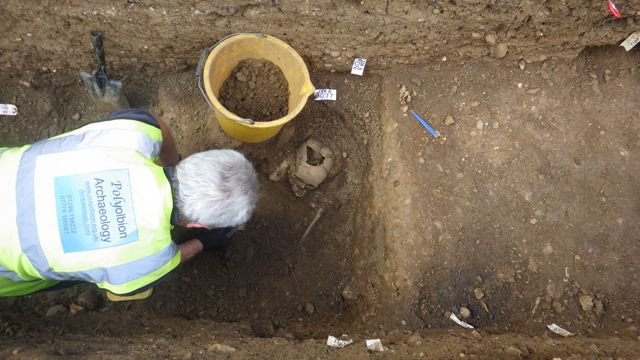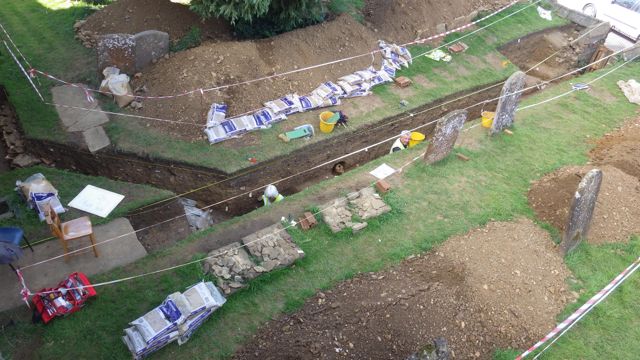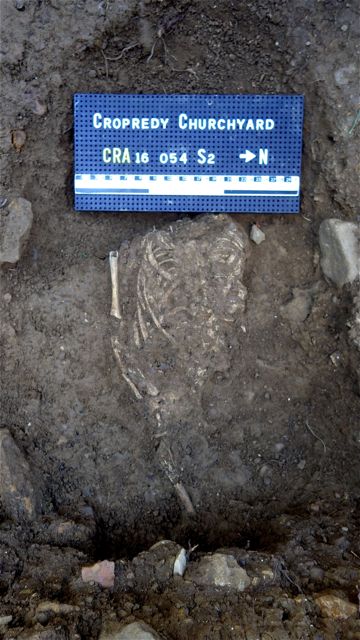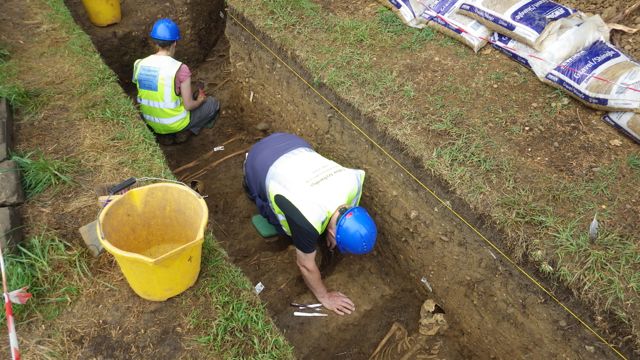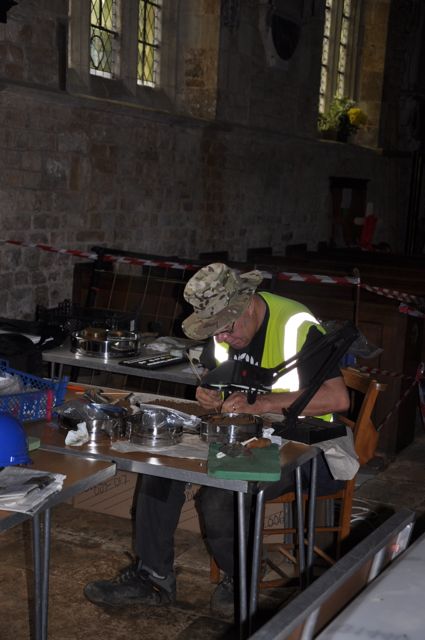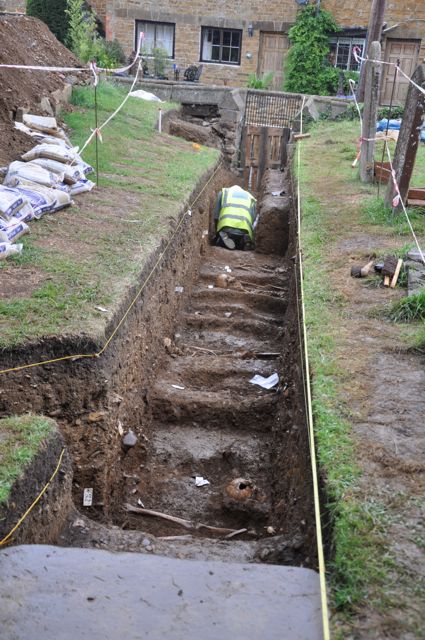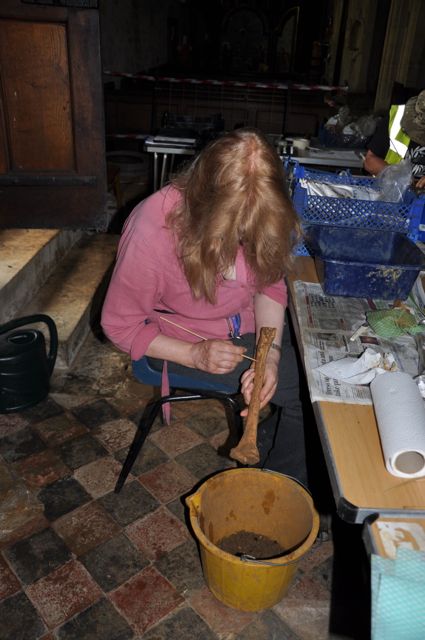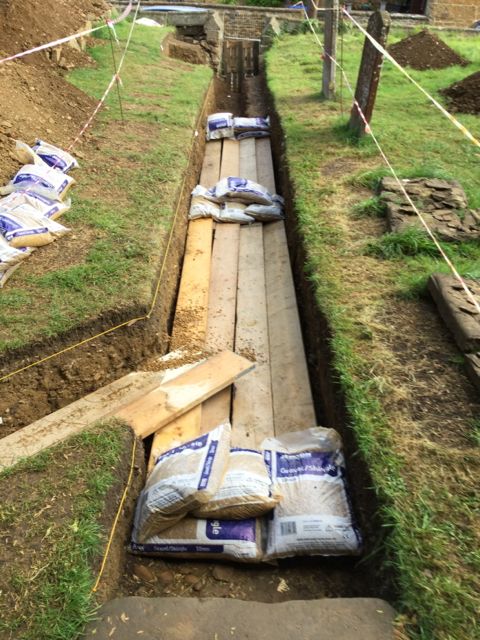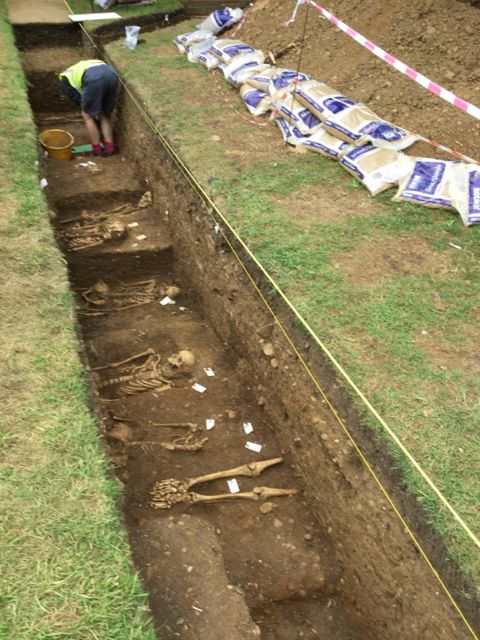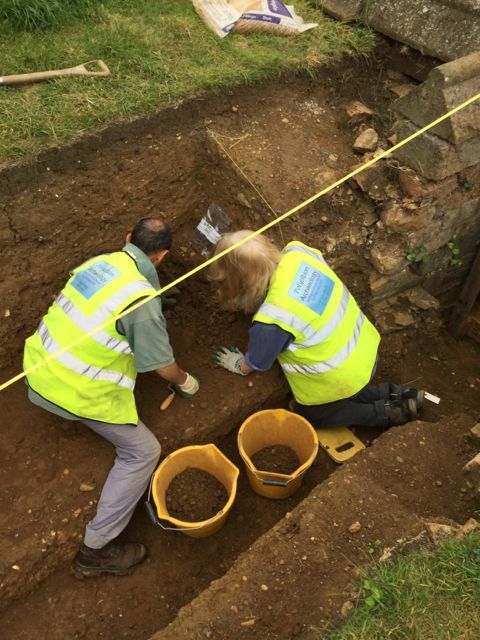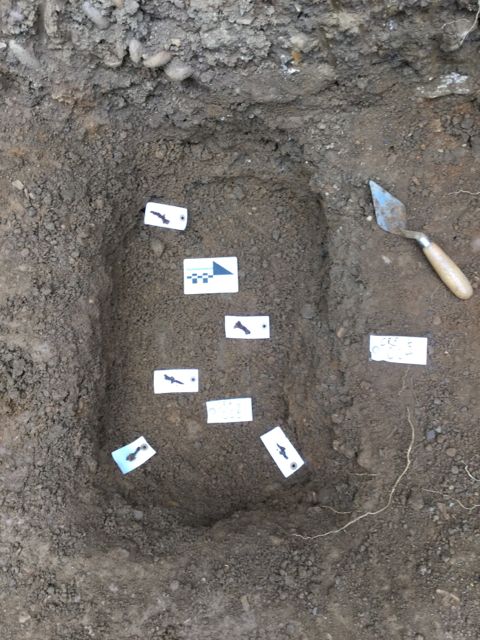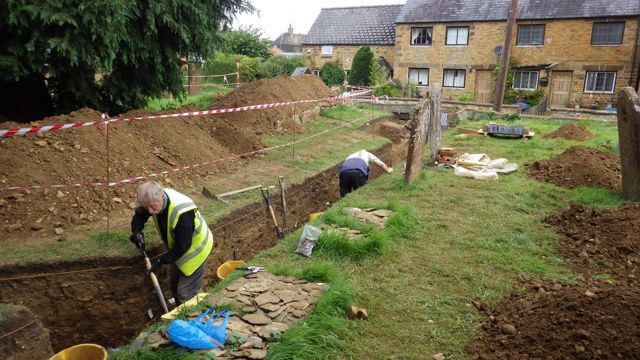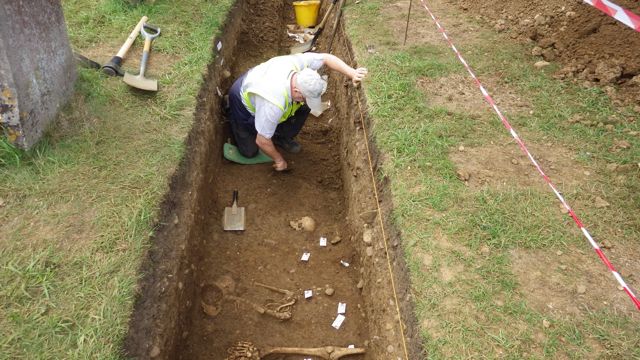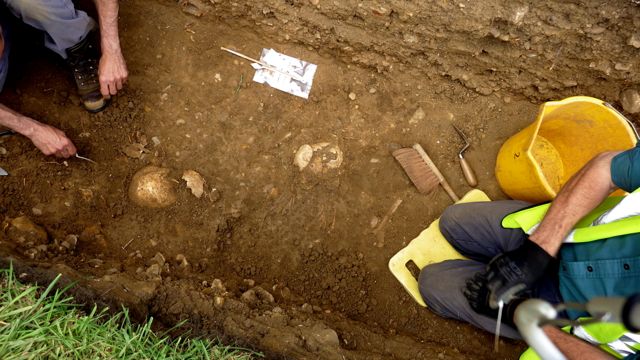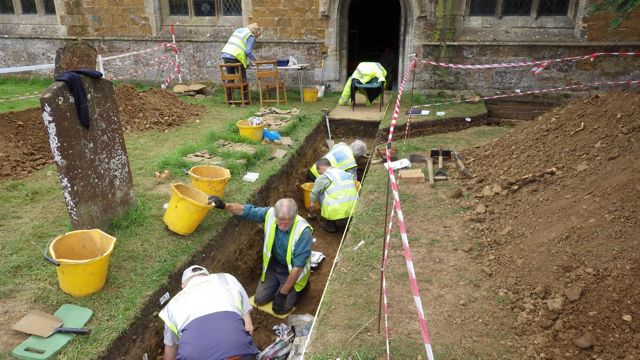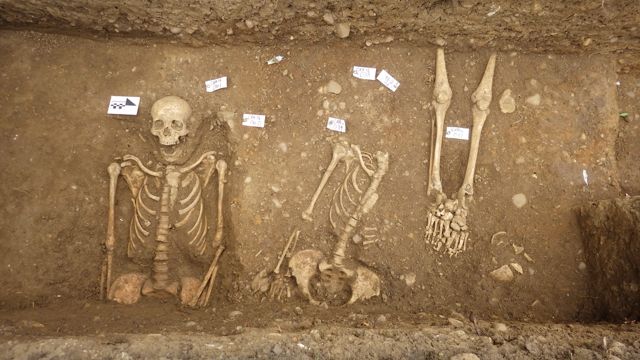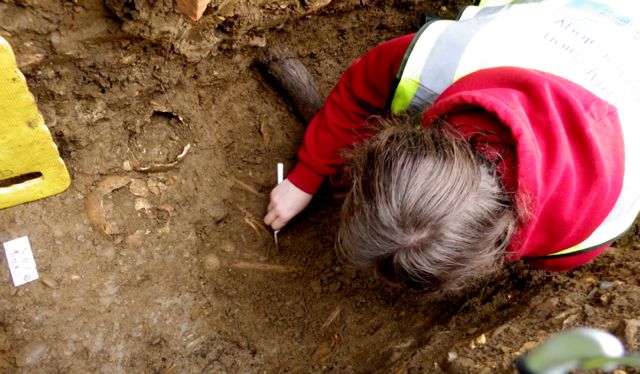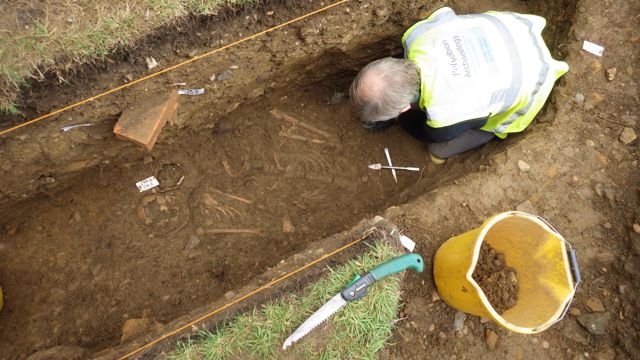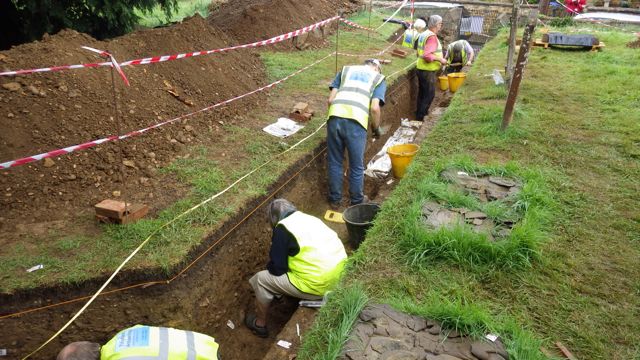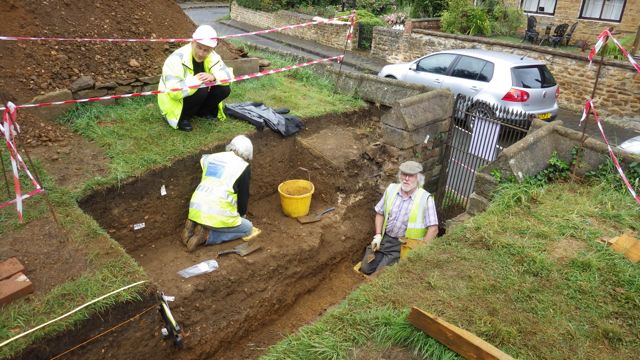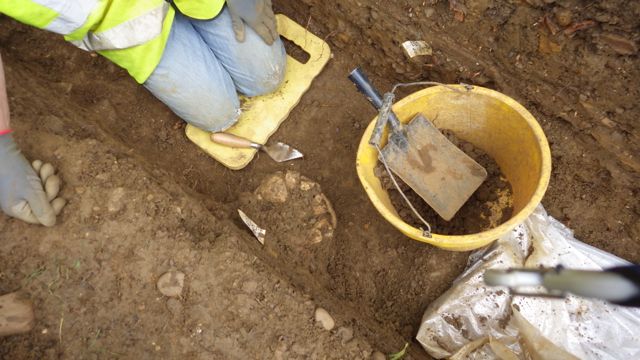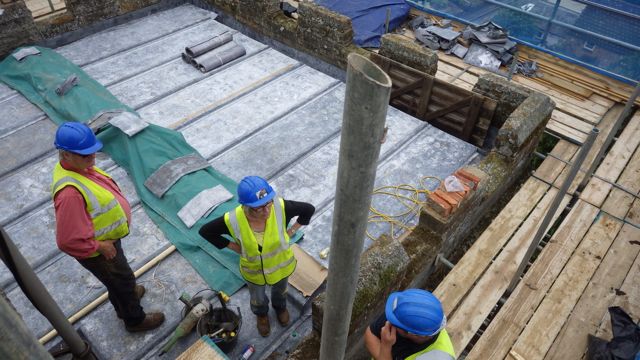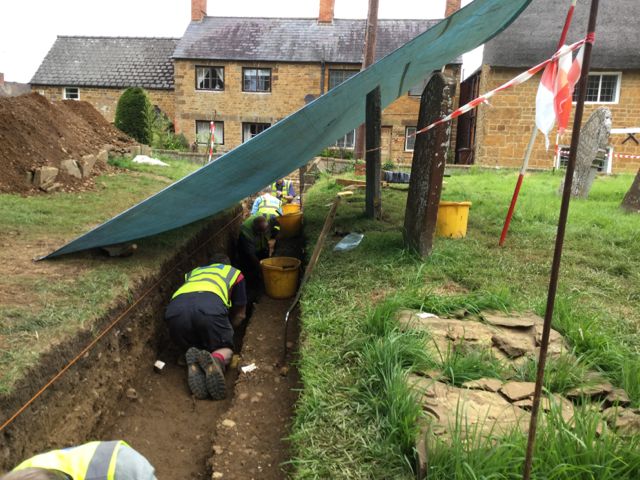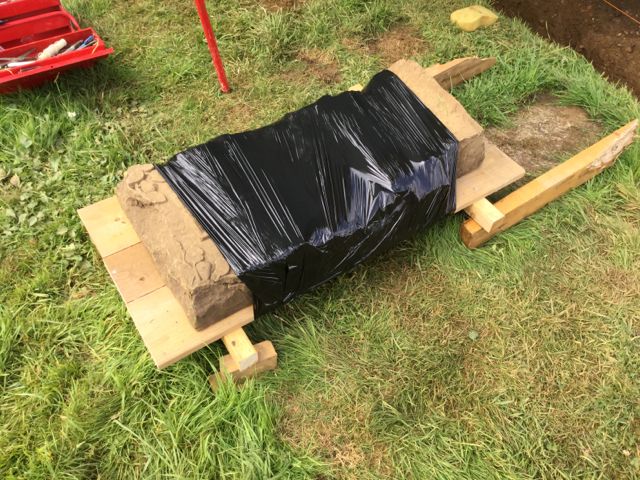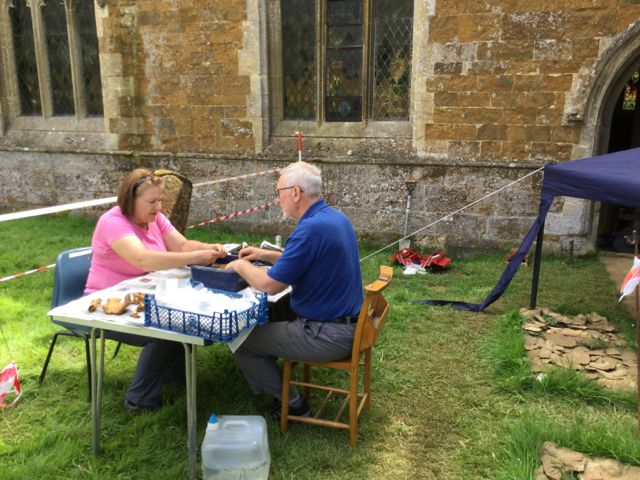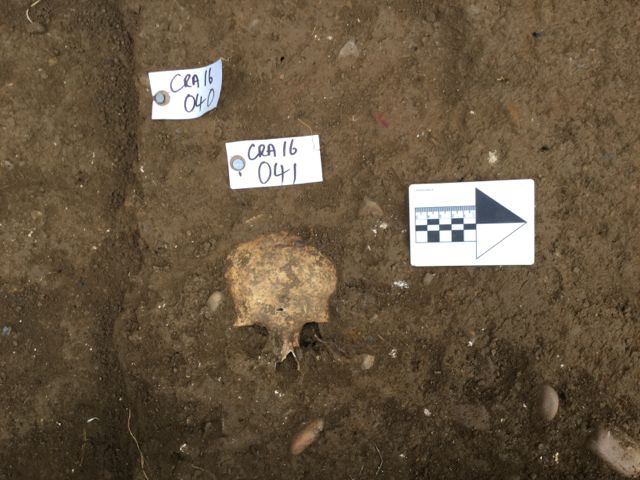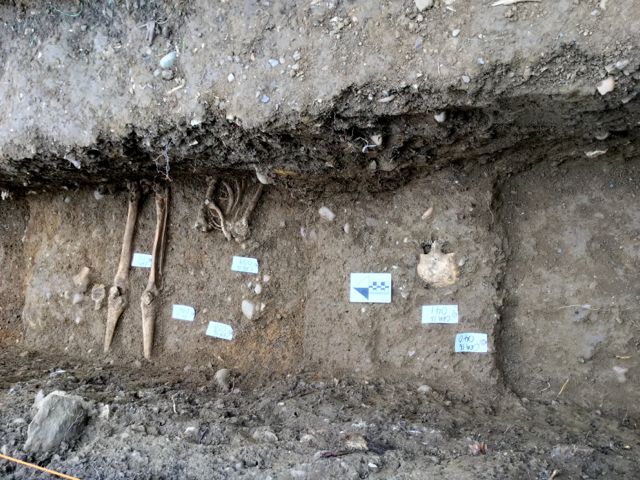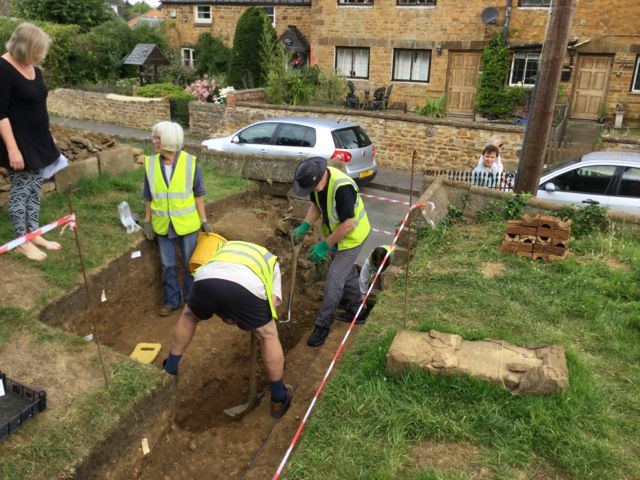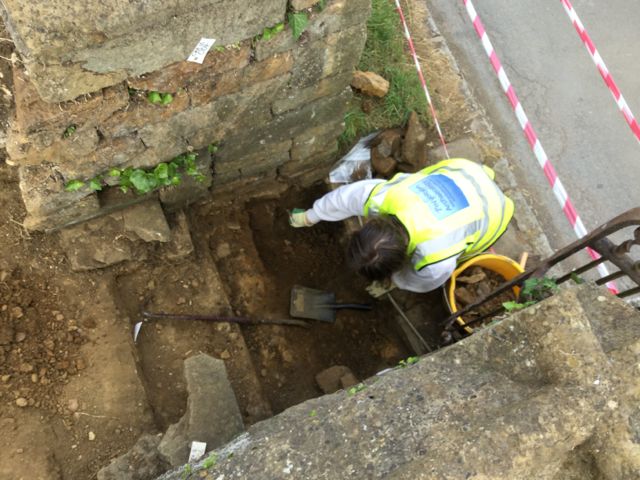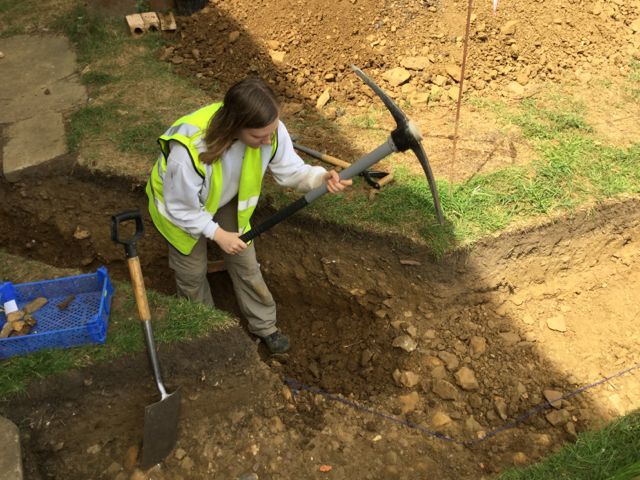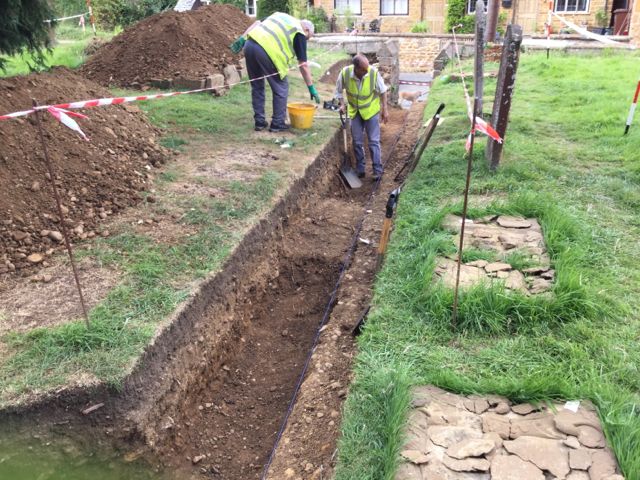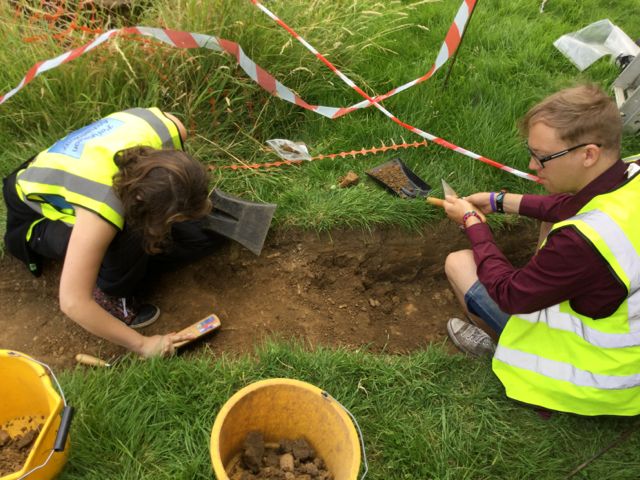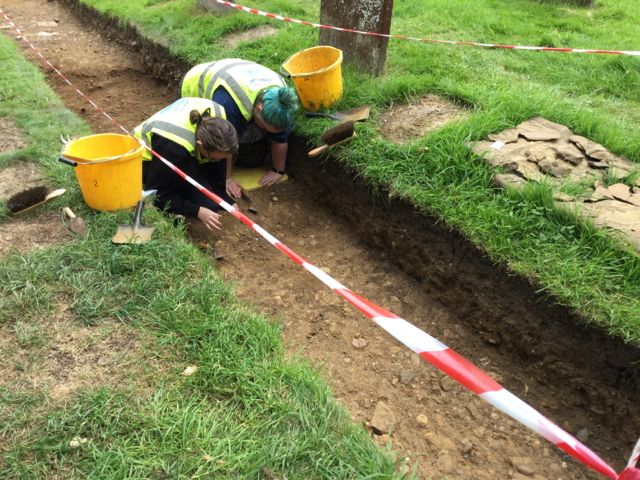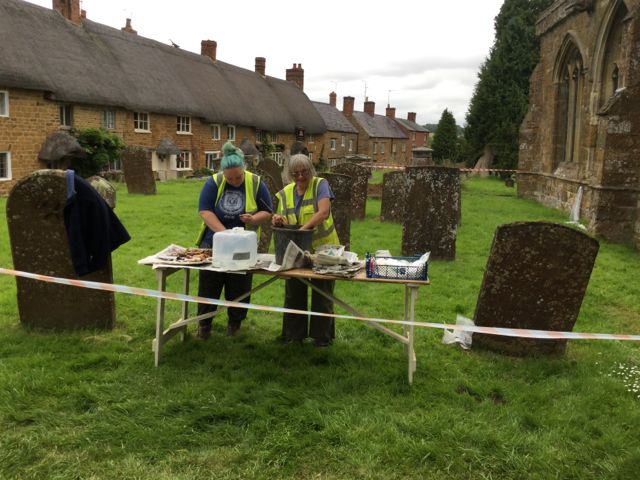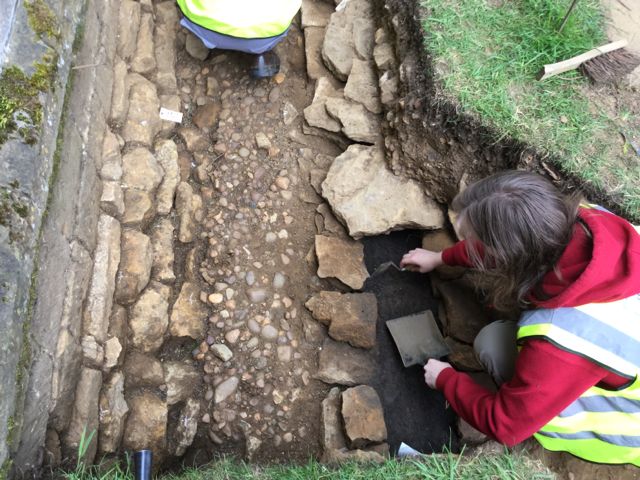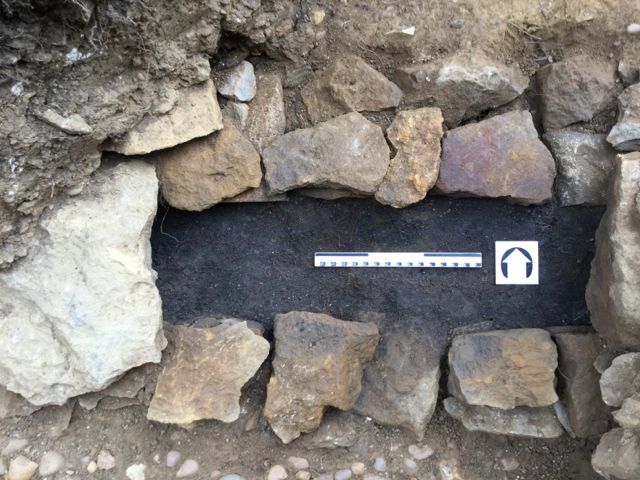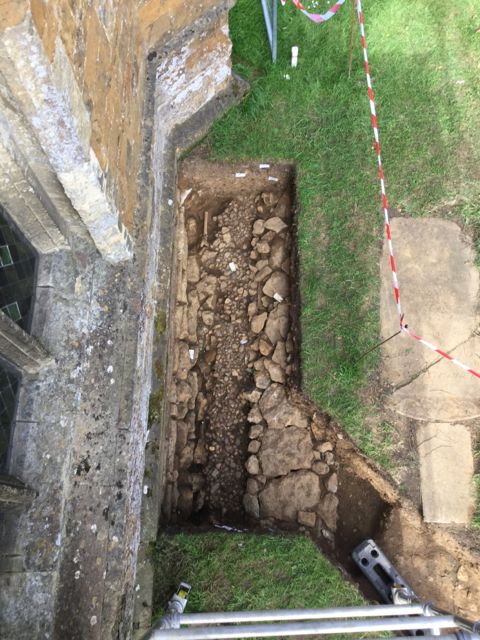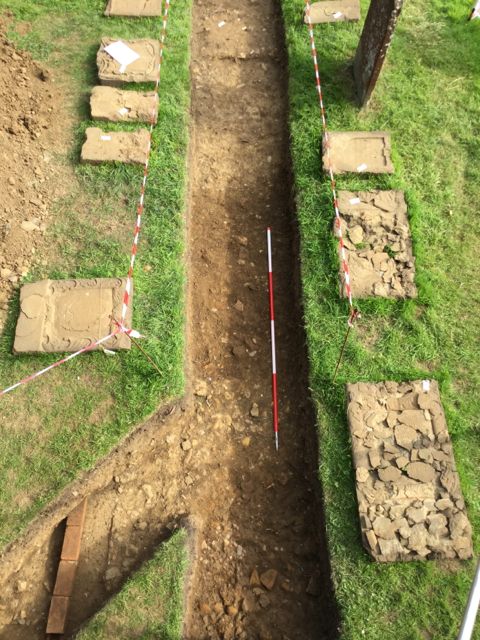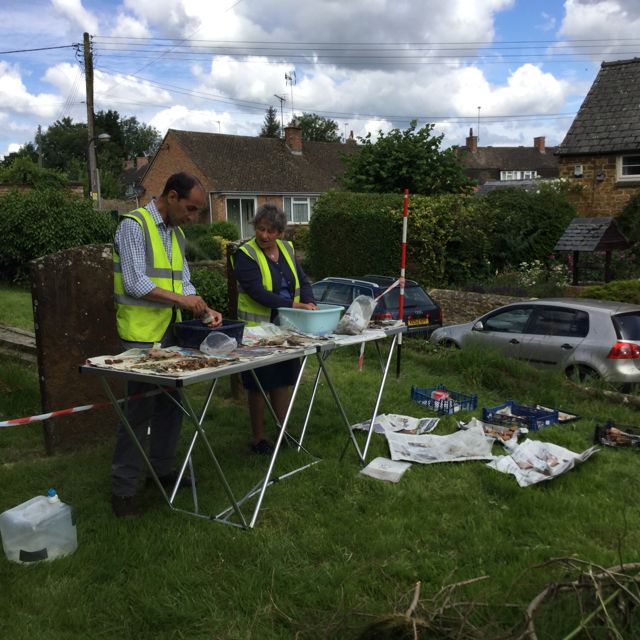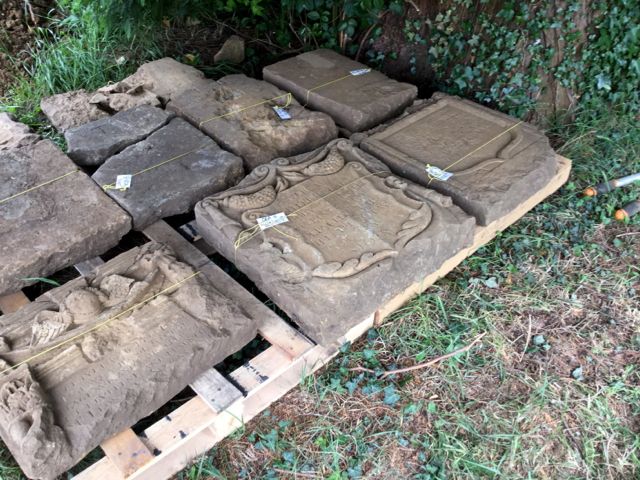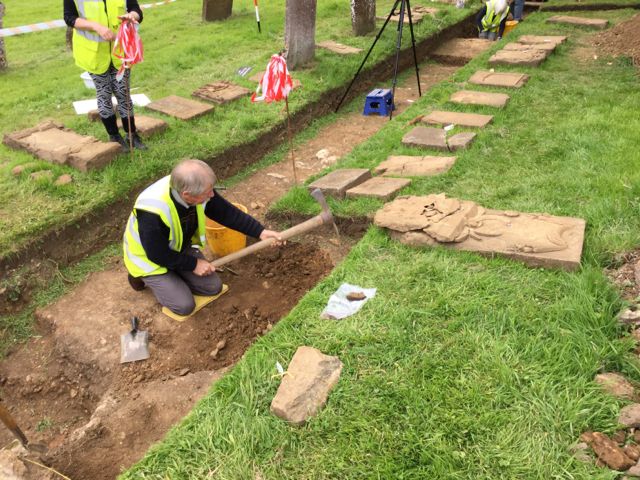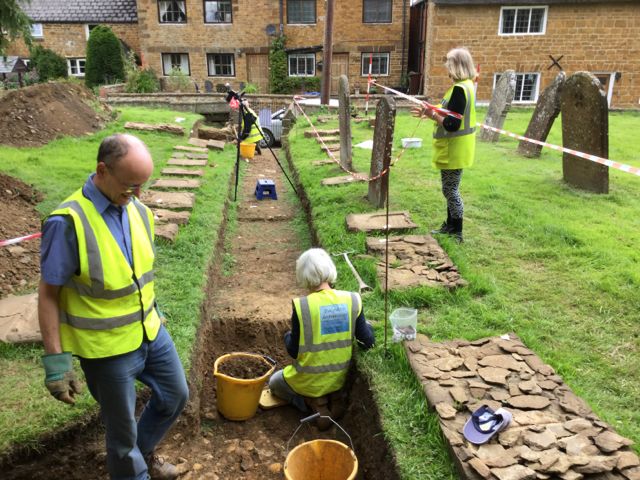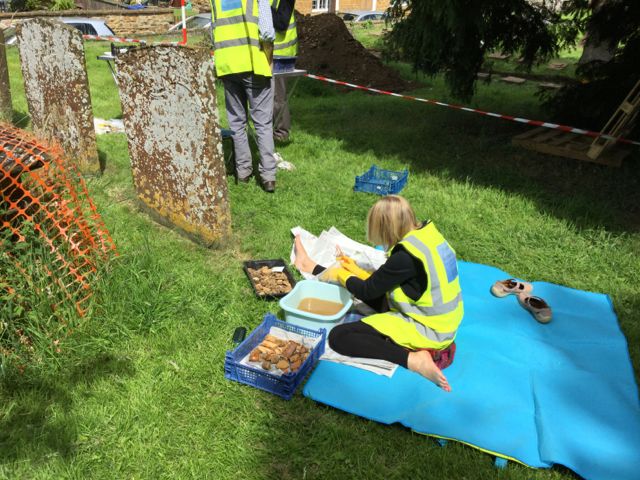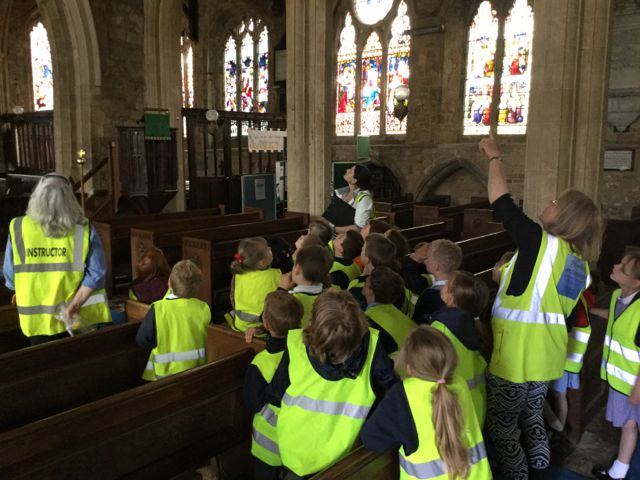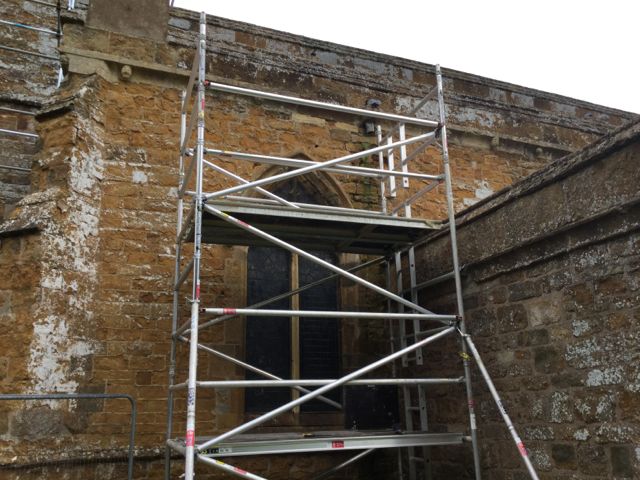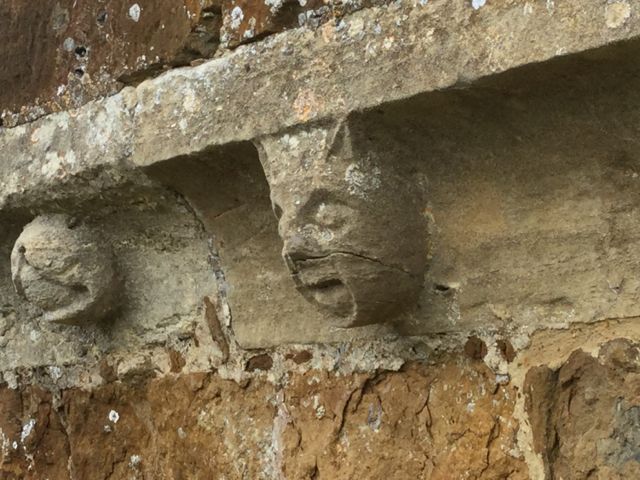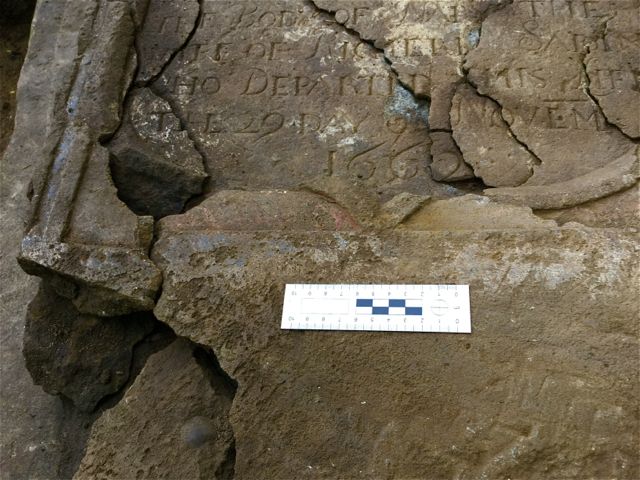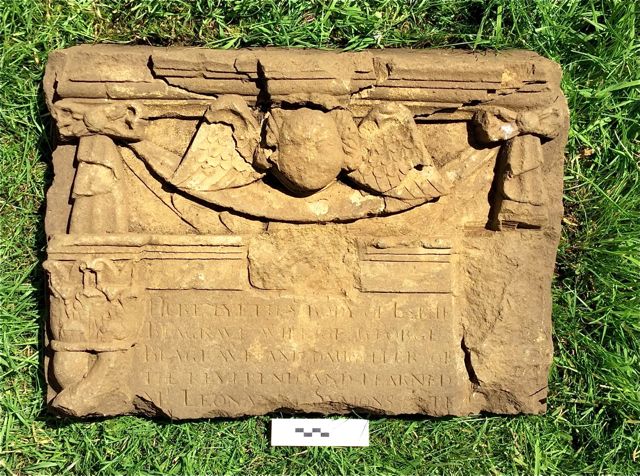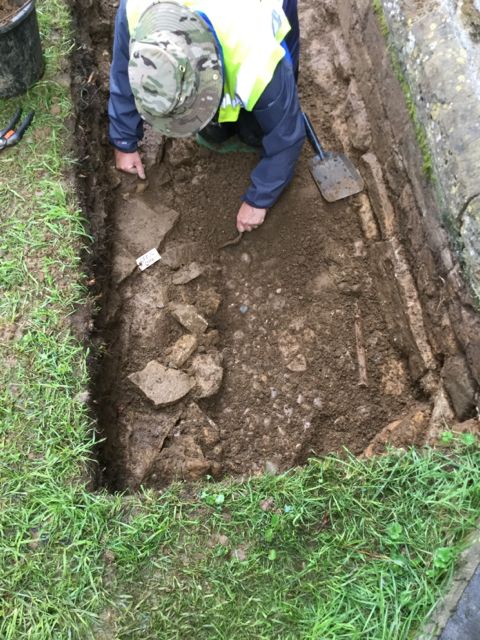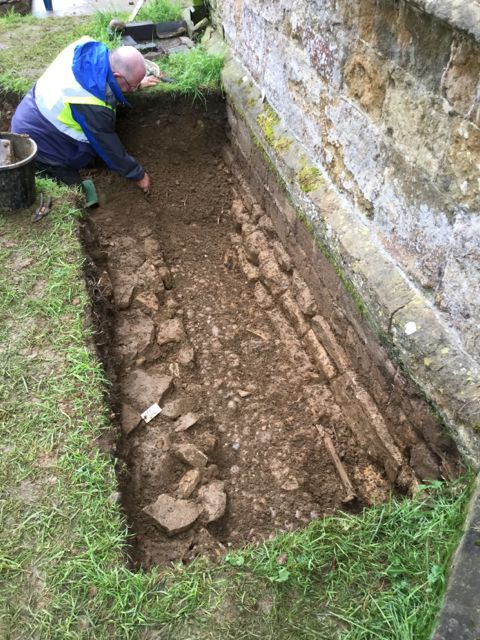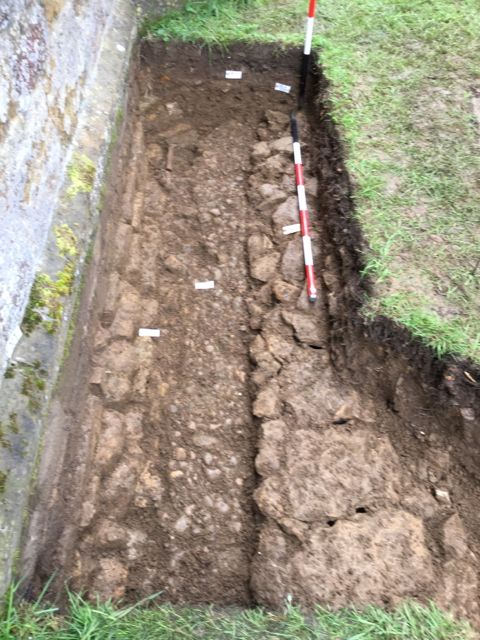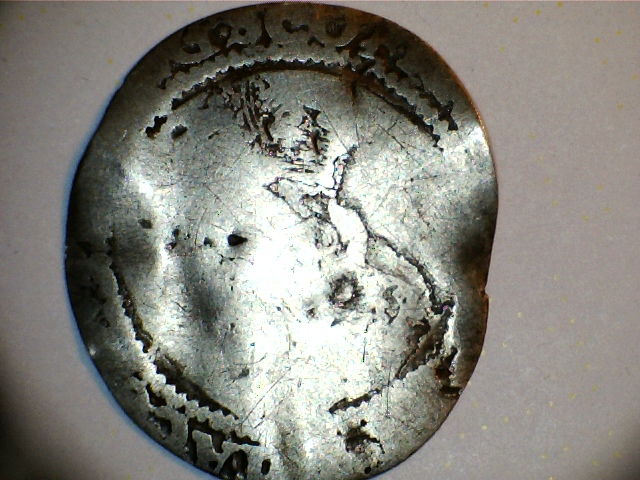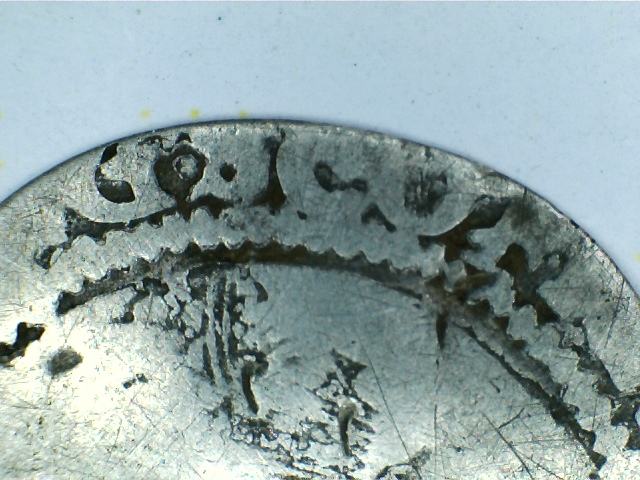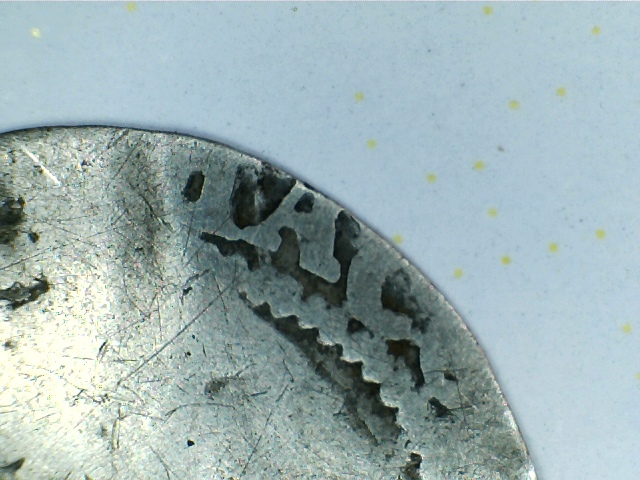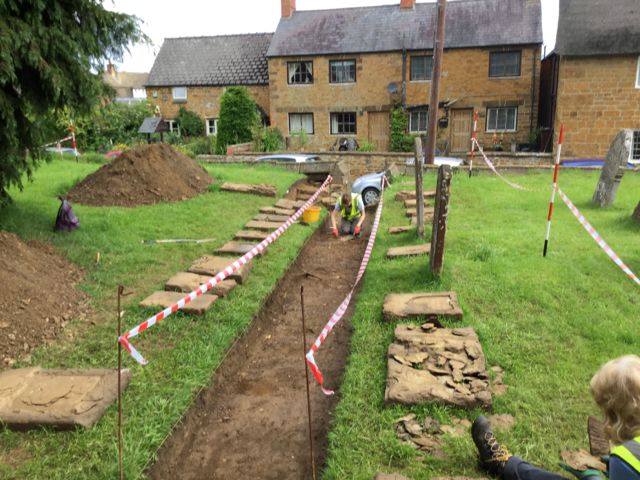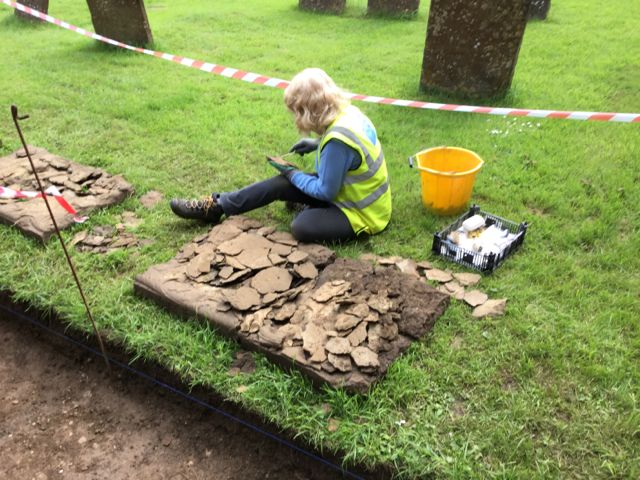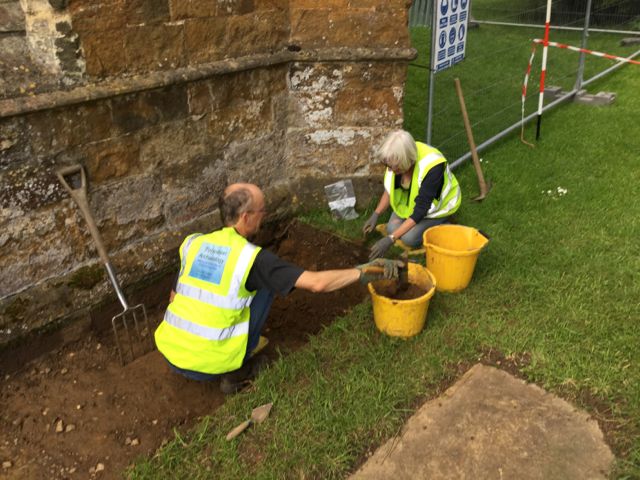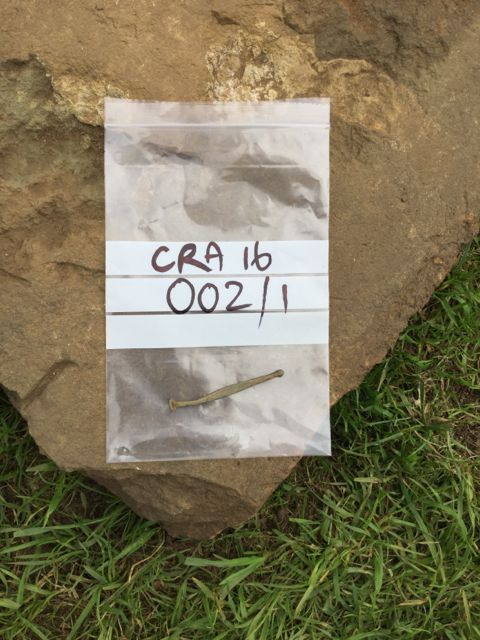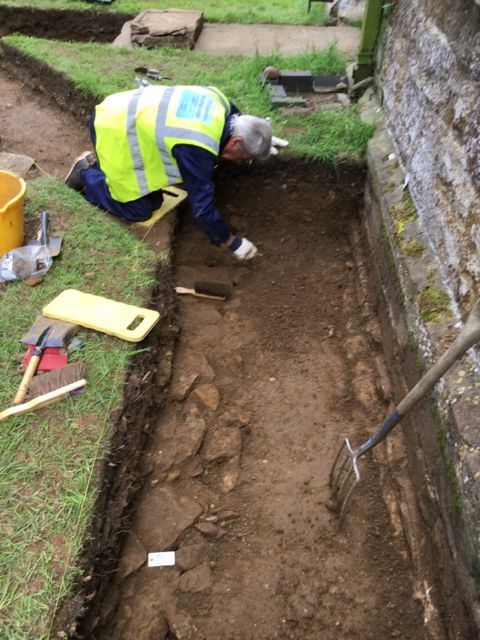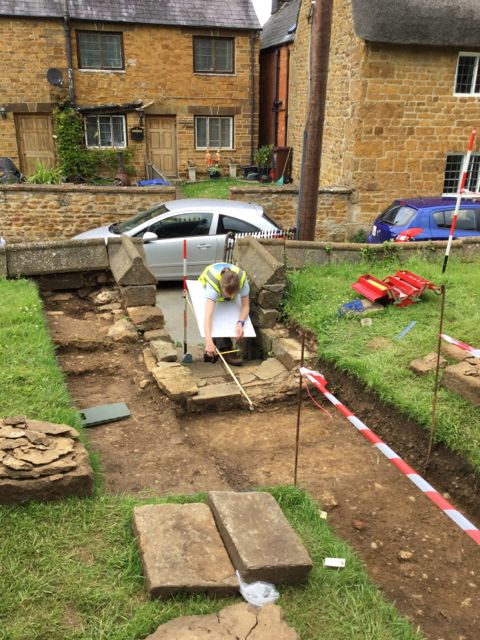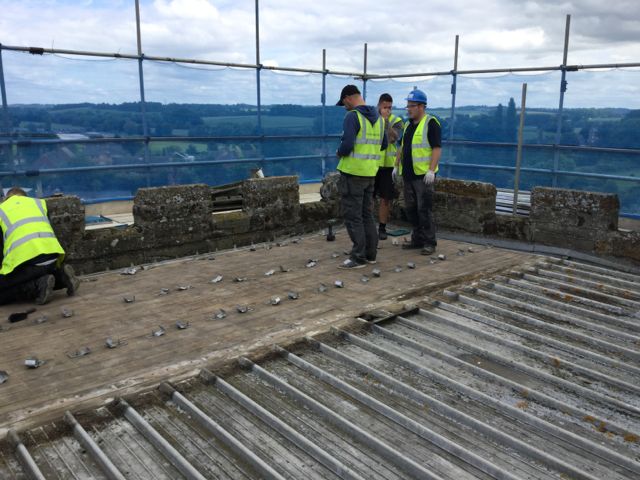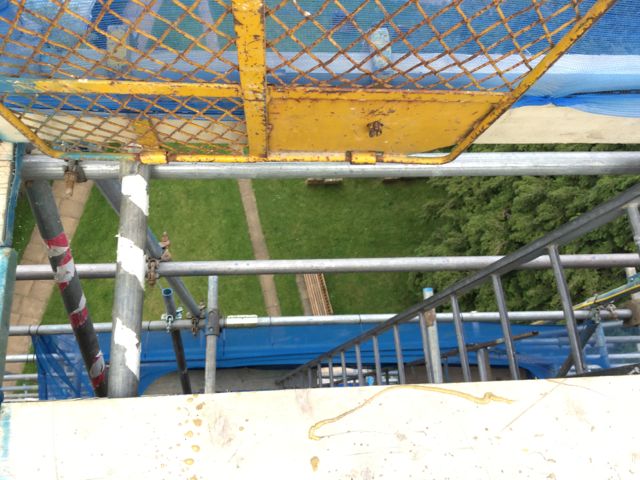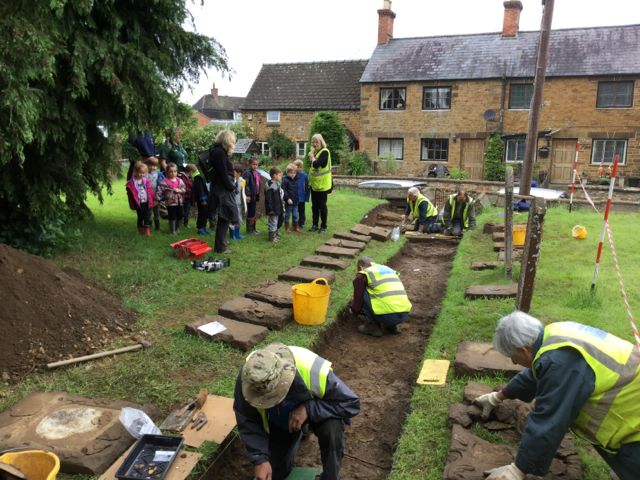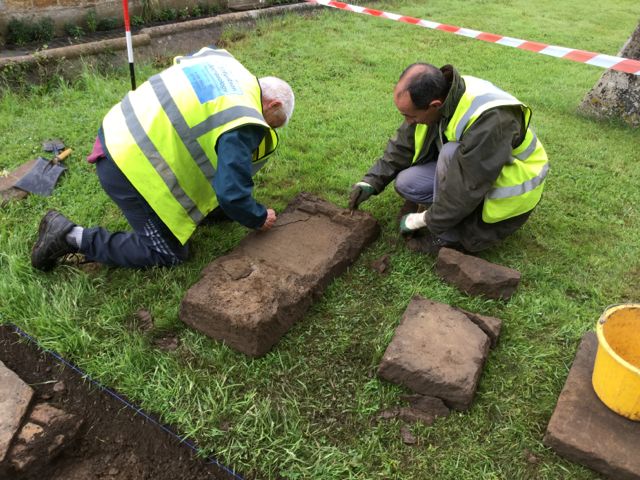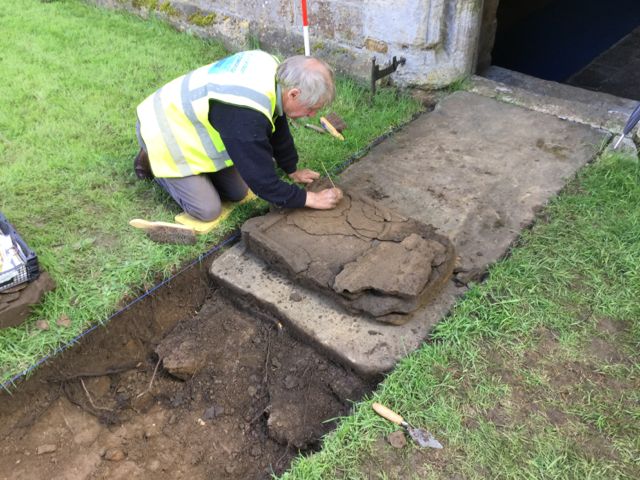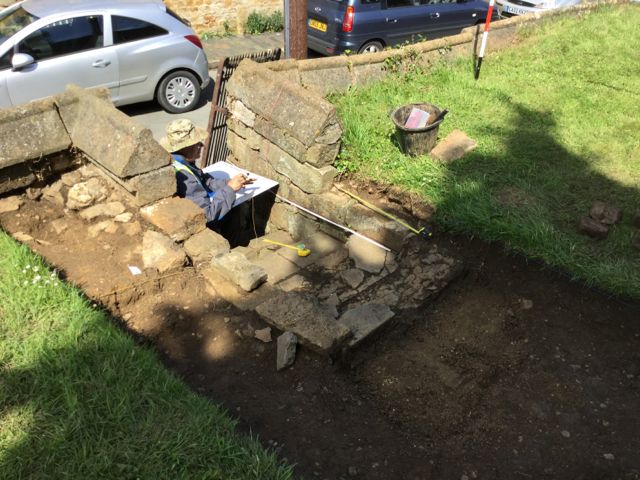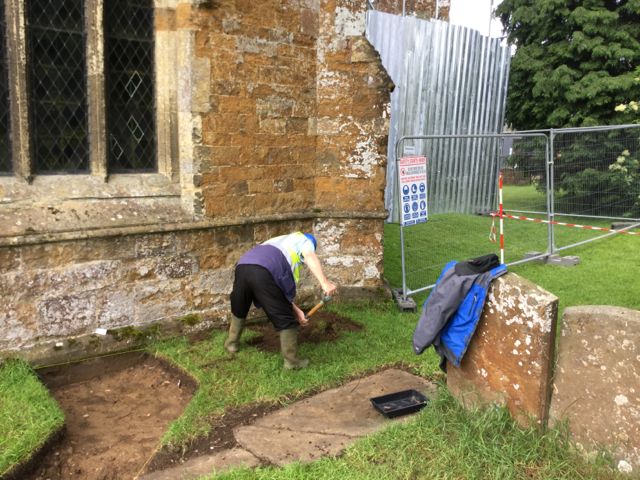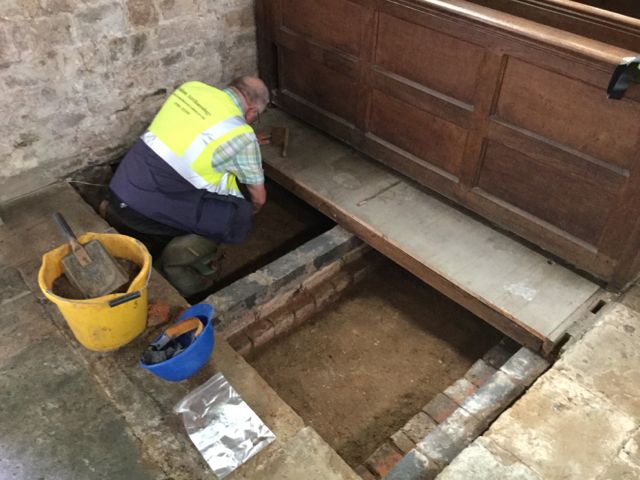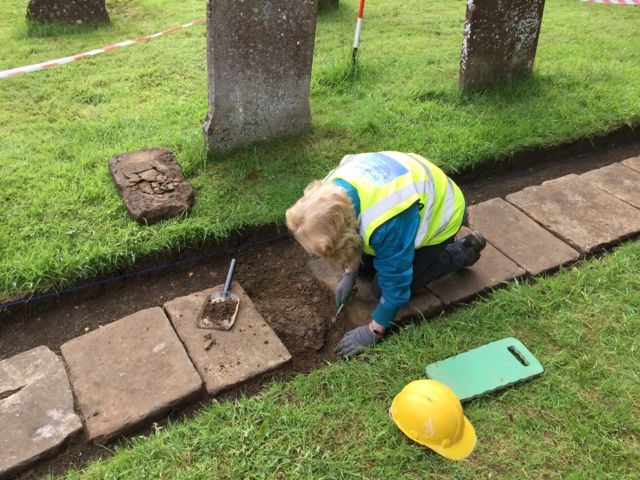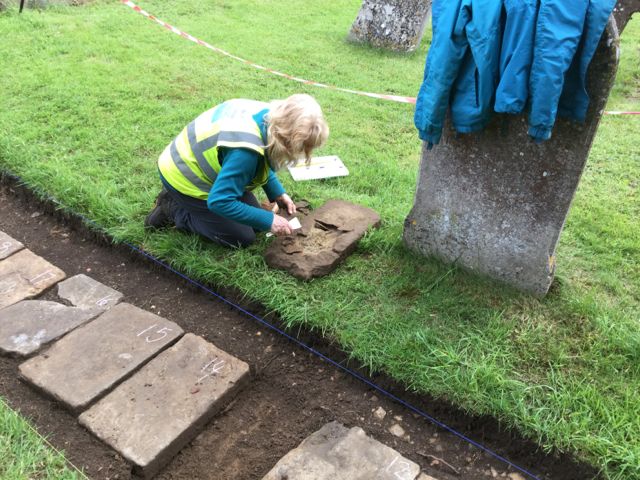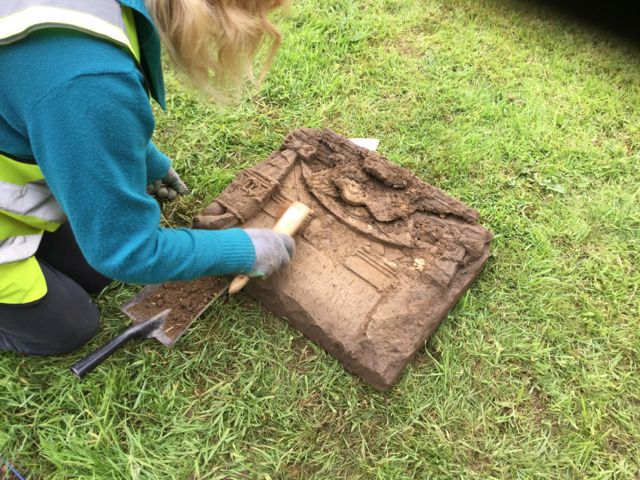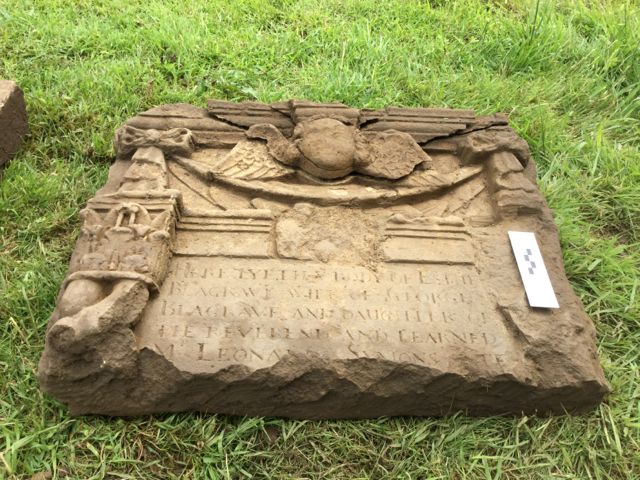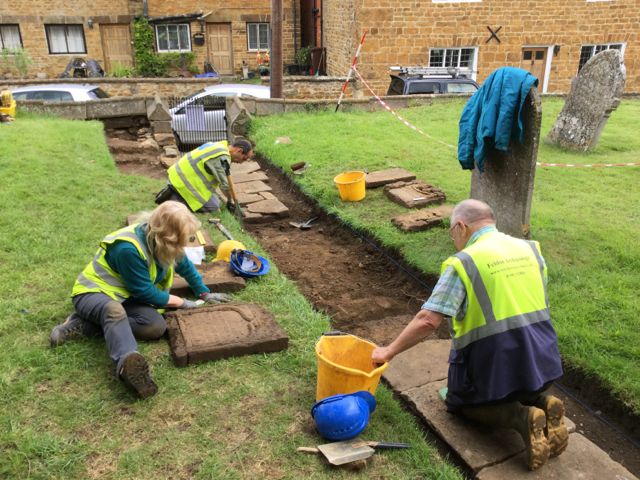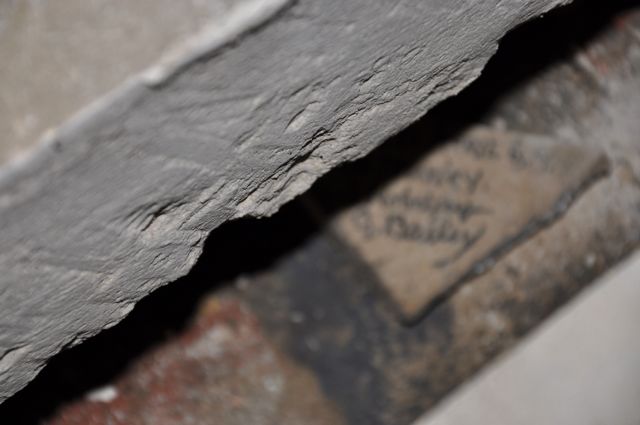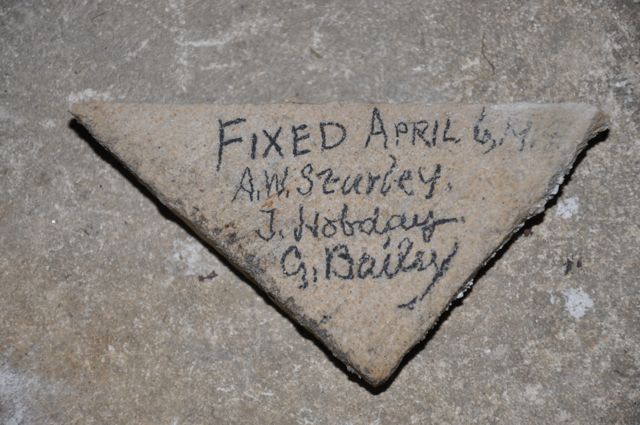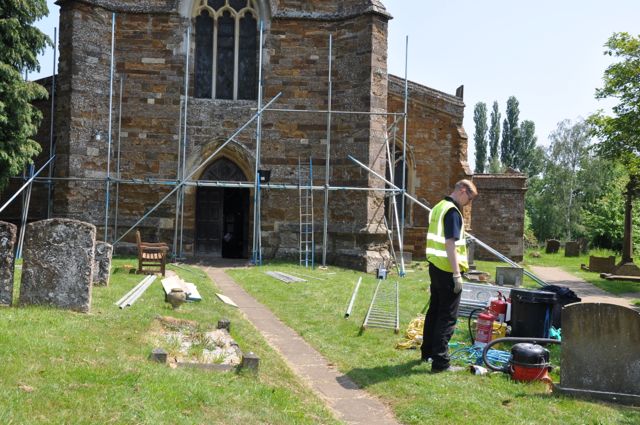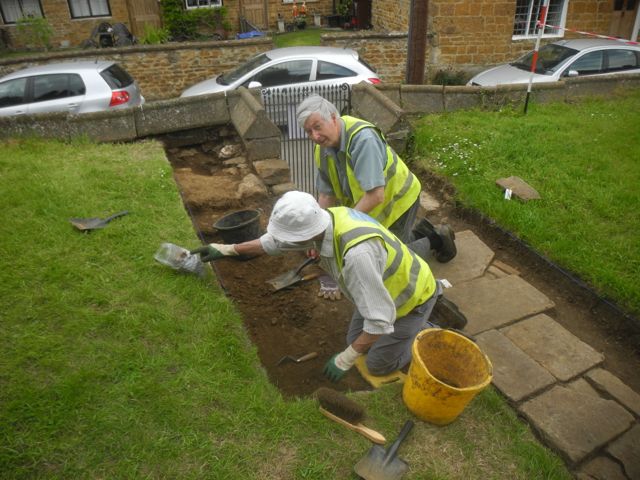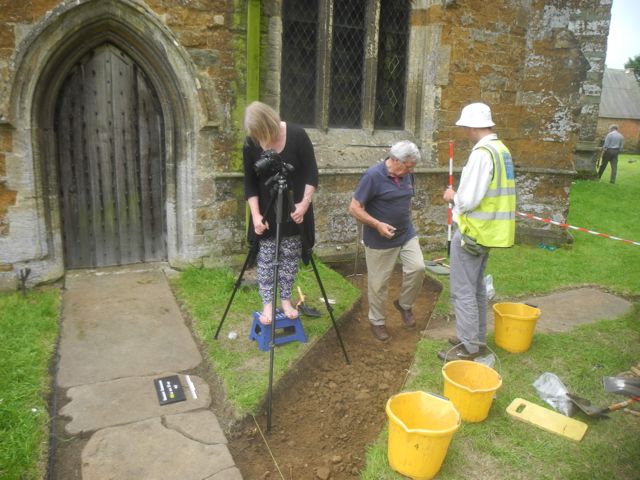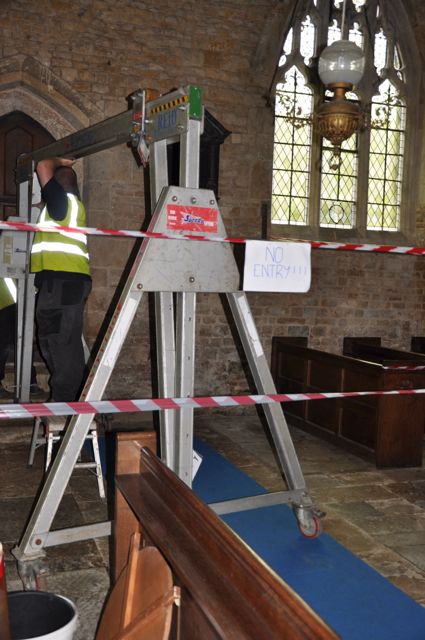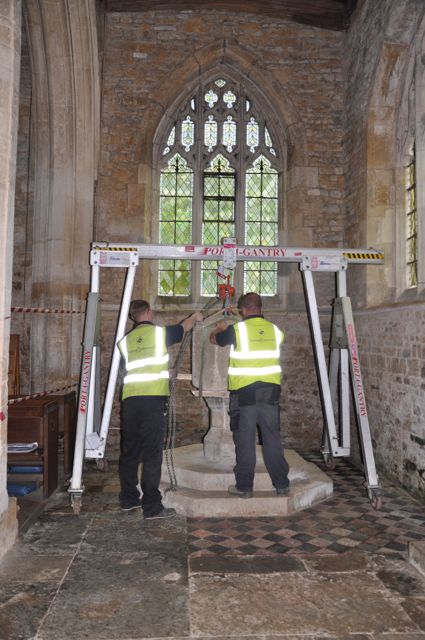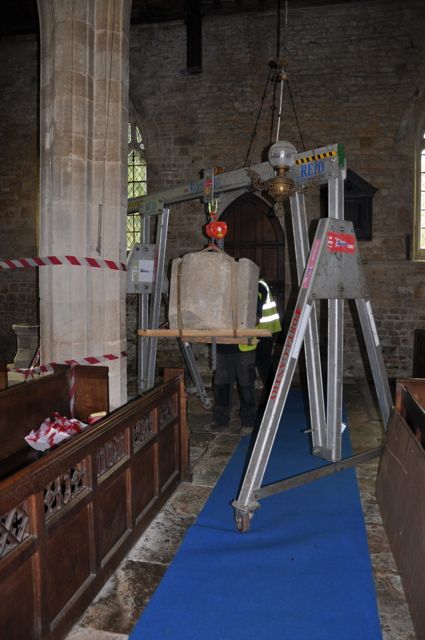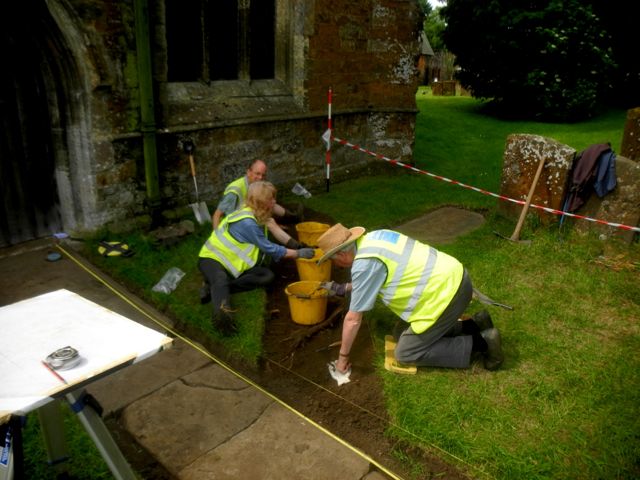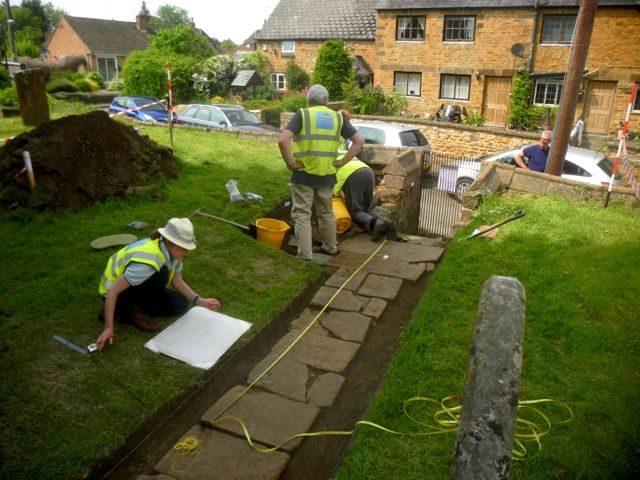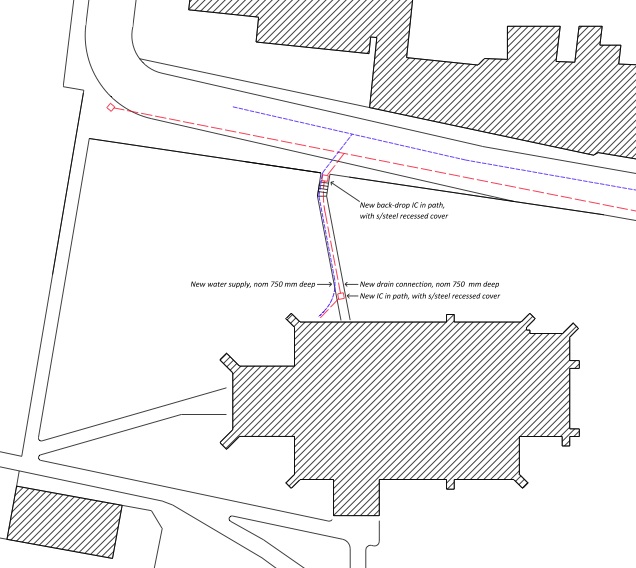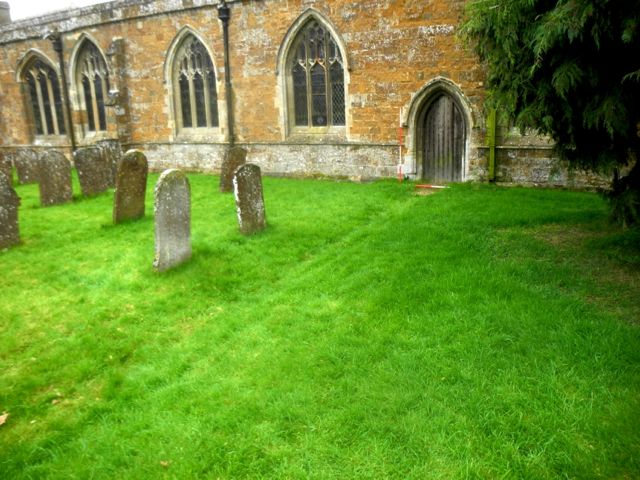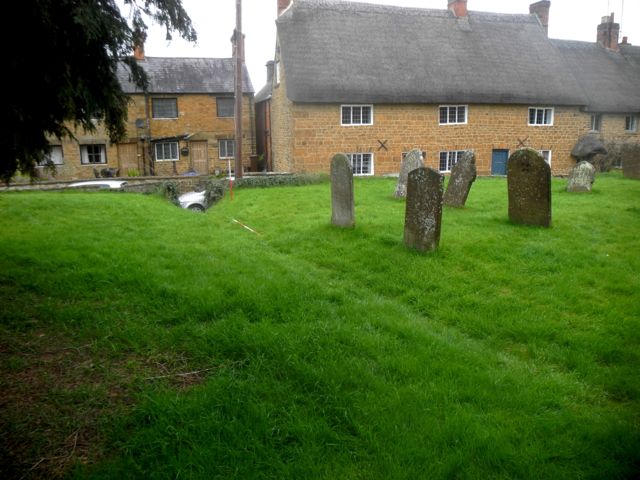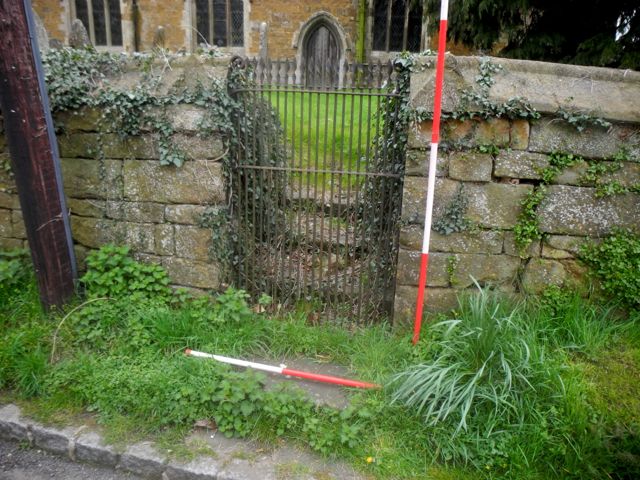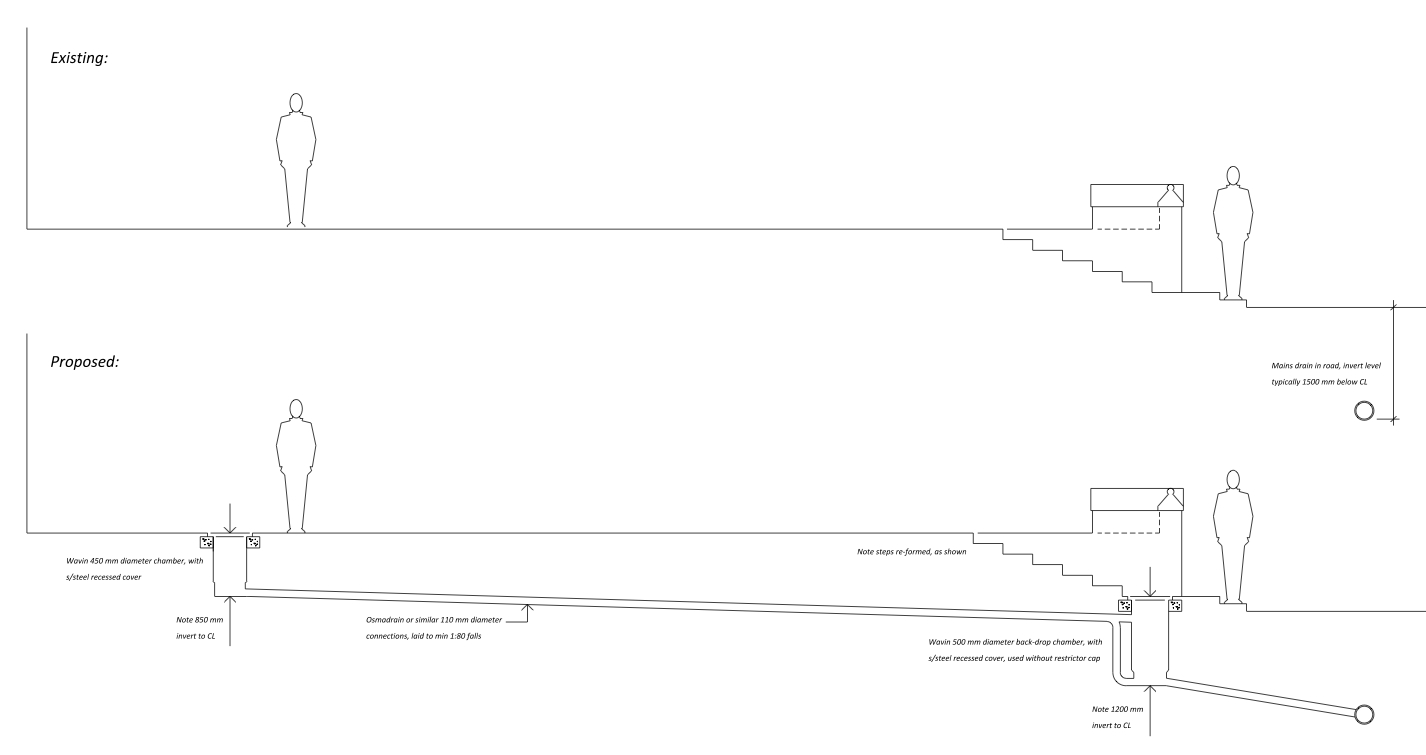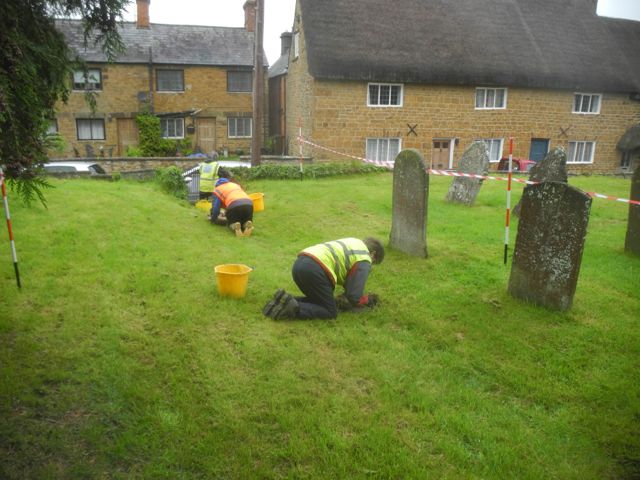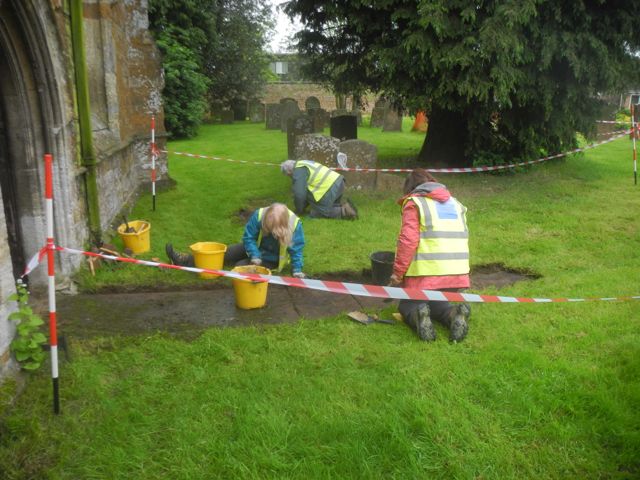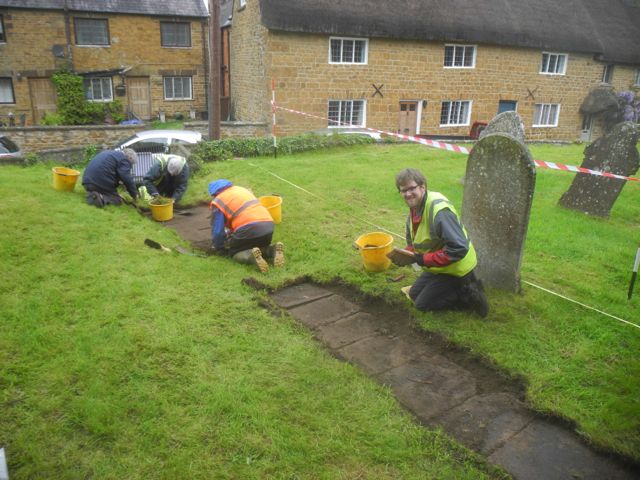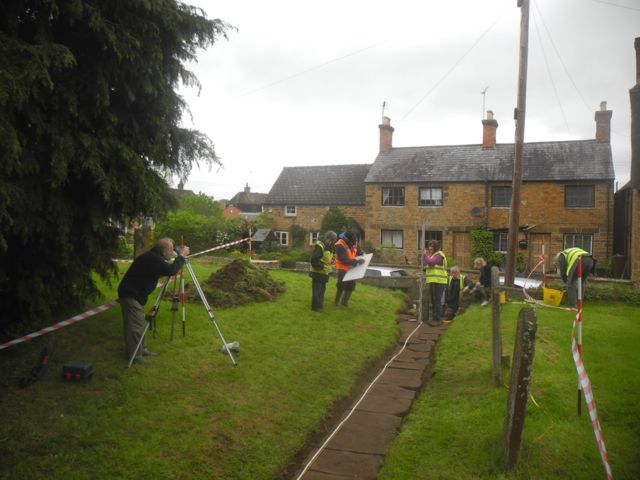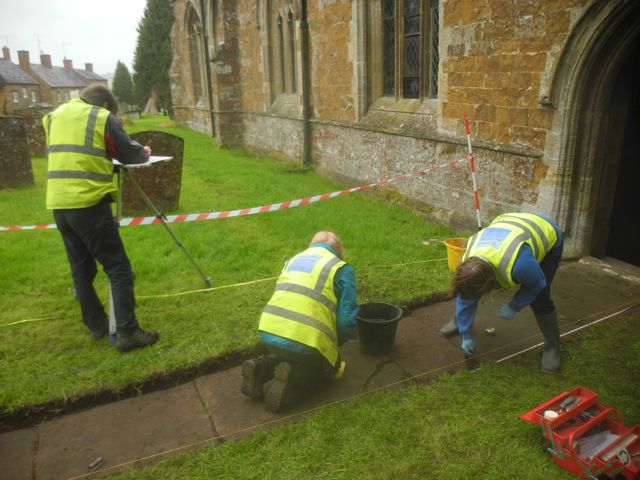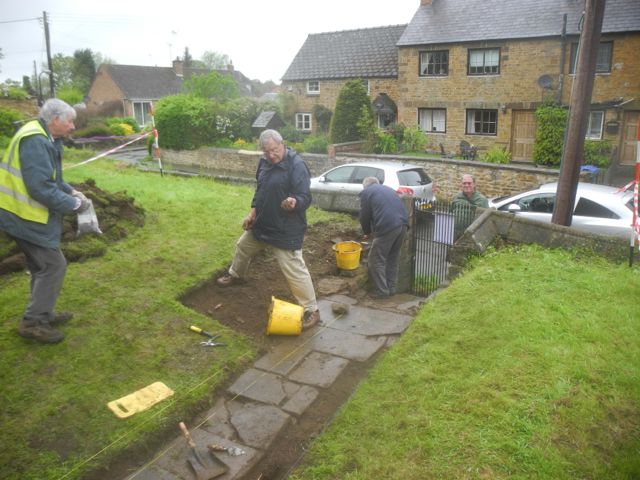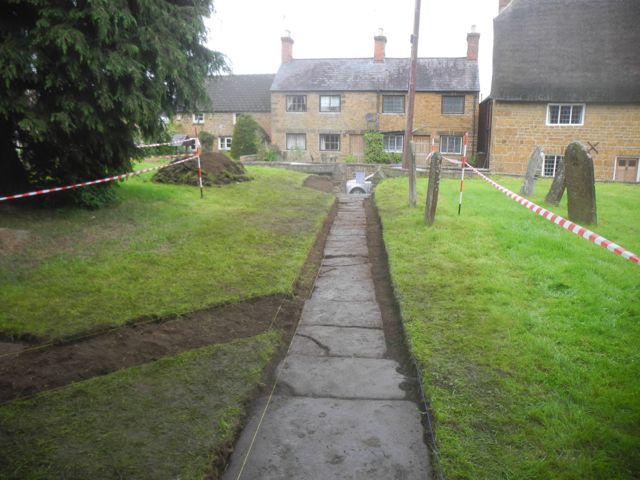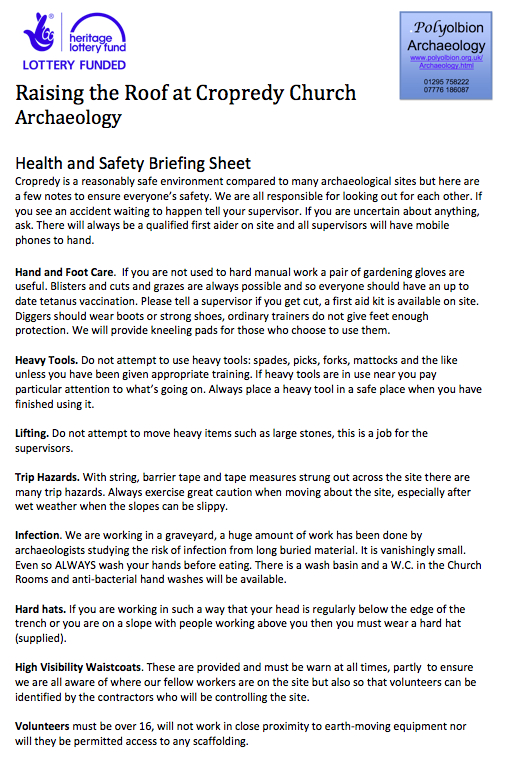MONDAY OCTOBER 17th. to FRIDAY OCTOBER 28th.
A very busy couple of weeks which I've decided to run together to tell
the story of the final stages of the excavation as well as relating
roof top developments. The contractors were charged with starting to
dismantle elements of the roofing structure which had meant more
scaffolding and the removal of some earlier repairs that had been made.
This in turn meant it was important to record the fittings and fixtures
on each roof truss before the work began, lots of photography. We also
had to mount expeditions up the outside scaffolding to view the insides
of a number of seriously rotted timbers.
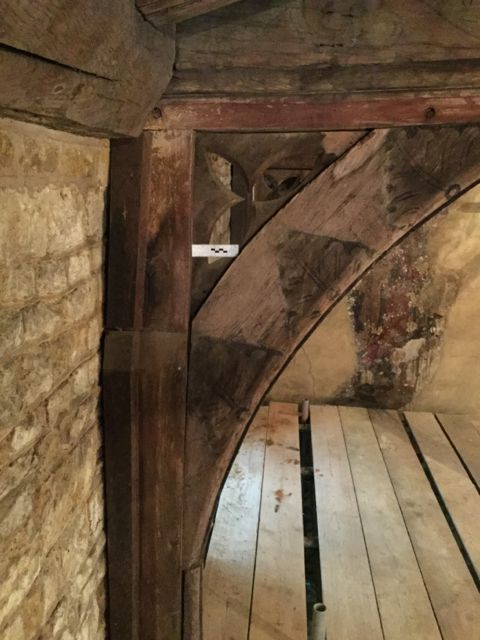
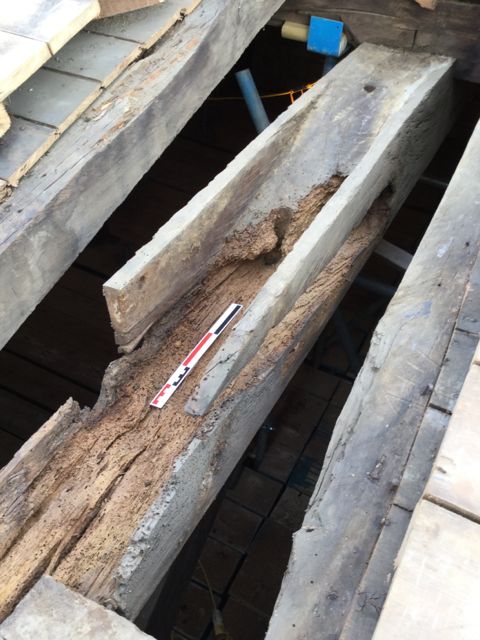
Woodwork: truss five showing the painted decoration and the
outside of truss three on the south side showing how little sound wood
remains
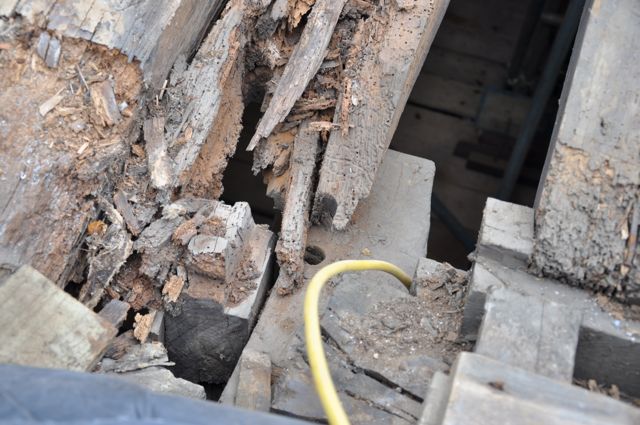
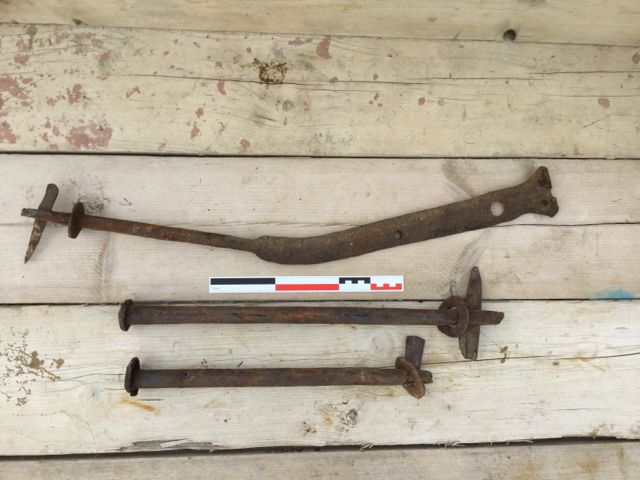
An even worse example, there's no weight bearing element to this
beam at
all!
A selection of the hand forged bolts and fixings removed whilst taking
apart earlier repairs.
Back in the trench following a lot
of research into the mysteries of iron coffins our hopes were about to
be dashed. Once excavation of the fill of grave CRB16/015 began in
earnest it became clear that what we had was a series of iron backing
plates for the coffin handles which had corroded in such a way as to
create the effect of continuous sheets of iron on the inside face of
the coffin. That was not the case, furthermore the iron sheets that had
dropped down on to skeleton were not from an iron lid but from a pair
of deposita, the technical term for decorative and name plates often fixed to the lids of nineteenth century coffins.
Oh well, we all learn as we go along. the excavation of the deposita in
particular had to be dome with immense care as we suspected, rightly,
that traces of an inscription survived. Once the bones were
revealed there were more surprises in store. The bones had two notable
peculiarities. First of all the skull had no teeth at all, more than
that the sockets had grown over completely, or had eroded away, it's a
strange pathology which will need some study. Also the ribs defining
the chest cavity occupied a very narrow space, pathology again or very
severe corseting? One final surprise, as the skull was lifted a tangled
deposit of hair, laces and ribbon with a couple of copper pins was
revealed, could these be the remains of a bonnet? An preliminary
examination of the pressed iron plate from the abdominal region
revealed the letters prompted an initial reading of R*THY and so we
named her Dorothy. if we can recover the full name we should be able to
link her to the burial register and provide some more biographical
detail.Work continued to define, record and remove the remainder of the
burials affected by the central square metre which would be taken down
to the full depth of the soak away.
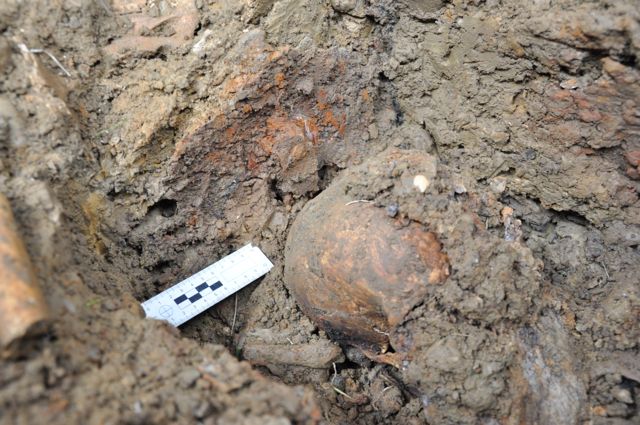
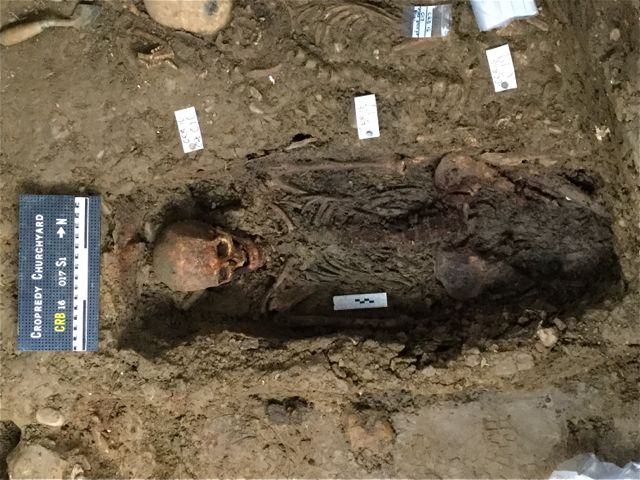
Our 'iron coffin' before excavation and afterwards.
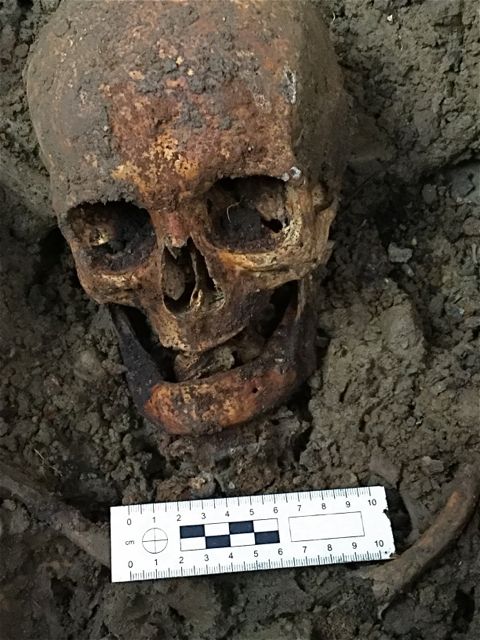
Detail of the toothless skull...
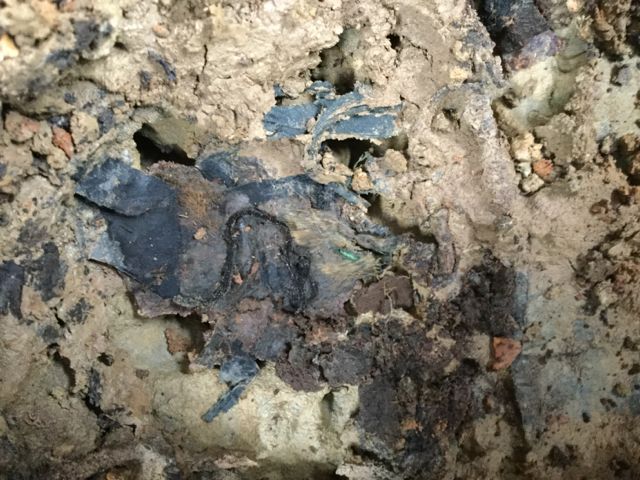
... and the possible bonnet she was wearing
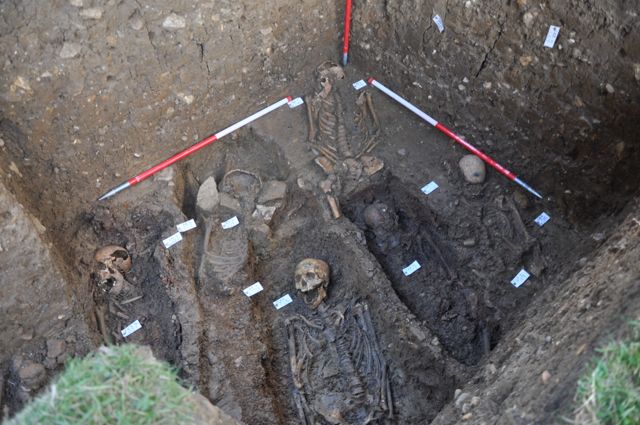
An overall view of the trench prior to the removal of selected burials.
We were particularly pleased to
welcome on October 25th. Lisa and Stephen, two representatives from the
Courtauld Institute department of wall painting. They were able to
examine our doom closely and were able to confirm its great importance
as a piece of national significance, despite its poor condition. Lots
to be done here now to plan for its future care not to say recording
and analysis. back in the finds department, also known as St. Fremund's
Chapel, work began to examine. record and then excavate in a little
table top operation the possible remains of our bonnet. Delicate work
which may take some time.
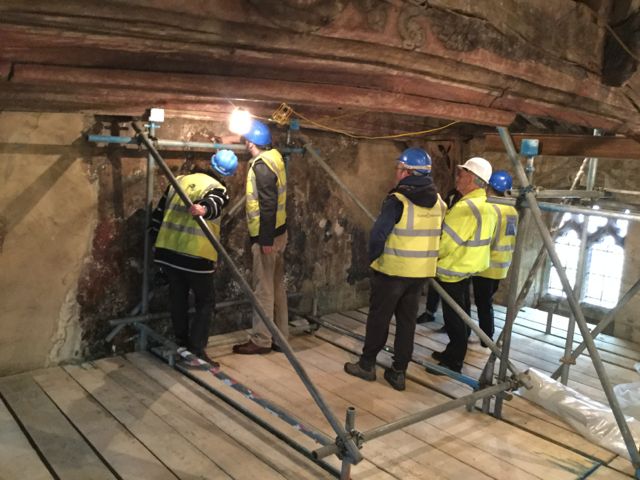
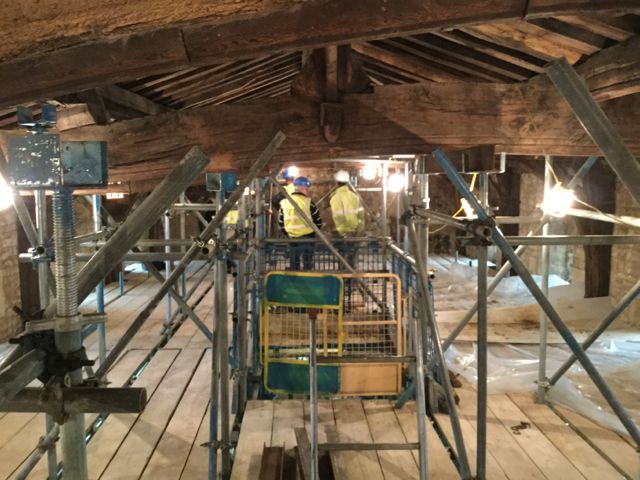
Assorted experts examine the doom painting.
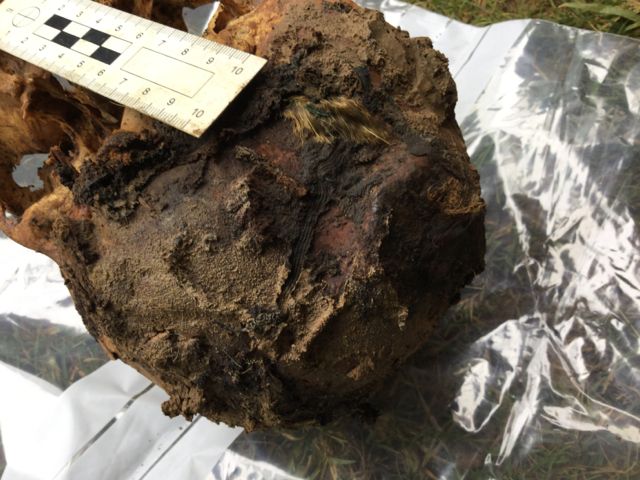
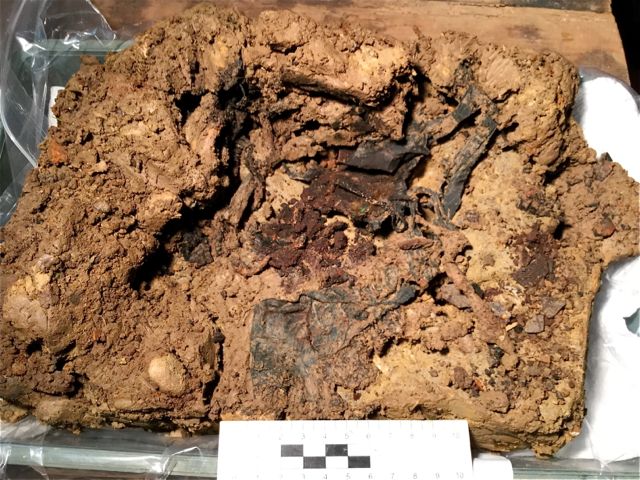
Detail showing surviving patches of hair and the remains of the bonnet lifted as a piece on a large block of clay.
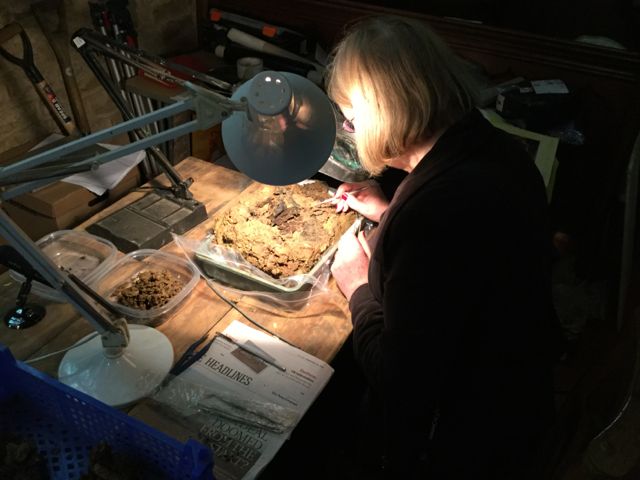
Verna begins the tricky job of teasing out the fragments in an attempt to understand its construction.
The final stages of digging saw us
excavate along the line of the in-coming pipe trench down to the level
of the first set of burials. These were not to be disturbed but were
recorded to help us understand more about the distribution of burials
on site. Another coffin with iron handles and a juvenile burial emerged
as did another piece of material, this time with a number of buttons
which may represent a purpose made shroud or even the shirt the
individual was buried in, more careful excavation and future analysis.
After that all remaining burials were carefully covered over and the
trench partially back-filled and awaiting the attention of the
builders. And that was it the end of an extraordinary piece of work
which began back on May 31st and has drawn on the time and talents of
local volunteers, well done to all , the digging id done but there is
still much to do, finds to wash, fabrics to study, roof beams to record
and there is still plenty of architectural analysis to carry out. We'll
be busy well into next year.

The last few burials are cleaned prior to planning and photography.
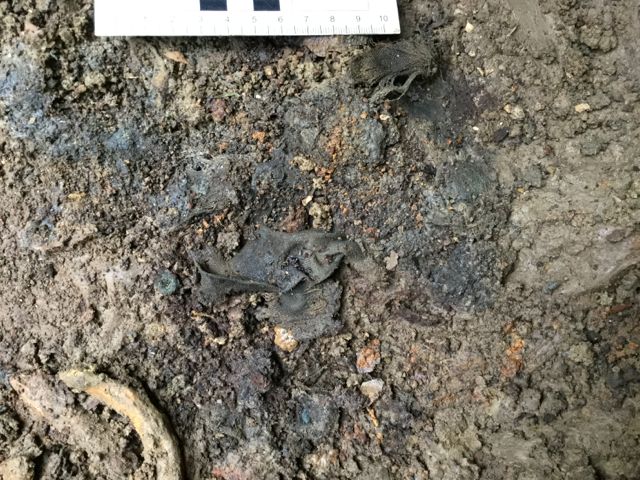
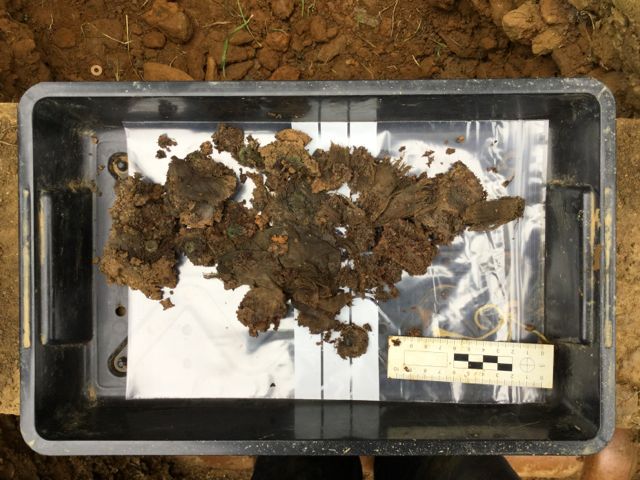
Always something turns up at the last minute, the remains of a
buttoned shroud or shirt in the ground and after lifting, note the
buttons.
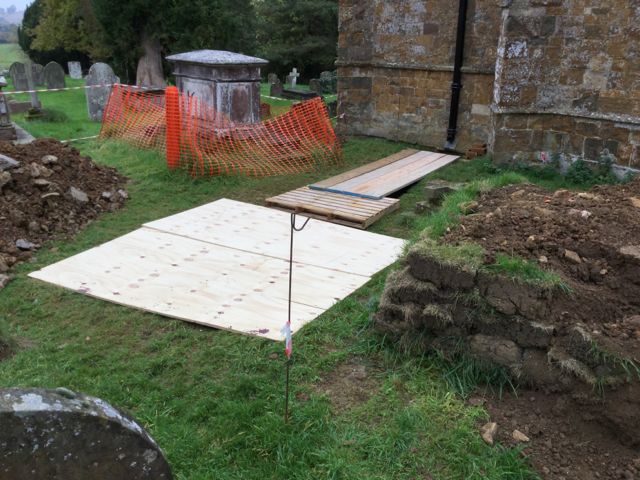
It's all over!
FRIDAY OCTOBER 14th.
Actually the fine weather has been continuing, we've been pretty lucky
so far this autumn. We were very well off for labour so we alternated
between a session down in the pit amongst the skeletons with time up
under roof recording the wood work, a welcome change no matter which
way you were heading.
We've also been in touch this week with the extremely helpful team of
curators and conservators at the the Museum of London regarding an iron
coffin they conserved from the crypt of St. Brides, Fleet Street. You read all about it here.
It will take a few more days before we are clear about the exact form
of our two iron coffins but there's no doubt they are creating a bit of
a buzz in certain circles.
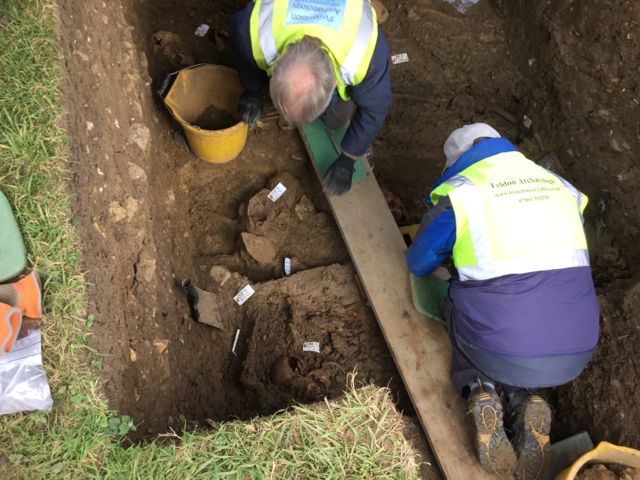
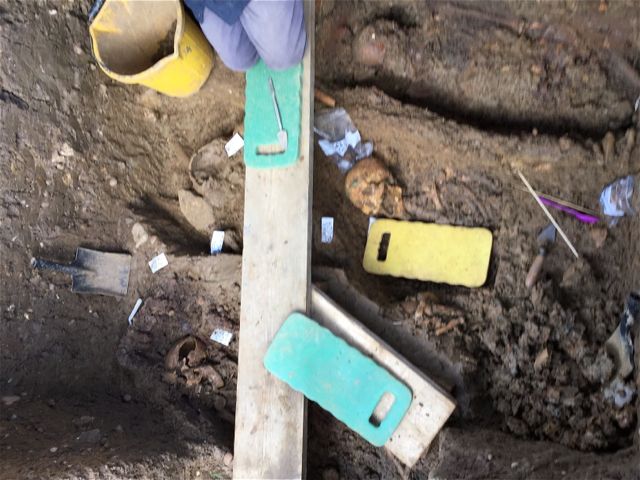
Peter and Andries each concentrating on a particular burial and here's what it looks like with them out of the way.
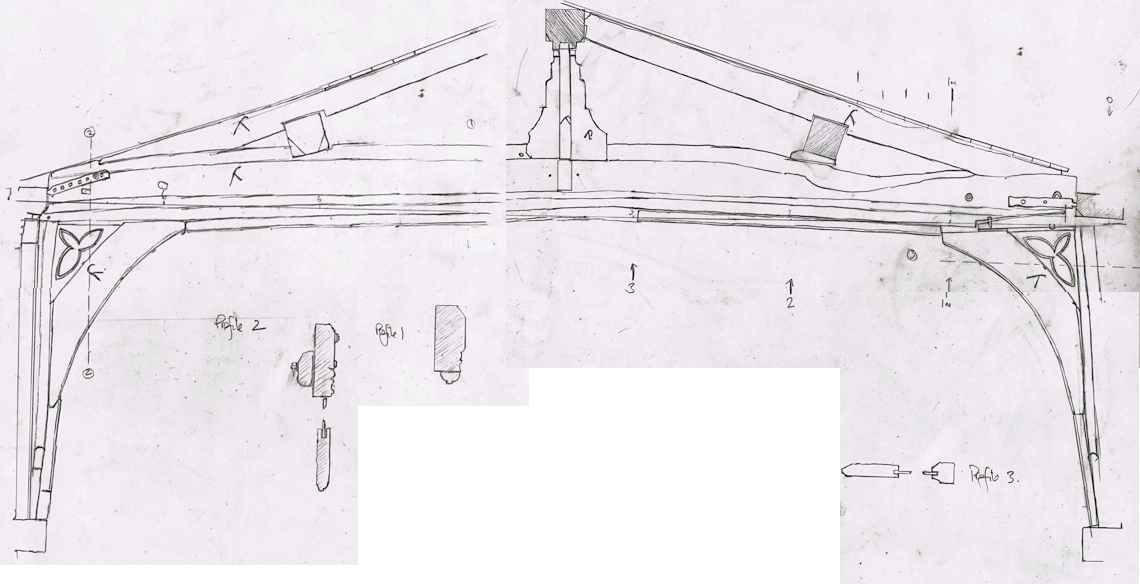
Work in progress, composite scans of the drawings made of the
easternmost roof truss above the nave spot the seven carpenter's marks.
WEDNESDAY OCTOBER 12th.
Once again an amazingly fast turn round from the consistory court and
we have our permission to continue to excavate and remove burials by
Tuesday afternoon. As we move further on into the autumn the promise of
good weather grows increasingly distant. Given that we have some very
tricky digging to do out in the churchyard I decided to put up a
temporary cover, also known as a gazebo, to permit us to carry on
through the next few weeks. The other piece of new infra-structure
(thanks to Lee and Ian for this is additional scaffolding planks to
create 'bridges' for us to work from. Not especially comfortable but
essential in a trench which appears to be wall to wall burials. As we
had had a bit of a wet start Peter took on the task of sorting out the
infant burial we had lifted in a block of soil from CRA, a combination
of careful 'digging' with sieving maximized the amount of bone we were
able to recover.
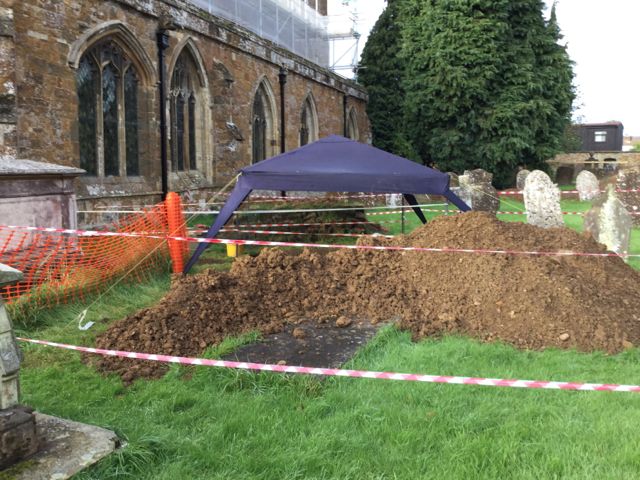
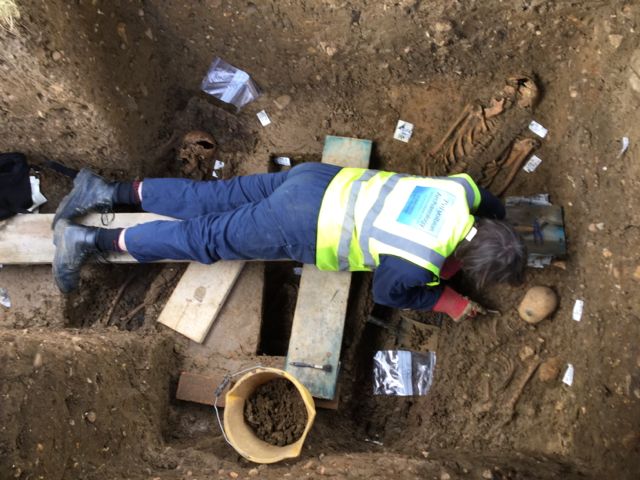
Cover, fencing and spoil heaps, essential ingredients for digging in
Cropredy churchyard.
Lying down on the job, it's the only way.
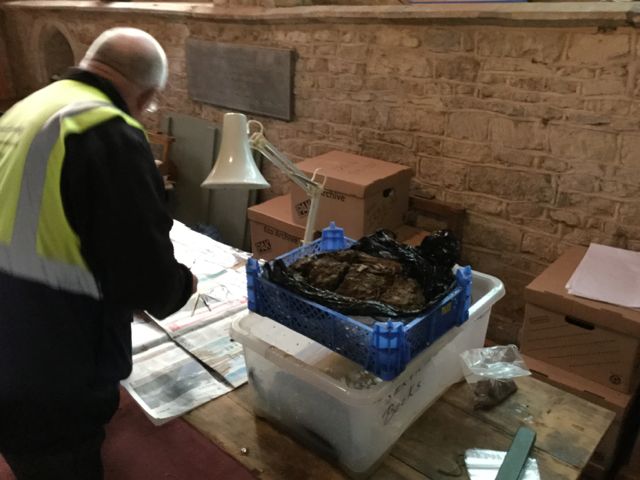
Peter begins a ticklish task.
MONDAY OCTOBER 3rd. to THURSDAY OCTOBER 6th.
I've run the sessions from this week together as essentially it was the
same story spread out over four days, namely the careful yet very
difficult excavation of multiple human remains encased with a
particularly damp and sticky clay. The situation was of course
complicated by the density of burials, six so far and counting. Two of
the burials are in iron coffins: one fairly thin iron sheet nailed
outside of the wooden coffin and the other apparently made of steel
plate! Speculation was rife, could these have been victims of some
especially feared disease? Lots more research needed. A shroud burial
next to our first iron coffin appears to have been of a woman who may
have been garlanded before burial, we found a couple of small copper
alloy hair pins, one of which had fragments of hair still attached. We
are now at the stage however of having reached a bit of a full stop. At
least four of the skeletons have to be lifted so the 2 metre deep shaft
for the soak away can be completed and so we have to go back to the
consistory court for permission.
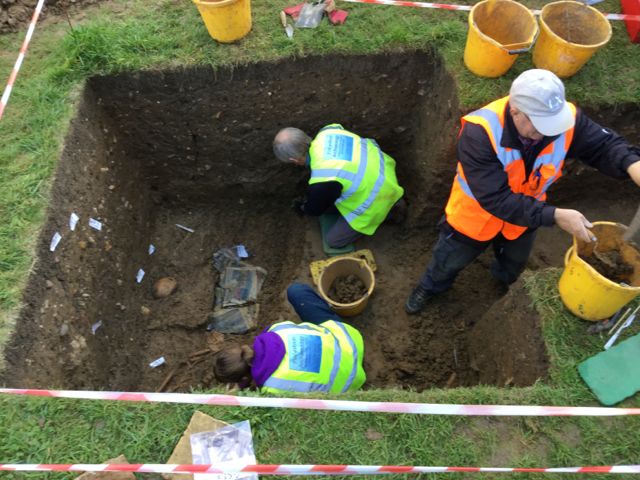
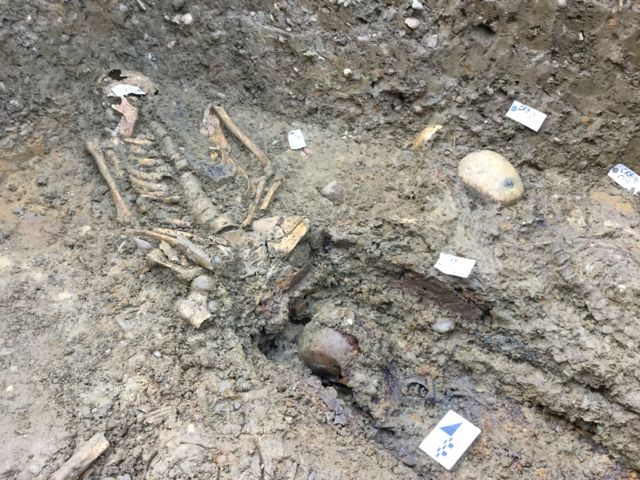
It's getting crowded in here, Helen and Andries and Peter start working
across the bottom of the trench examining the burials and this was what
they were working on.
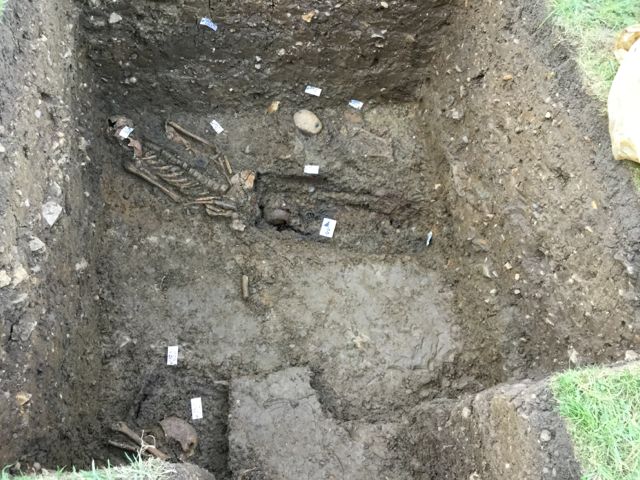
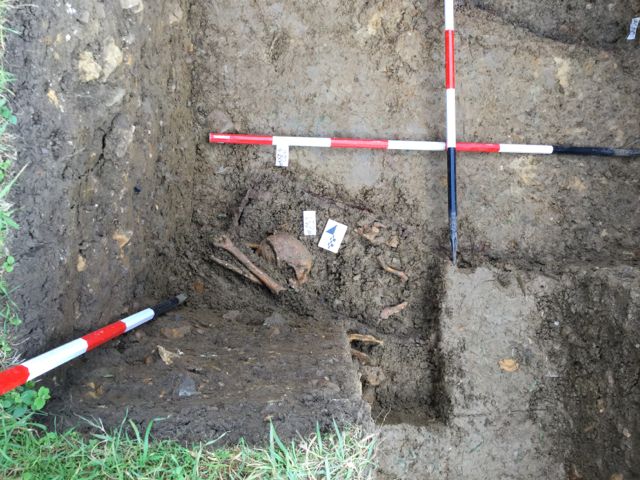
At the end of Monday we had examined a 'skull and cross bones' near the
south corner which proved to have been thrown in on top of another iron
coffin.
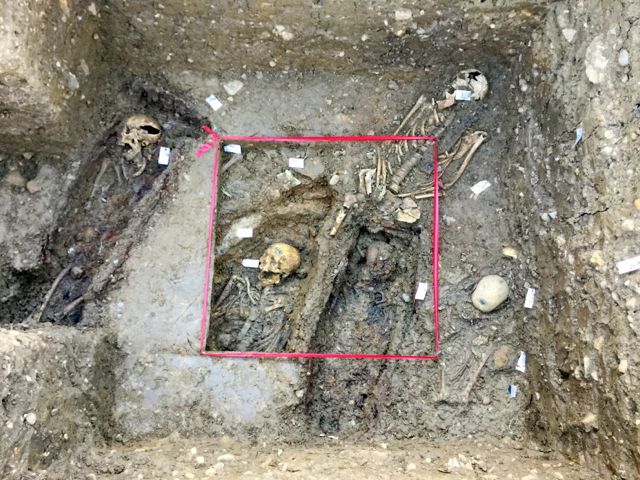
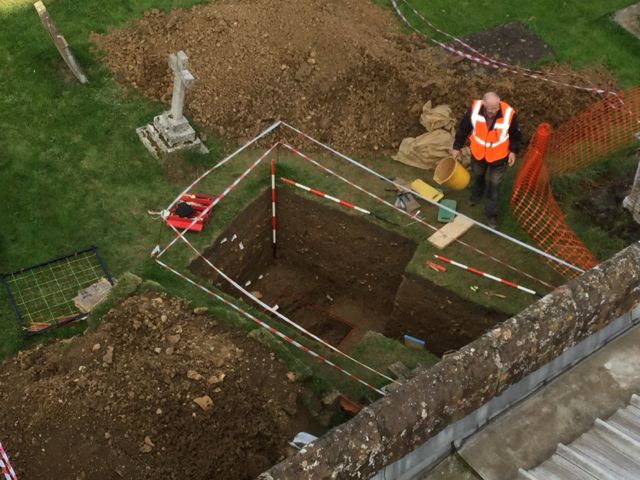
The
second iron coffin to the left partially excavated with the central pit
marked out, we have to drop about another 25cm here. Peter wonders what
it's all about,
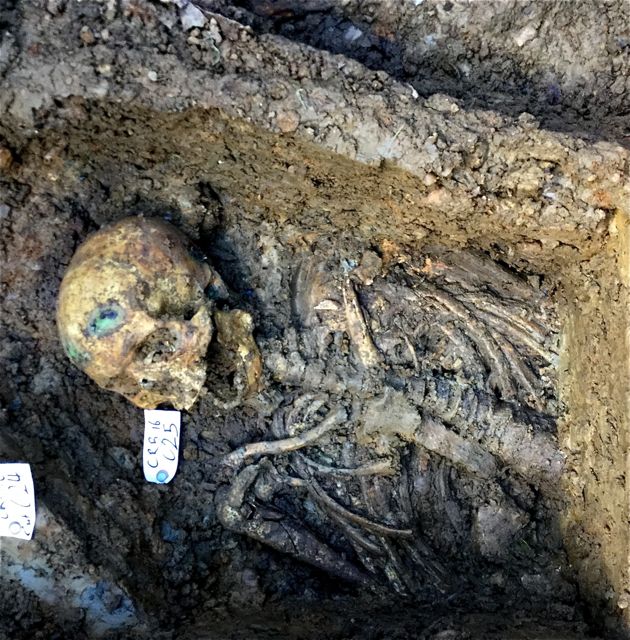
Detail of the last burial to excavated
during the week. the green staining from hair pins suggests that
perhaps she was wearing a garland.
FRIDAY SEPTEMBER 29th.
Get this finished by the end of the day I thought. Well the first thing
that came up was the truncated pelvis of a burial coming in from the
west and apparently, thanks to Peter's careful excavation, with the
remains of a coffin lid on top of it. Then it became clear that the
truncating had been done to insert some kind of iron box. Further
investigation revealed this to contain a skull and therefore the
conclusion that we had an iron coffin became inescapable. Ten next to
that our third burial this one with two green stains on the skull which
may indicate the presence of copper alloy hair pins. I'm guessing at
the moment that these are burials from the eighteenth or nineteenth
century but one thing was quite clear, we wouldn't be finished by the
weekend.
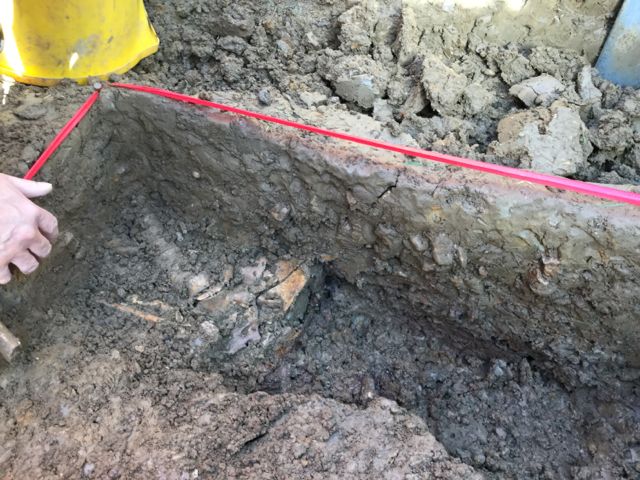
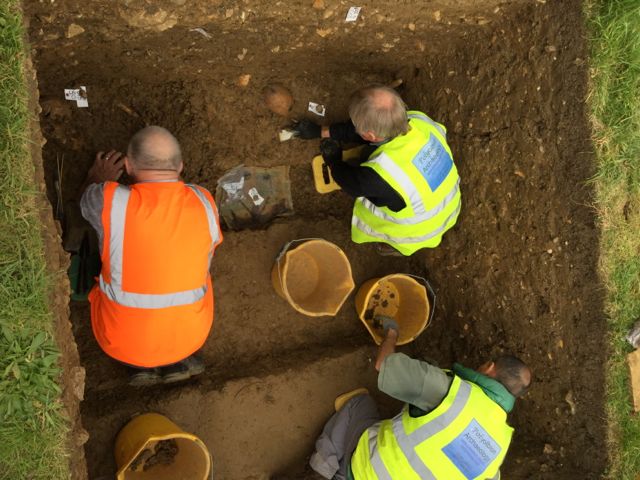
The
first skeletal remains
appear.
All systems go with three burials under excavation.
The other highlight of the day was
the opportunity to take Andries and Mark, up on the nave scaffolding to
view the timbers, which I had been drawing, and more particularly the
doom painting, close up. It's especially interesting but not surprising
that the closer one looks the more one sees (examples below).
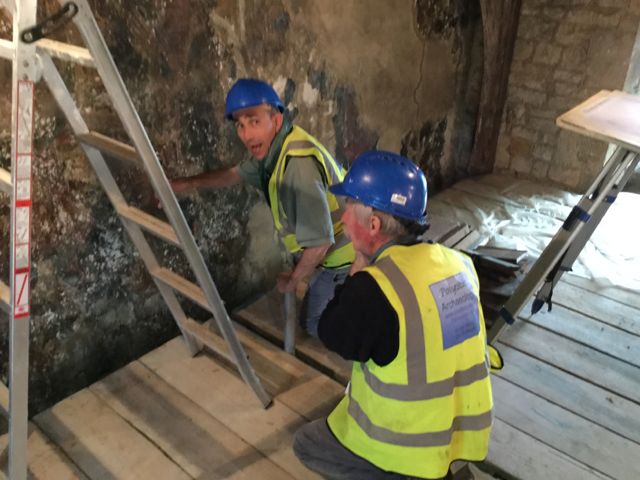
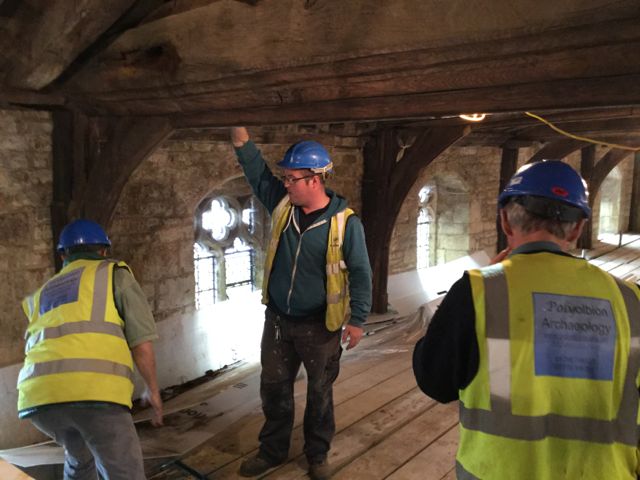
Mark is very excited by his identification of (not with ) John the
baptist and Lee explains some of the structural issues with the roof.
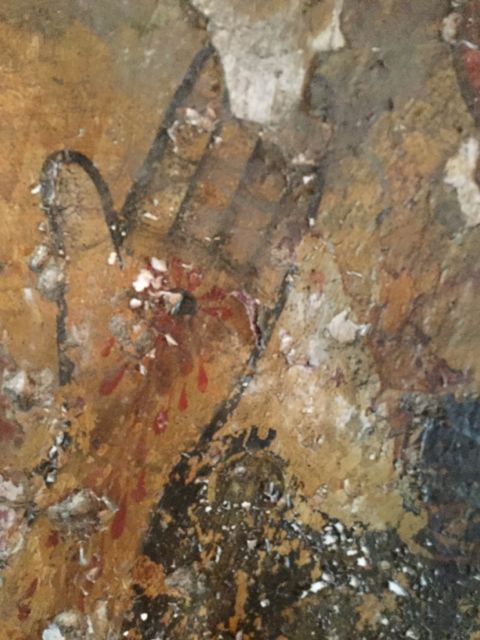
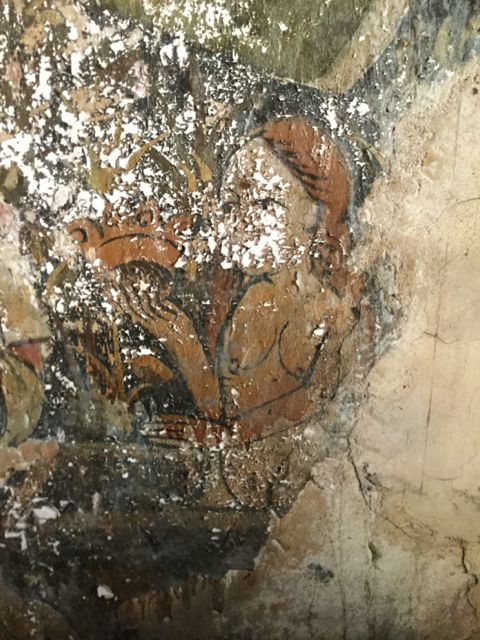
Two details: rather copious drops of blood scattered from Christ's
pierced hands and a naked woman emerges from her grave bearing a crown!
THURSDAY SEPTEMBER 28th. With the
first trench finished we continued cracking on with the soak away
trench systematically lowering the levels around 15 cm at a time until
we had reached an overall depth of just over a metre and despite odd
indications of possible patches of looser soil that could indicate
grave cuts we had found very little. The main point of note was that
we were recovering fragments of clay pipe stem from very low down
indication the ground had been thoroughly dug over in the post-medieval
period. So it was that we began the final stage of the excavation and
marked out a smaller area just 1 m square which we would carry on down
to the full depth of 2m. We'd be finished by the weekend.
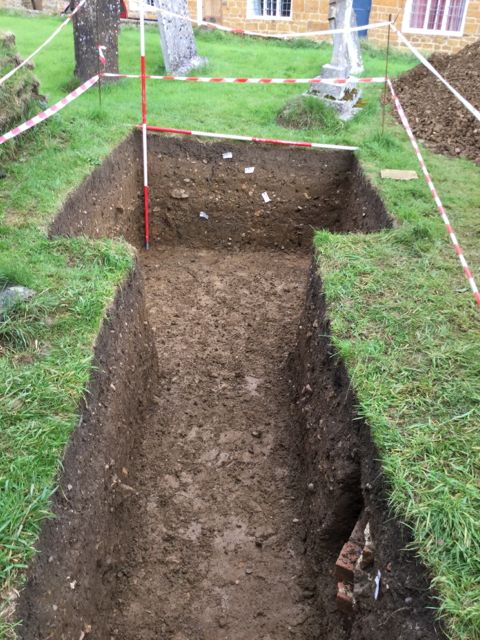
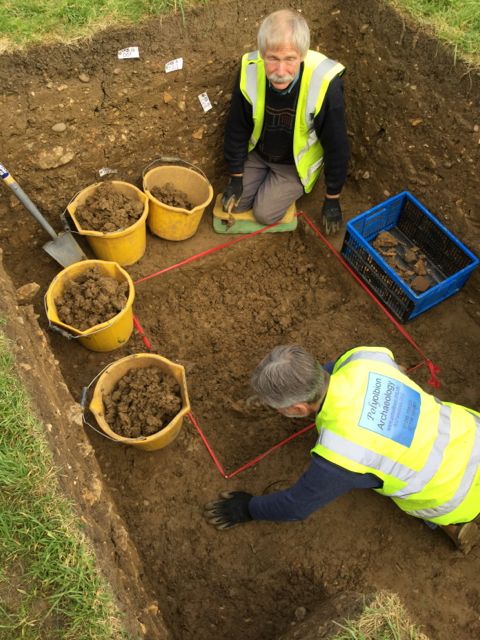
Yes the trench really is wonky... long
story.
Andries and Geoff get to grips
with the final square.
TUESDAY SEPTEMBER 27th.
Tuesday saw the parish outing to Leicester. This was a two part trip. Initially to the headquarters and works of Norman and Underwood
to watch our recycled lead being melted and recast and then on to the
centre of the city to the Richard III centre and cathedral. There was a
connection in that the managing director of Norman and Underwood had
been the last person to see Richard's bones as he was responsible for
sealing the new lead coffin in which the king's remains were
re-interred.
The work being done on the factory floor was hugely impressive. There
were three operatives who were continually on the go setting up and
casting a huge sheet of lead roughly every 20 minutes. First up the
tray of casting sand had to be prepared and carefully leveled before
the silver stream of molten lead was pushed along to create a sheet of
even thinness which was then rapidly marked out, cut and rolled and
set aside to bring back to Cropredy. This was hard physical work and
represented a curious mixture of the hi-tech furnace and breathing
apparatus with casting methods that date back millennia.
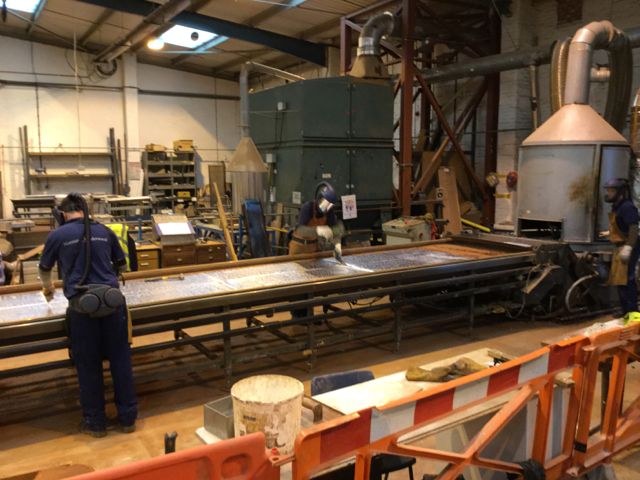
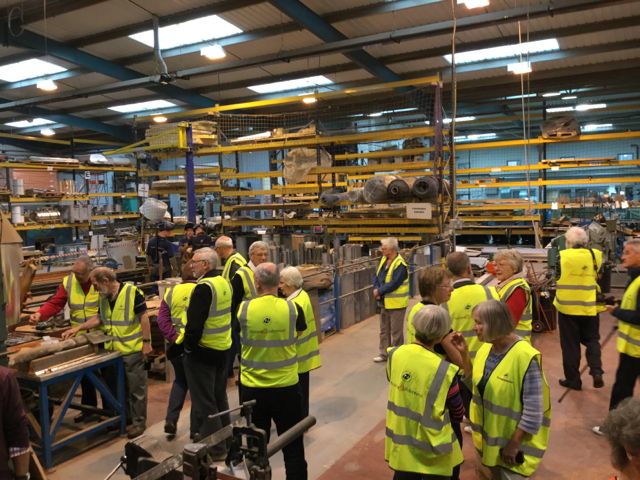
The
freshly cast lead being cut into manageable sized
pieces.
The Cropredy crowd mill around admiring everything that was going on.
FRIDAY SEPTEMBER 23rd.
The scaffolders finished in good time to enable a Friday morning site
conference for all of us with an interest in the roof timbers. There as
mush poking of timbers and gradually a plan emerged. From an
archaeological point of view, apart from promoting minimal intervention
where ever possible, the key task will be recording both with photos
and drawings the main elements of the roof structure plus its
decoration plus the extraordinary efforts to keep it all together over
the years.
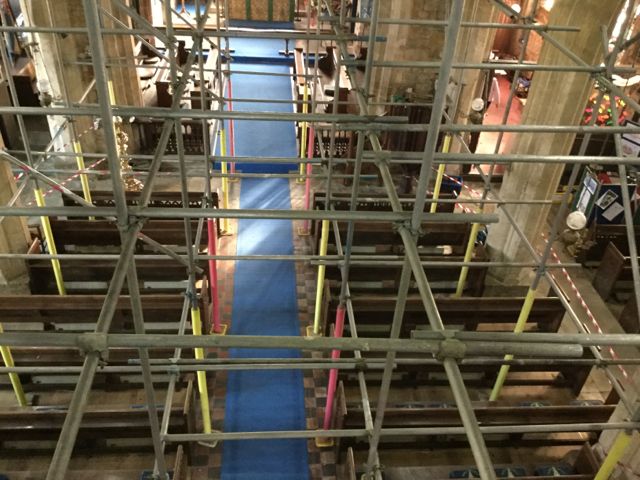
Half way up there is a landing which gives you a remarkable view down the nave.
THURSDAY SEPTEMBER 22nd.
The scaffolders have moved in and working as only scaffolders can have
made remarkable progress, even if the work is accompanied by a medley
of Elvis's greatest hits. Away from the fray the last section of trench
CRA was completed with a careful examination of the deposits behind the
churchyard wall. There can be no doubt that it was built in the
nineteenth century, oh well there goes my dream of a medieval church
wall, wait a moment, perhaps it was rebuilt, there has to be some
explanation for the huge size of some of the reused stones employed in
its construction.
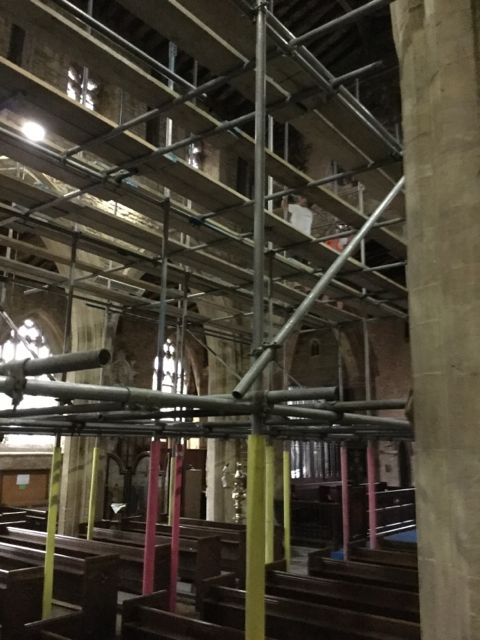
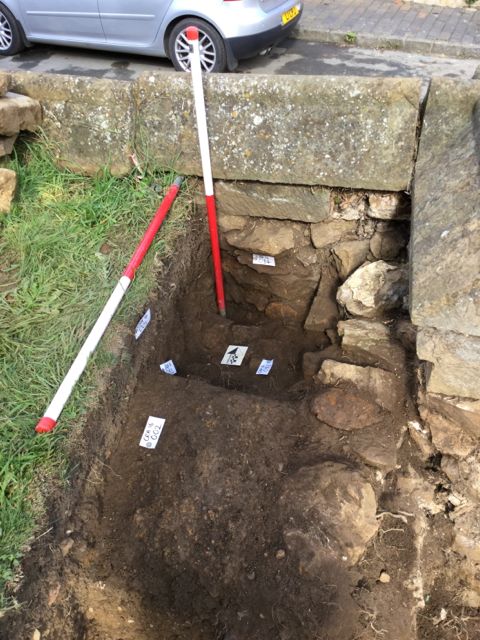
What a transformation, inside the church as the scaffolding goes up whilst outside the last act of CRA16.
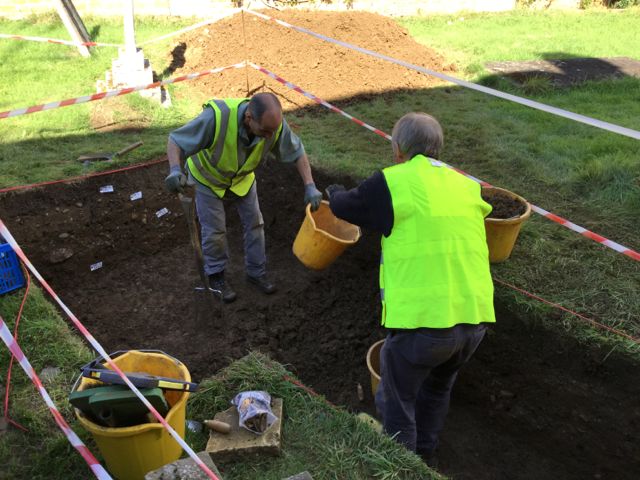
Still they persevere in CRB.
FRIDAY SEPTEMBER 16th.
It was rather sad to see the back-filling completed: three months to
remove it, three hours to put it all back in place, more or less, still
it was better than doing it all by hand. Meanwhile in CRB the levels
continue to drop but any sign of burials, apart from scattered
fragments of bone, remain elusive
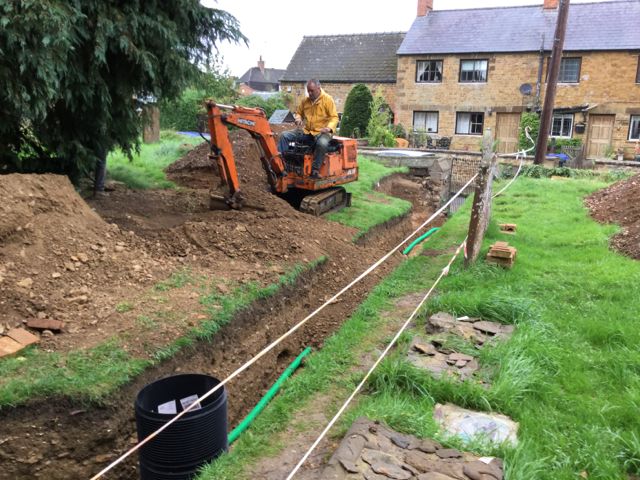
Sign of the times: the green pipe is for data!
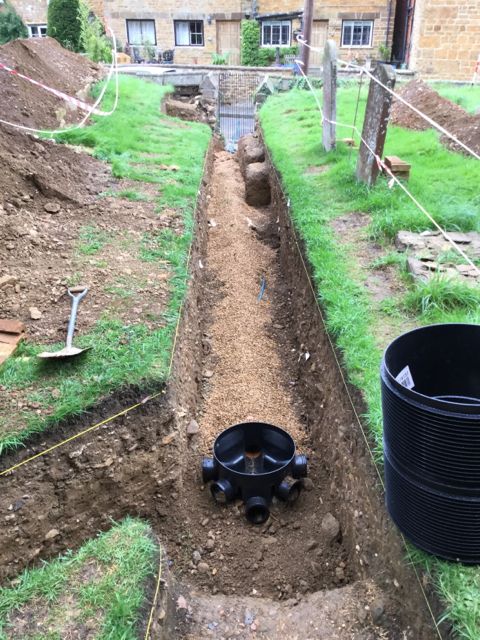
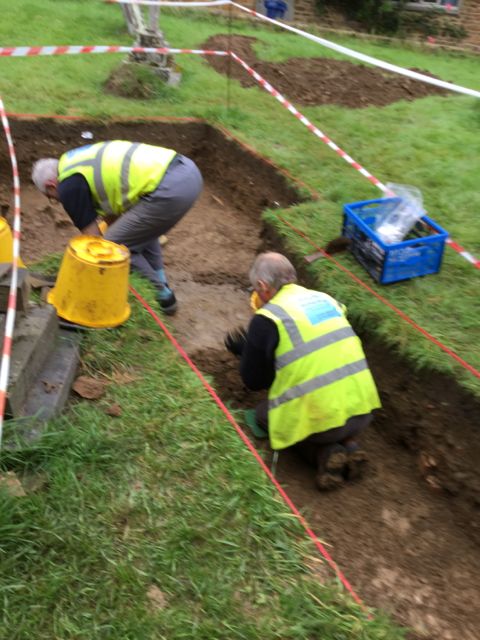
Back-filling well underway, so that was what all the bags were for. And still they persevere on trench CRB.
WEDNESDAY SEPTEMBER 14th.
Wednesday saw the arrival of the road crew who took some time and
trouble to actually locate the services below Red Lion Street. Once
they had done that however they worked quickly to make connections and
fill it all in. Inside Lee and his team had removed the inside steps up
to the north door revealing the face of the wall below the threshold.
Not a lot to it but it will repay careful study and recording if we are
to understand the differing levels between the floor of the north aisle
and the features outside.
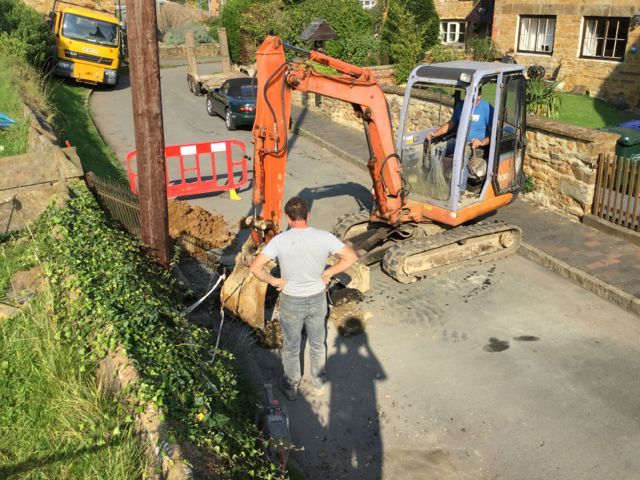
The road crew swing into action...
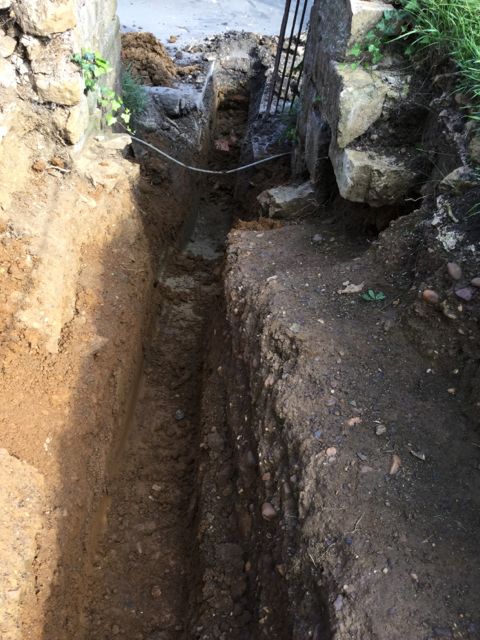
... and discover clay, clay and more clay below some gravel, still it had to be checked out.
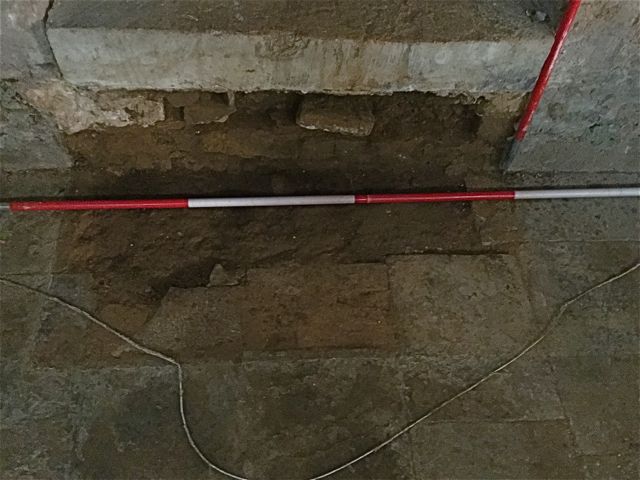
Must get a better photo of the wall below the steps, it was all rather gloomy in there with door closed.
TUESDAY SEPTEMBER 13th.
As CRA closes down work continues on CRB. It's time consuming work and
many thanks to the team who carefully and patiently reduced the levels
in the soak away trench. We must be getting close to the point at which
we came upon the highest level of burials in our first trench.
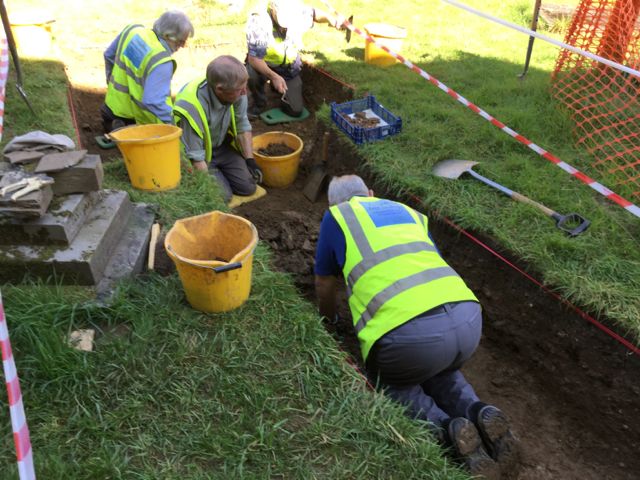
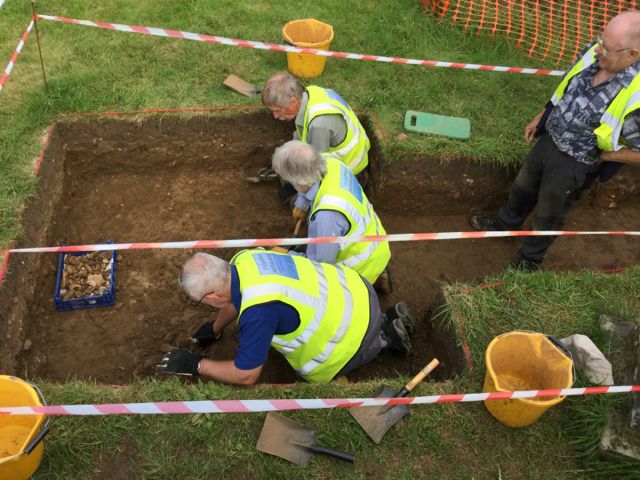
Contrast in styles: finishing off the last level and in the classic trowelers in a line style to start a new one.
FRIDAY SEPTEMBER 9th.
Really the final stages of work on CRA 16, lots of section drawing and
a final burst of recording on three overlapping burials which will be
covered over and left in situ. Down by the vestry work continued on the
second trench, not hugely interesting at present but one particularly
interesting find, a copper alloy disk with a raised rim and incised
pattern, ideas range from lid to weight to gaming piece, as ever, all a
suggestions gratefully received.
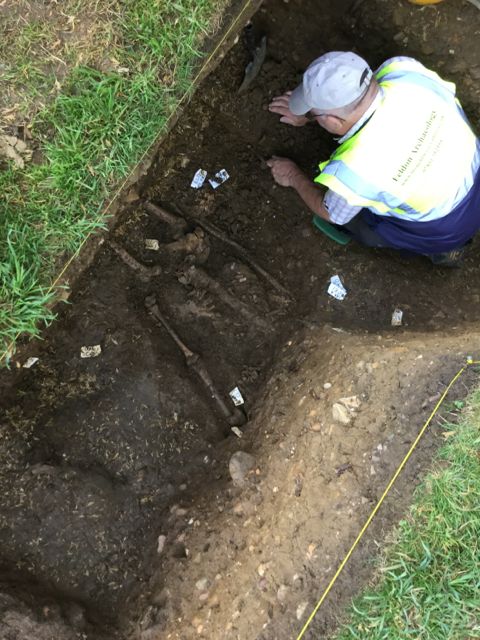
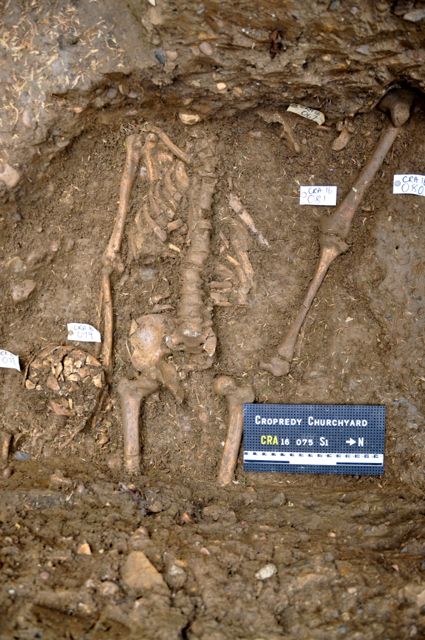
Peter undertakes the final stage of cleaning before we photograph the last three burials to be uncovered.
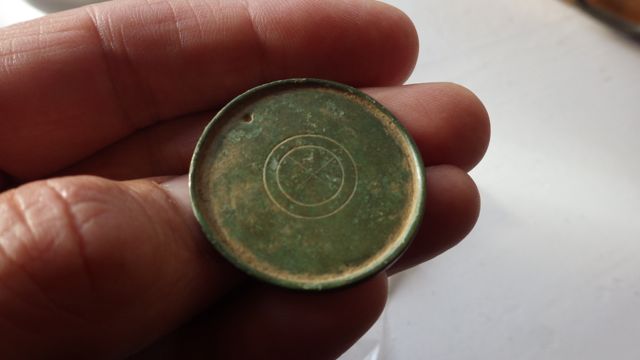
CRB16 002/1... suggestions please ( the hole is a shallow indentation not a piercing).
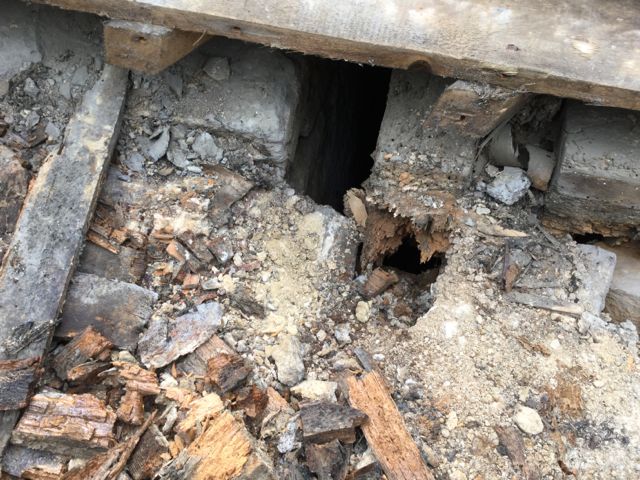
Meanwhile up on the scaffolding I had a chance to look at some of the beam ends in the nave roof, not a pretty picture.
TUESDAY SEPTEMBER 6th.
In order to accommodate some serious hole drilling we had cleared the
area at the west end of the north aisle but it was also time to
relocate the entire finds department to St. Fremund's Chapel, special
thanks to Sue for helping with this. Out in the graveyard work on the
first trench was drawing to a close whilst more of our attention was given over to CRB 16, the soak away trench.
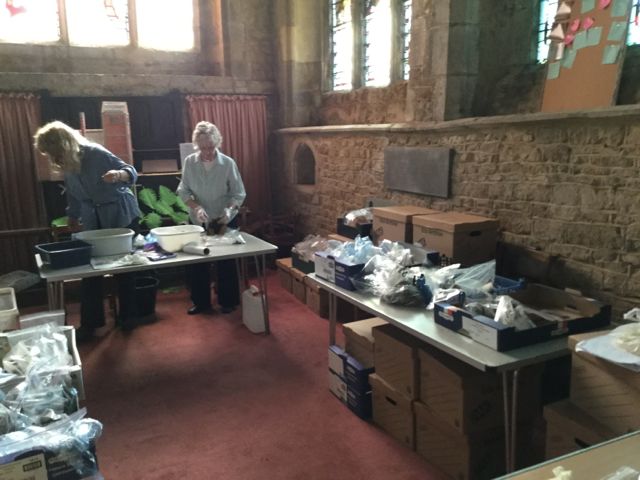
The move nearly complete, Christine and Sue set to work in St. Fremund's Chapel.
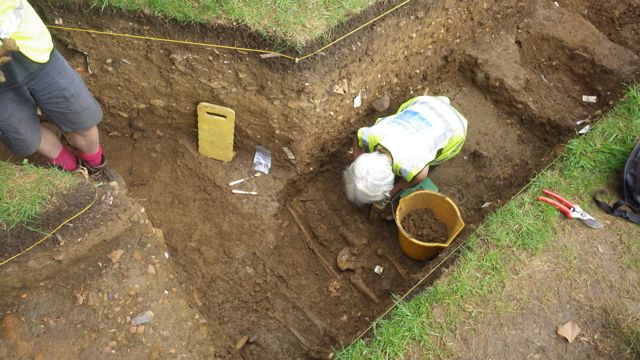
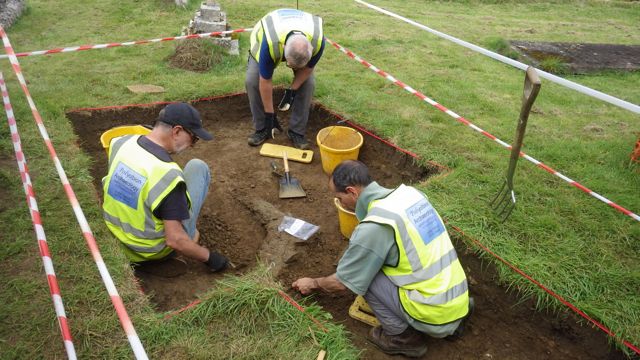
Chris ponders the mystery of what may be three inter-cutting burials whilst levels continue to drop in the soak away.
FRIDAY SEPTEMBER 2nd.
This was a hugely productive day with our best turn out yet with a
total of 16 local and not so local volunteers contributing at different
times of the day. This enabled us to get on really well with our second
trench CRB16 which will eventually be home to the 'let's keep the
vestry dry soak away'. In order to maximize the amount of information
recovered from this operation and perhaps more importantly guarantee
the safety and comfort of our diggers, we have opened up the pipeline
trench to a full metre and staked out a 2 x 2 metre square on the
site of the soak away pit so that it can be stepped down to its full
depth of 2 metres.
back in the first trench we lifted three more skeletons but
disentangling the burials closest to the north door took more time as
we had two skulls immediately next to each other and then traces of a
couple more burials appearing underneath them a touch further north. In
order to give everyone a bird's eye view of the proceedings we took a
few brave volunteers to the top of the newly completed tower to peer
down on their colleagues from above.
W also had a crack team at work on the long and careful process of
cleaning the bones now lifted. This involves toothbrushes, wooden
skewers and ultimately dental probes not to mention the very careful
labeling and packing of the remains, thanks to all.
WEDNESDAY AUGUST 31st.
I had planned a day over at Farnborough for the Wednesday but following
a call from Kathryn asking if there was to be any work at Cropredy for
her and her friend Stephi I asked Verna to get them going whilst I
sorted out dates and procedures with contractors about to start work on
the repair of the main cascade at Farnborough. Once that was done we
got organised and as well as cleaning up a trio of graves for
photography they also got to grips with some panning and section
drawing, enormously helpful in terms of keeping up with the recording.
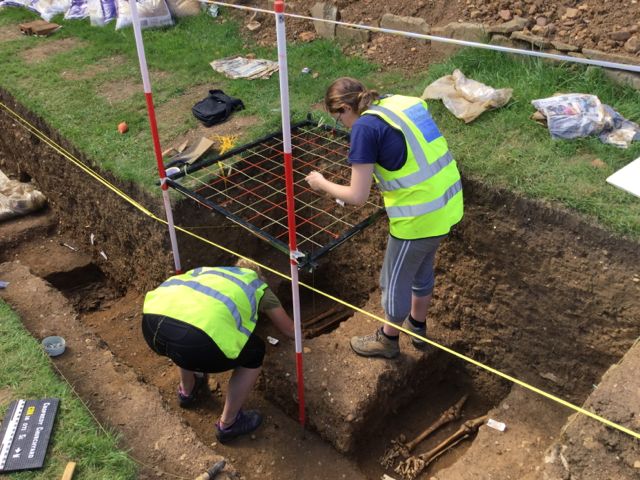
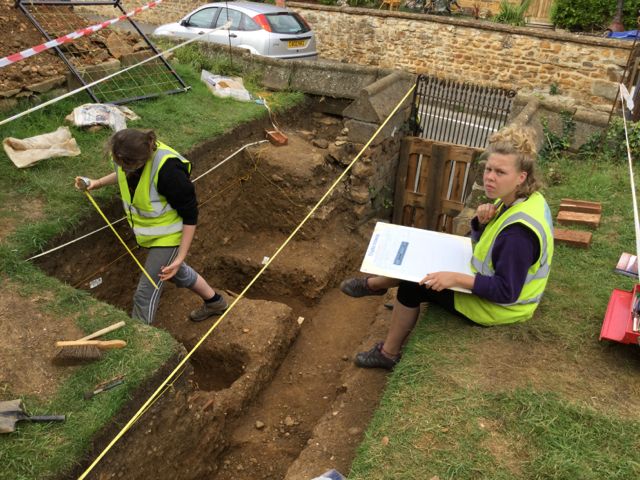
All new drawing skills: projecting the grid and measuring from the section line.
TUESDAY AUGUST 30th.
A fairly quiet day with some useful progress made on investigating the
last couple of burials before continuing with the lifting and
recording, however, we were graced with a party of transatlantic
visitors thanks to Peter who not only attended the church service that
morning but also set out their chairs and enjoyed the sight of our
digging over a picnic lunch.
FRIDAY AUGUST 26th.
Lifting continued apace thanks to Andrew, Mark and Laurie and cry goes
up, 'more plastic bags!' On the previous day I'd been examining the
section edge and suggested to mark that we had an as yet unexcavated
grave revealed in the cut. After a false start with a few badly jumbled
bones this turned out to be the case and later in the day Geoff took
over the excavation of what appears to be a burial with significant
quantities of organic material associated with it. Slow work to be
continued in the following week.
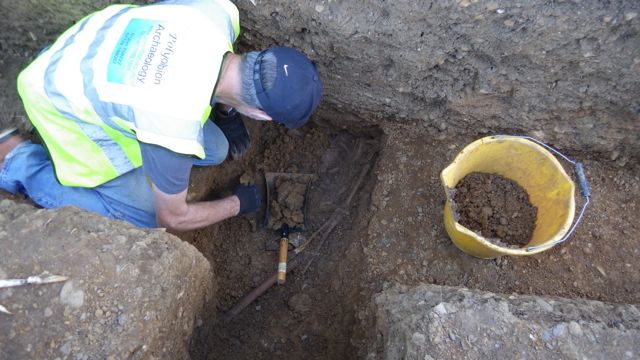
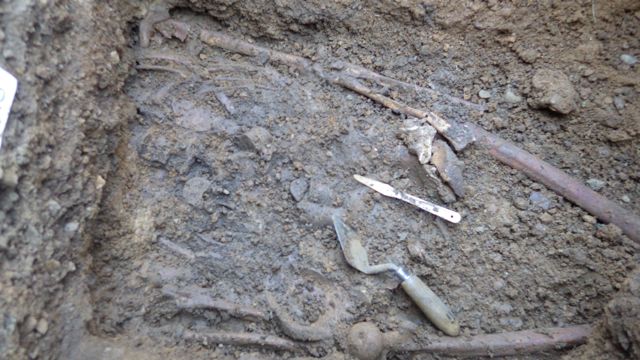
Geoff
gets to grips with quite a sticky
fill.
Work in progress over a large area, could this have been an unusually
large individual?
THURSDAY AUGUST 25th.
A day of challenges, not least associated withe the scaffolding crew
who were juggling with planks and poles or whatever it is that they do,
not quite overhead but near enough to warrant hard hats then it started
raining. Peter had set up his skeletal cleaning station outside but had
to transfer into the north aisle later on as it grew wetter. Meanwhile
Sue and Christine had been operating a very efficient skeleton bagging,
washing and storage operation - very impressive.
TUESDAY AUGUST 23rd.
Verna joined us for the first round of detailed photography of our
assorted burials and once this task was complete the go ahead was given
to start lifting those burials which lay on the route of the pipe line.
Initially one of the highest burials, an adult with a badly crushed
skull was lifted first then Peter got down to the sensitive task of
lifting the remains of the infant burial. The first task was to cut
around the skull area so it could be lifted in a black, a delicate task
which was postponed until Thursday.
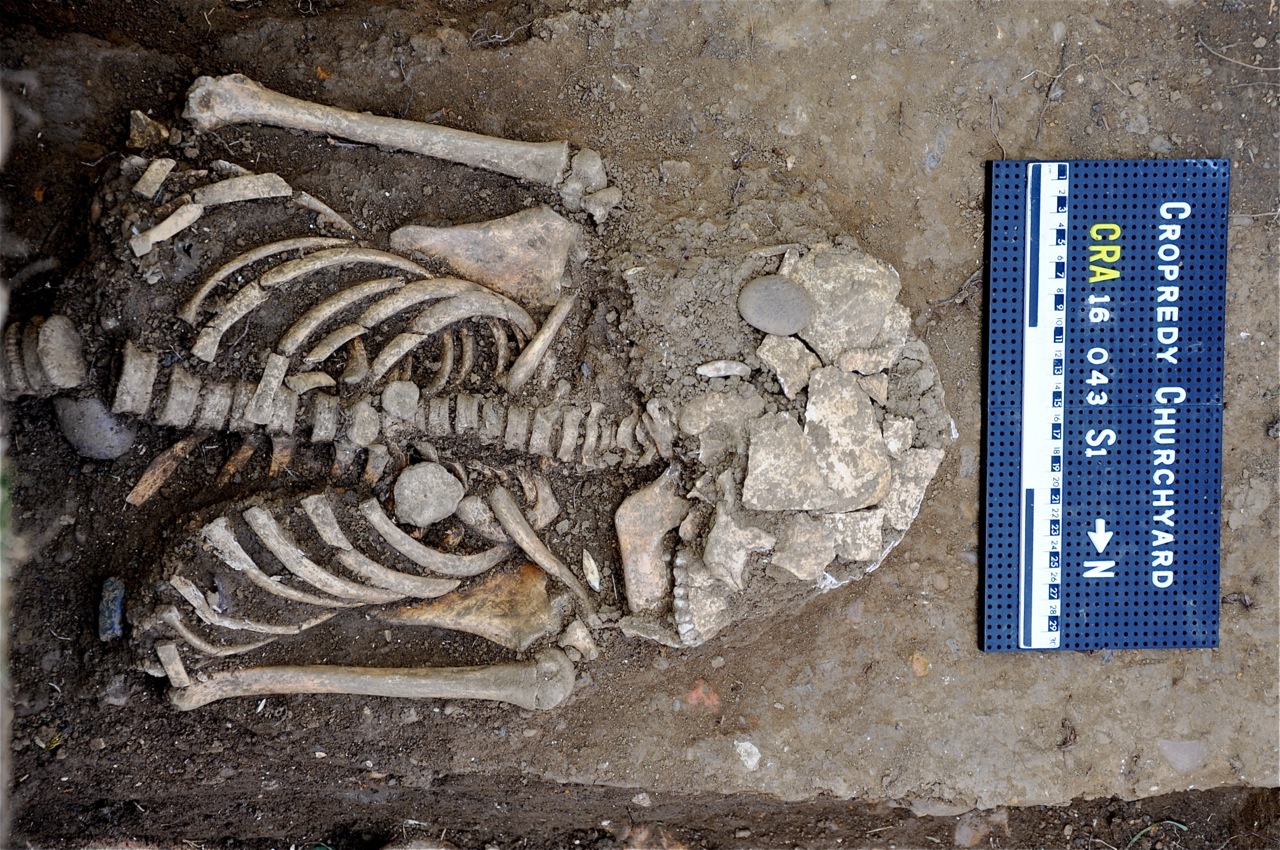
CRA16/043/S1 captured prior to removal.
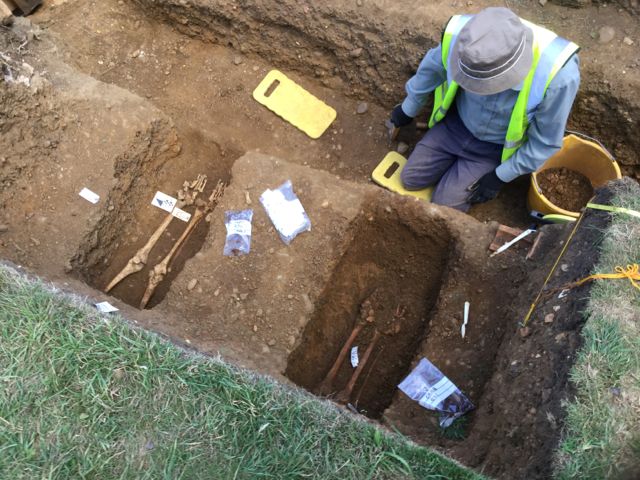
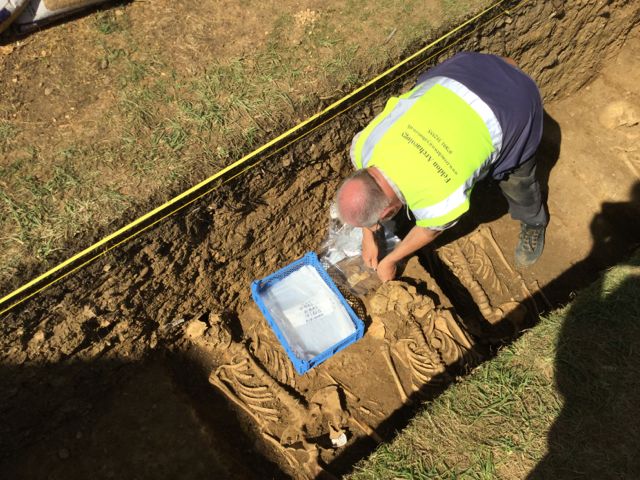
Mark finishes off the second burial in the extension whilst Peter lifts the first skeleton.
MONDAY AUGUST 22nd.
Unfortunately we had a call out on Saturday evening from some good
neighbours who had noticed a group of young people down in the trench
and after an attempt at educating them in the error of their ways had
asked them to leave. By the time we arrived there was nobody around but
I was concerned that there could be a further incursion so I spent an
hour or so wrestling with scaffolding planks and shifting nearly a
tonne of pea gravel to weight them down.So it was on Monday morning the
process had to be reversed and the trench cleared. At first the damage
didn't seem to be too bad, the skeletons had been swathed in damp
newspaper and thick plastic, but there were clearly a few post-mortem
fractures that were not our responsibility. So the start of the week
was primarily cleaning for photographs plus an excursion down at the
extension to the north end of the trench where two new graves had been
identified. What made these different was that they were clearly
coffined burials as evidenced by the regularity of the cut and the
presence of large numbers of small iron coffin nails.
FRIDAY AUGUST 19th.
It was wet so we retreated into the church for the day to process some
of the finds. This involves careful washing, drying and re bagging then
storing the bits and pieces we have come up with then there is a
further stage when we return to each context and begin the detailed
recording and analysis of the material. Helen and I managed to do 001
Turf and Topsoil and most of 002 Subsoil during the course of the
day.
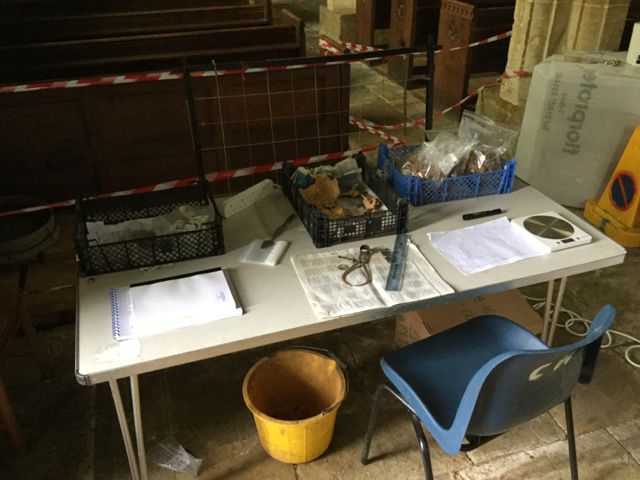
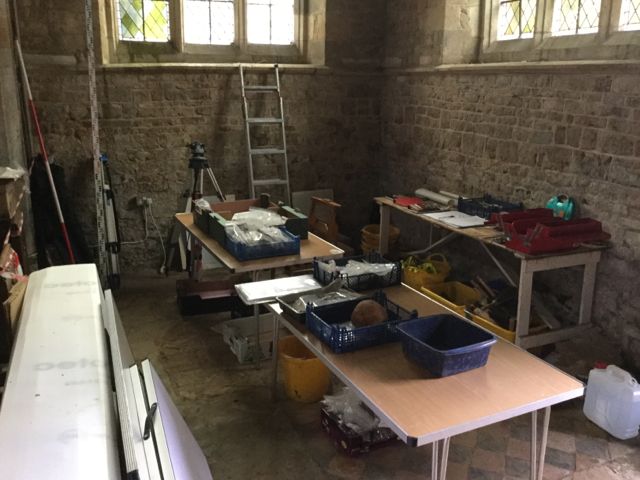
Finds
recording and analysis
department.
Finds washing and packing department.
THURSDAY AUGUST 18th.
Just when the final stages of excavating our nine existing burials
approached a final check revealed one more lying in the way of the
pipework plus it was time to return to the far end of the trench to
complete the section against the north wall of the churchyard. Then
another big cover up as bad weather was forecast for the weekend ahead.
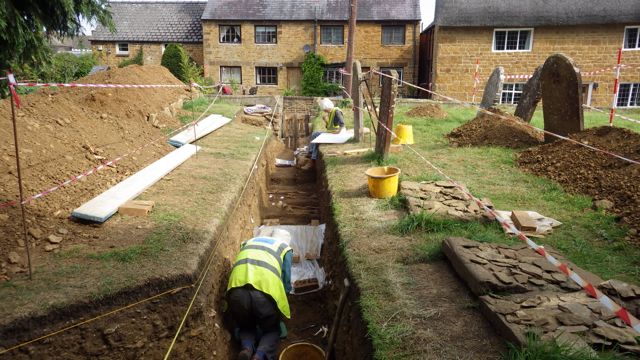
Chris begins the onerous task of planning the first three burials whilst Andries is just checking....
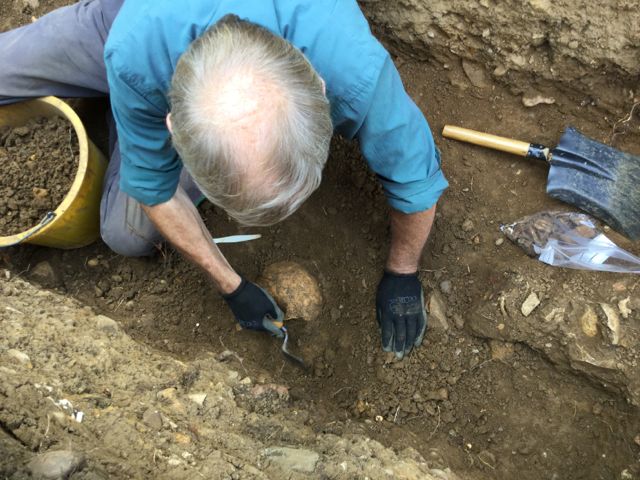
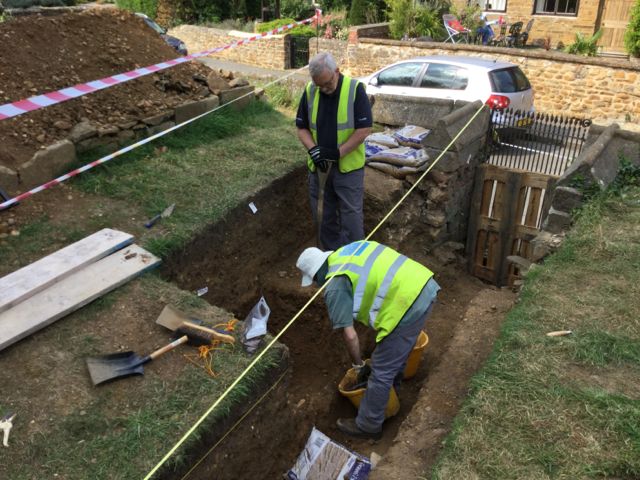
... and comes up with one more burial to take us to a nice round 10.
Meanwhile Mark and Laurie may be on to something at the other end of
the trench.
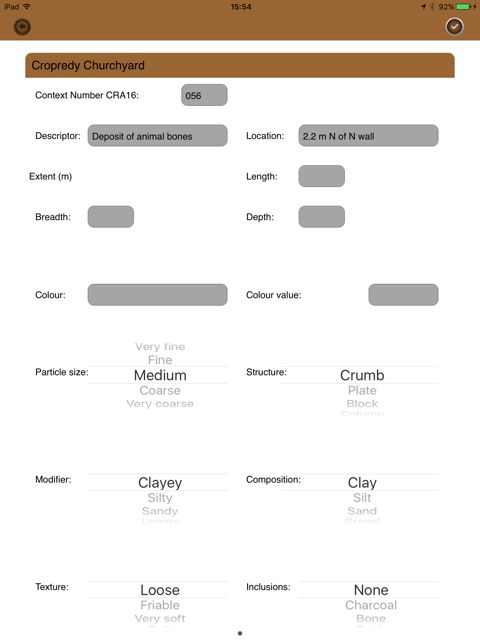
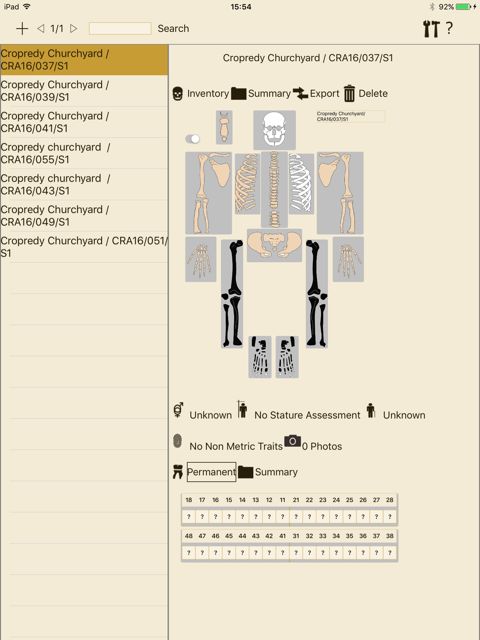
And here's some recording using a couple of apps on the iPad:
Form Maker by Isoperia and Gill Hunt's
Skelly Pad.
WEDNESDAY AUGUST 17th.
From day to day progress appears quite slow but then the careful
excavation of human remains is a painstaking process of digging which
goes hand in hand with the equally painstaking business of recording.
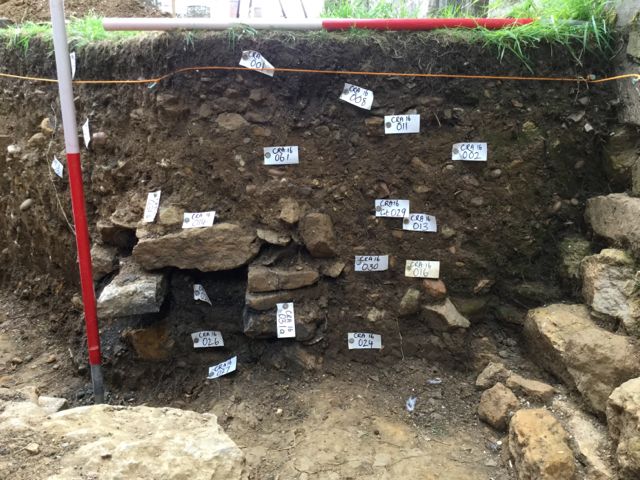
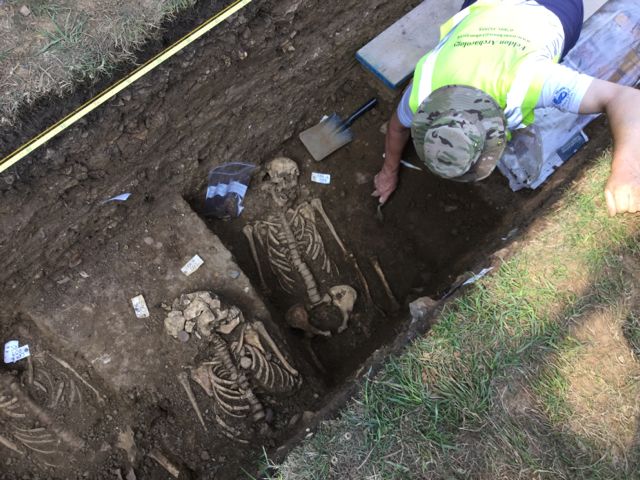
Doing the recording means going back over work done already and
ensuring that you have covered everything and really understand it
whilst in addition the final cleaning of skeletons requires a steady
hand.
TUESDAY AUGUST 16th.
Monday was all about clearing up so on Tuesday we were able to resume
where we had left off last week with further excavation of the nine
exposed burials. It all takes time especially as working conditions
became more and more cramped
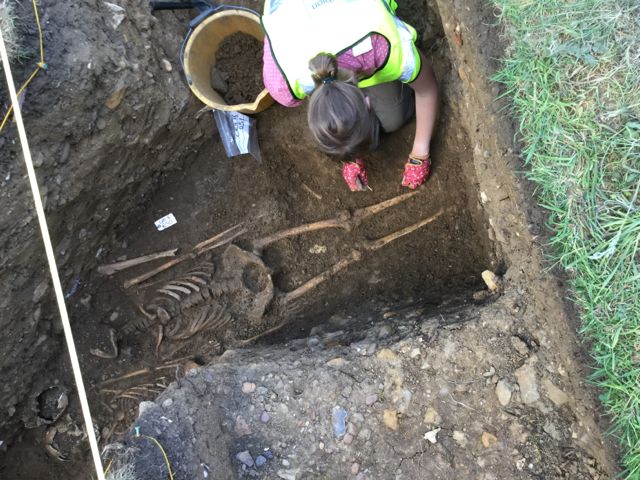
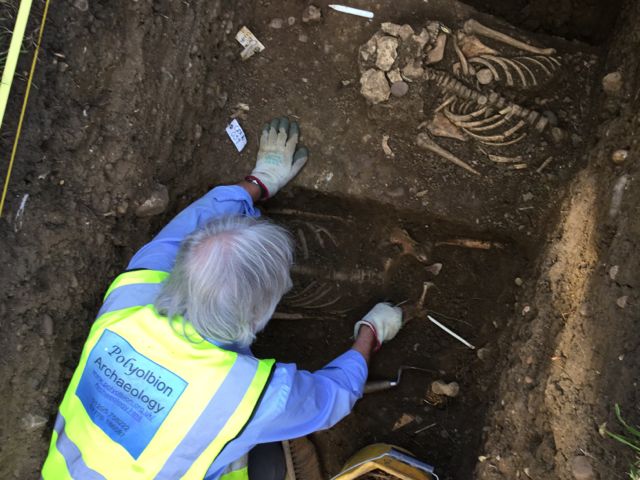
Helen has nearly finished the one skeleton we are likely to lift
entirely whilst Andrew delves into the pelvic area of our most
recently revealed burial.
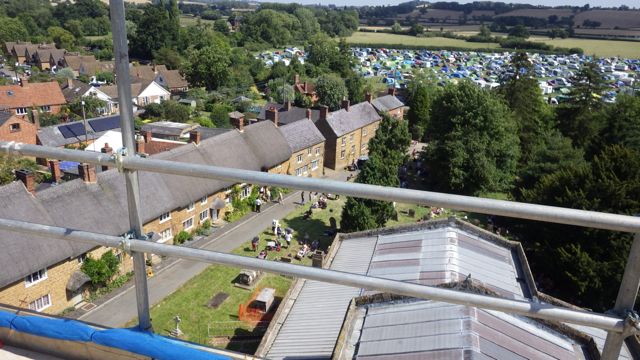
Over the weekend we opened the tower to festival goers to admire the
view at £5 a trip and made nearly £1,000 towards the project.
FRIDAY AUGUST 5th.
Our last day before the Fairport* shut down and plenty to do. (*We
have a huge music festival in the village with 20,000 people plus in
the vicinity many of who drink in the Red Lion and spill over into the
churchyard, it's all very festive and friendly and feels vaguely
medieval) . Peter examined another crushed skull burial and then whilst
cutting down to the final depth required by the pipework found another
but on a slightly different alignment. We have assumed from
stratigraphic evidence that all these burials are medieval but it
wasn't until today when Helen recovered some medieval pottery from the
fill of one of the graves that we got our first shred of evidence. I
wanted to be able to complete a basic record for all of our identified
graves with decent photographic coverage just in case. Then it was the
big clean up and cover over.
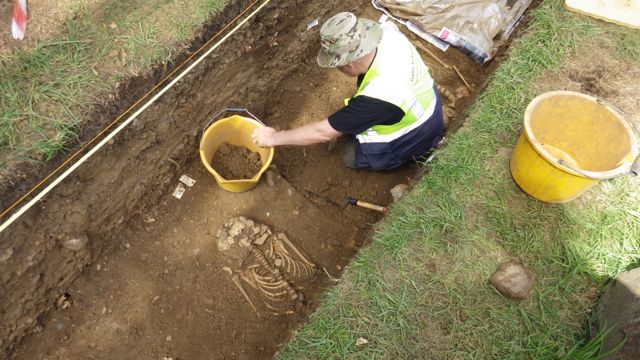
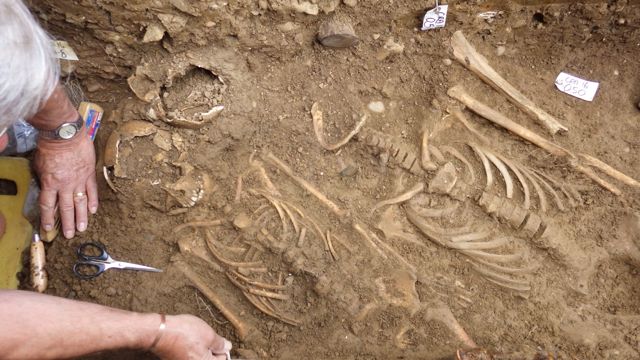
One grave cleaned another waits to the right of the bucket.
Peter B. and Helen co-operated on the double burial, the
individual on the left is probably an adolescent.
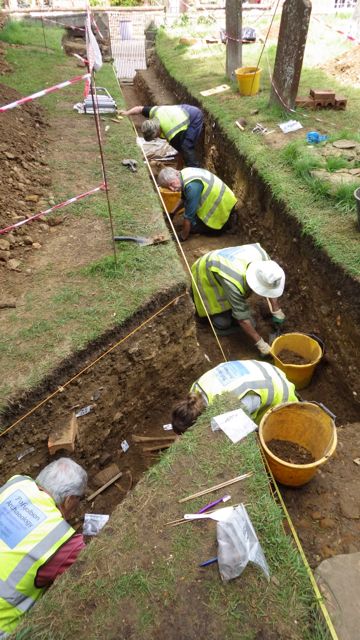
Everyone is busy getting as much done as we can before the shut down.
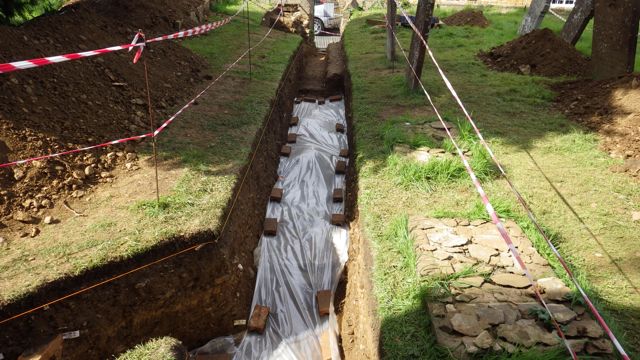
And here we are, covered over for the break.
THURSDAY AUGUST 4th.
A day when for the first time we could really get going on the
excavation of all our graves, now numbering nine. Peter S. did some
sterling work on cleaning up the burial associated with our only intact
skull so far whilst Andries demonstrated great delicacy of touch
excavating the bones of child burial, an individual who was probably 5
or 6 at the time of death. Next to this Mark tackled what appears to be
a pile of skulls, we are suggesting that this represents redeposited
charnel and we have at least one intact skull which is tossed in face
down.
WEDNESDAY AUGUST 3rd.
Time to complete the widening of the trench, hard work and it took up much of the day.
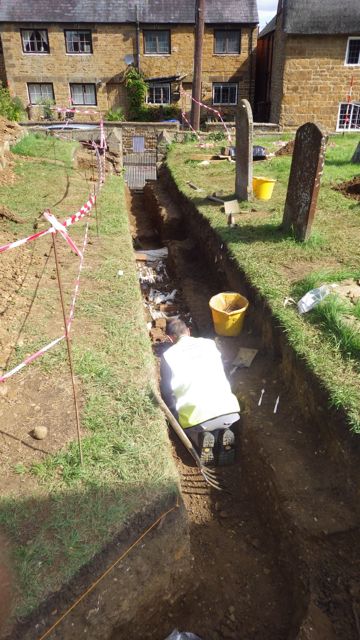
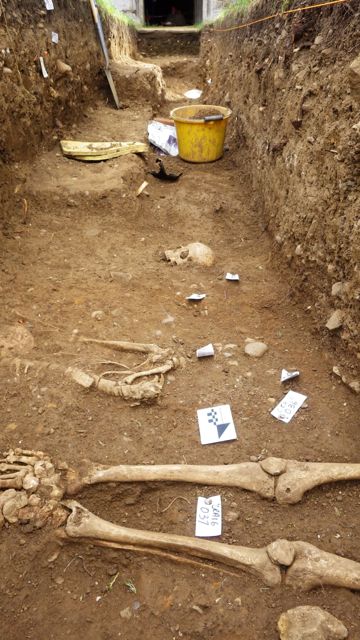
I can't work scrunched up like this... so we widen the trench and are ready to go on the three southern most burials.
TUESDAY AUGUST 2nd.
Monday was for us a day off but astonishingly by the end of the day we
had received a reply from the chancellor of the Oxford Diocese with an
updated faculty permitting the removal and scientific study of the
bones with provision for subsequent burial within a year's time. So on
Tuesday we began the full excavation of the burials. This is an
extraordinarily meticulous process and everyone set to with a will. Two
further possible burials were located and it became clear by the end of
the day that to maximize the data we could recover from these bones we
would need to extend the 60 cm trench to its full width of one metre.
It was Sarah's last day but such was her dedication that she insisted
on spending the morning digging before heading off to catch the
Eurostar for Brussels.
FRIDAY JULY 29th.
The weather was looking a little unsettled so we erected some temporary
shelters over our diggers. We had established the fact that a report
would be needed for the consistory court of the Oxford Diocese in order
to get permission to proceed with any further with work on the burials.
This meant establishing as best we could how many intact burials there
were and cleaning them to the point where an assessment could be made
and some photographs taken.
THURSDAY JULY 28th.
We took a little time out to pop up to the top of the tower and see how
the plumbers were getting on with the new roof, down on the ground work
slowed a little as we contemplated the implications of the burials we
had unearthed.
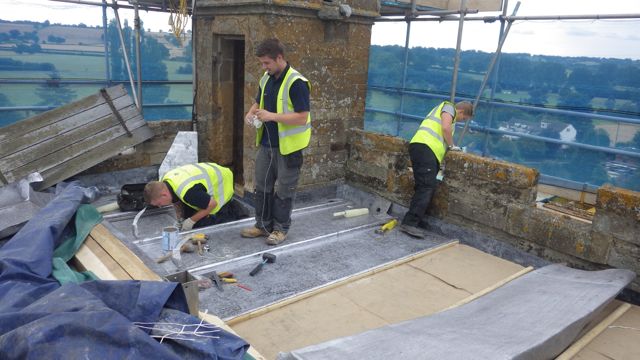
The lead work on the tower roof starts to go down.
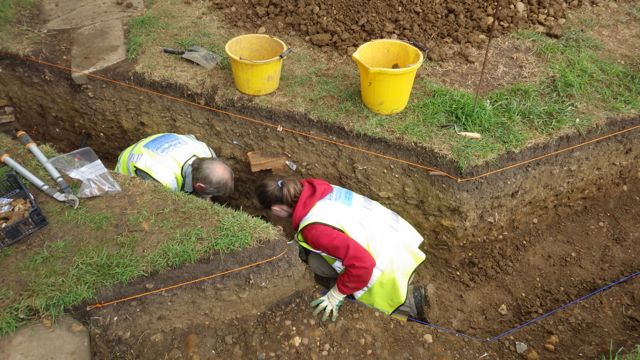
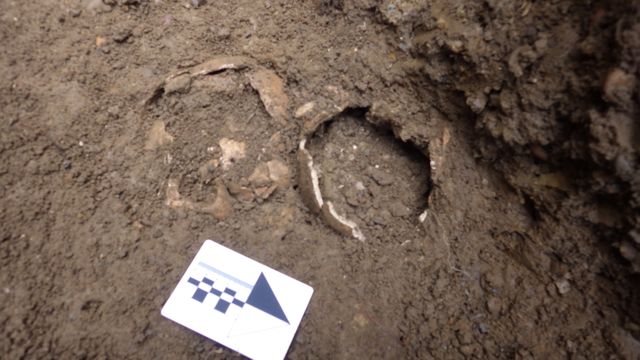
Sarah and Andries go head to head over the two skulls which appear to be lying cheek to cheek!
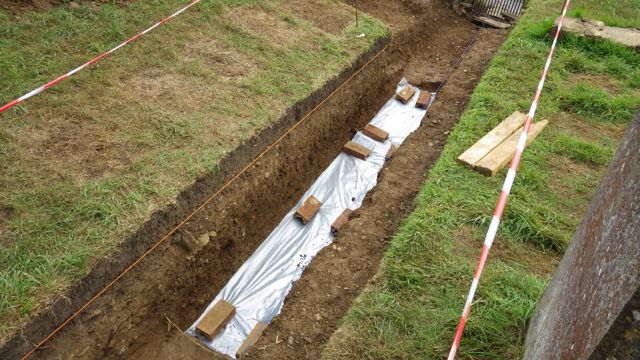
Now that human remains have appeared in the trench we have to take
particular care to cover them over at the end of the working day.
WEDNESDAY JULY 27th.
We began the day confidently enough with lots of section drawing
underway (Thanks Sarah) and the careful dismantling of the drain.
Knowing of the depth we needed to attain in our narrowed trench we
pressed on with pickaxe and mattock, spade and shovel... and then, close to the bend in our trench, remains of two skulls, lying practically cheek to cheek,
whilst being unearthed almost simultaneously at the other end of the
trench some leg bones make an appearance and all of a d sudden we have
to reassess our notions of just how shallow some of these burials could
be.
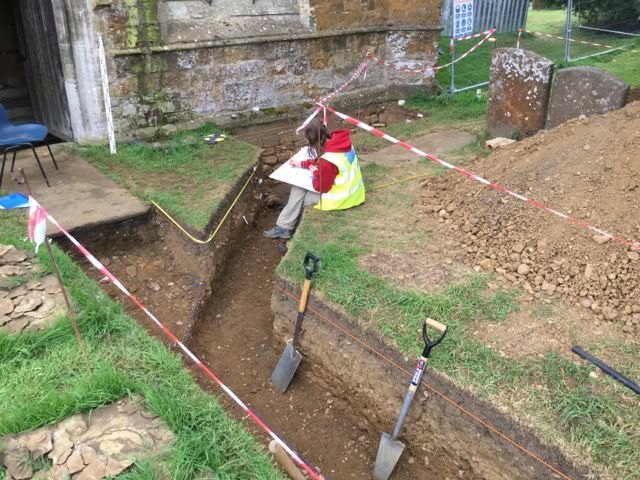
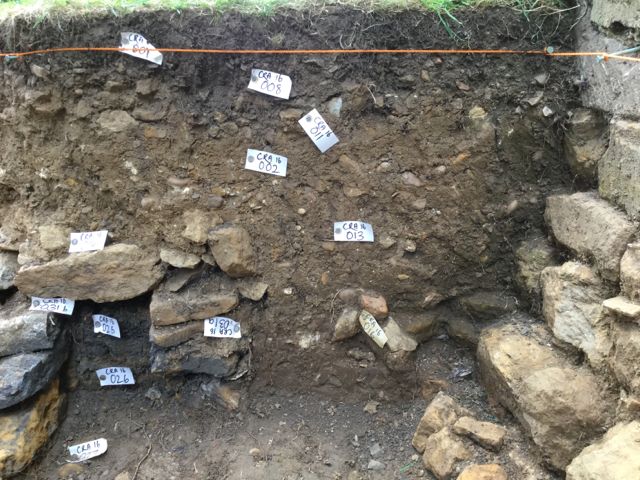
Sarah sets to to draw sections and here is a photo of the east end of
the trench alongside the north aisle wall that Sarah began on
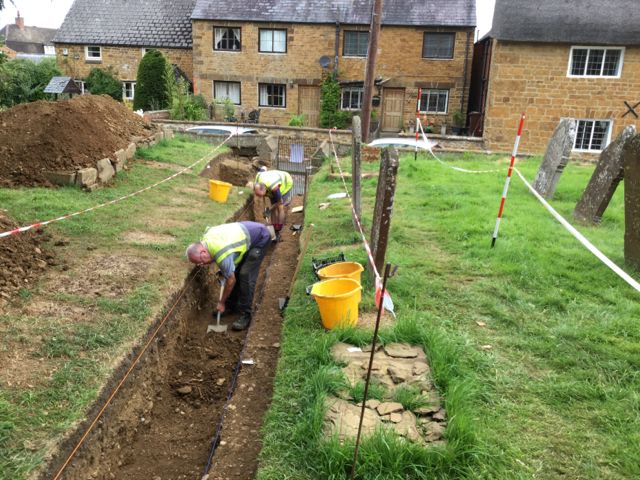
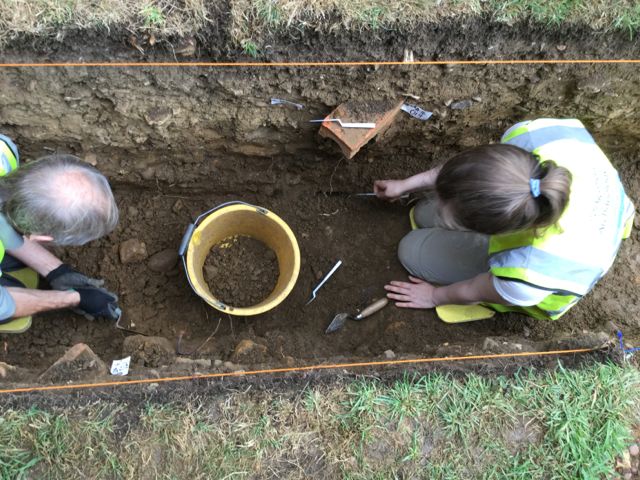
Spade work gives way to trowel work as the two skulls appear.
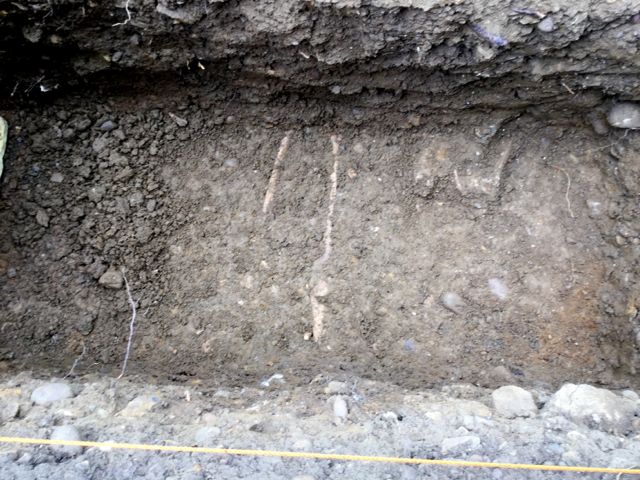
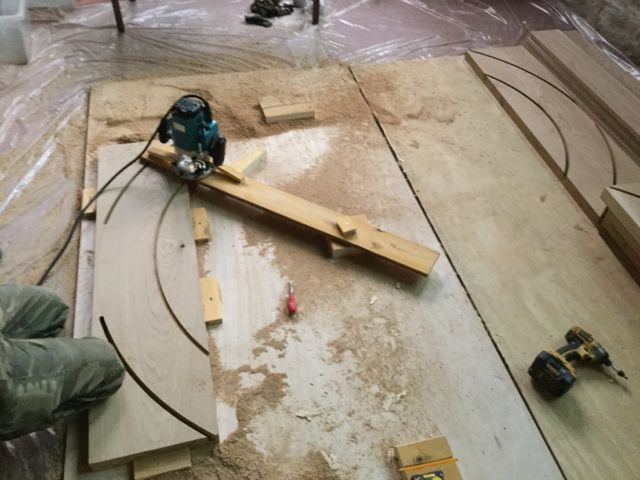
Plus leg bones elsewhere. Meanwhile entirely unaffected by all this Ian crafts a new oak backing for the clock face.
TUESDAY JULY 26th.
Today was the first day when we really got cracking on the some serious
dirt shifting for the new water supply. Lee came and gave us some
guidance on appropriate levels and we set to with picks and mattocks,
spades and shovels and mad remarkably good progress. there was some
excitement when Peter B. came across some skull fragments which hinted
at an intact burial but it was not to be. Meanwhile cast adrift a on
the B site Kathryn and friend looked for a discovered the line of
the former boiler house wall which we had all been told about.
FRIDAY JULY 22nd.
The oppressive weather eased a little towards the end of the week and
we began removing the cobbles and other elements of foundation and
drain to try and get to the bottom of what the church was built on. It
had been agreed at the progress meeting earlier in the week that we
would attempt to complete the main part of the dig, and have it
back-filled before the Fairport Festival... gulp! So a final clean up
and a long hard look was called for before we sub-divided the trench to
give us a final cut 60 cm wide.
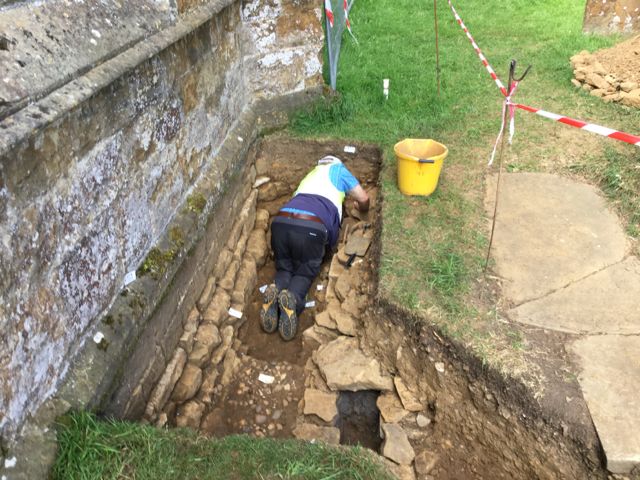
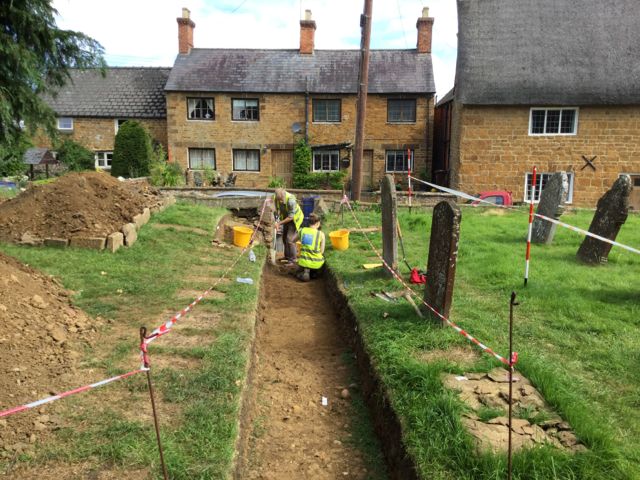
Peter starts to disappear down a hole, seen any white rabbits ? Andries and Sarah take out the next spit of trench.
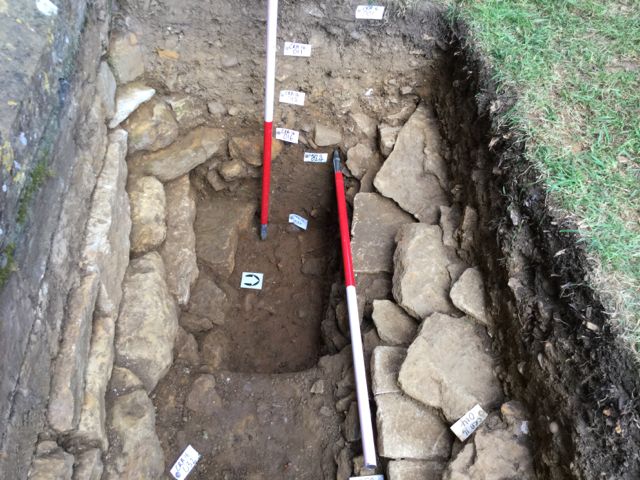
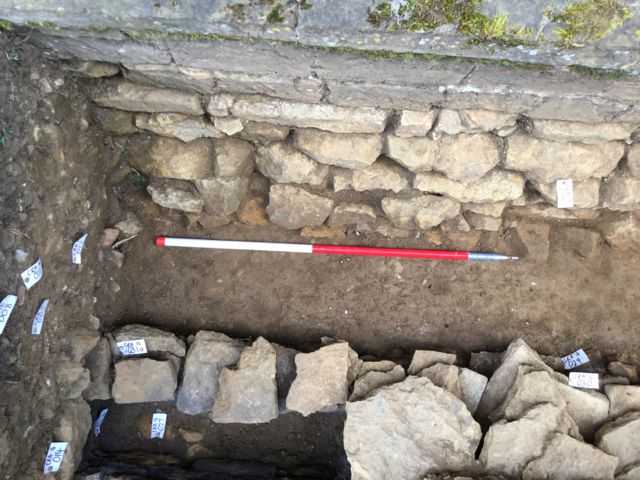
Interesting features of the foundation type are revealed.
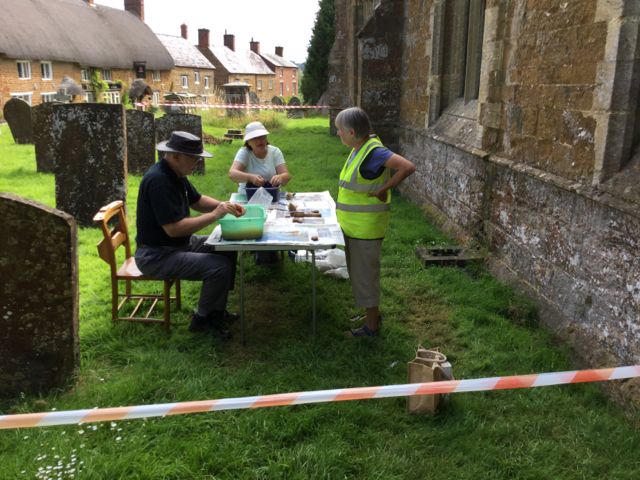
The finds department pressing on.
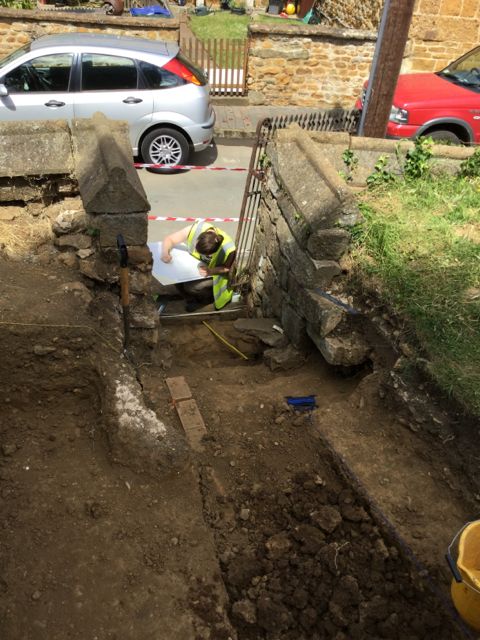
Sarah bakes in the hot sun as she tries to get an angle of the other set of foundations.
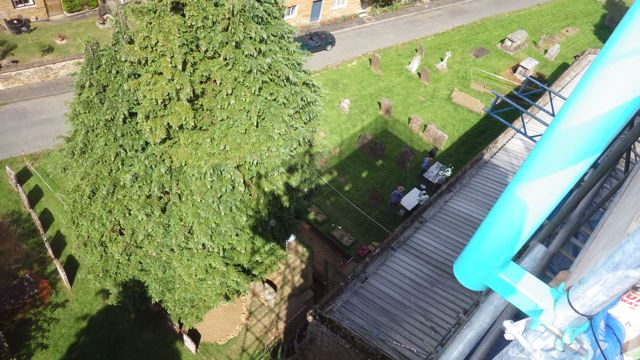
... and finally, before finishing for the weekend, the view from on high.
TUESDAY JULY 19th.
And Kathryn returned the following week with Naomi who is another
Farnborough/Hanwell 'old timer', sorry that makes her sound ancient.
The s day was stiflingly hot and those who were sheltered by the
church;'s shadow got on well, however, we had to engineer a temporary
cover for the poor souls out in the mid-day sun. After a lot of hard
work by Mike especially the final steps were removed and we had a
chance to explore below the lowest, apart from discovering a shallowly
buried BT data cable we also came across foundations for an earlier
churchyard wall which will give us lots to think about.
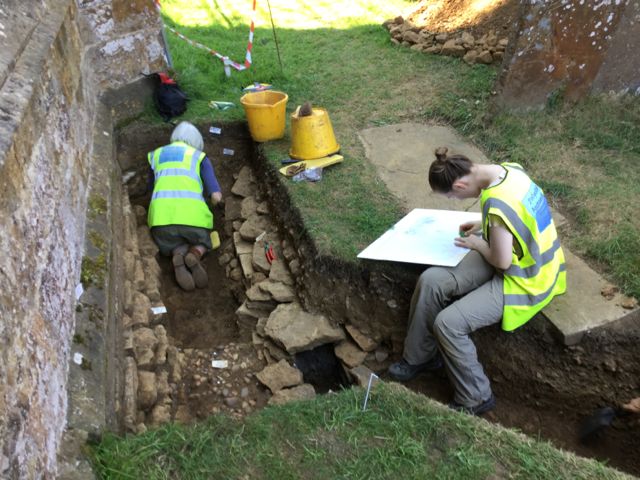
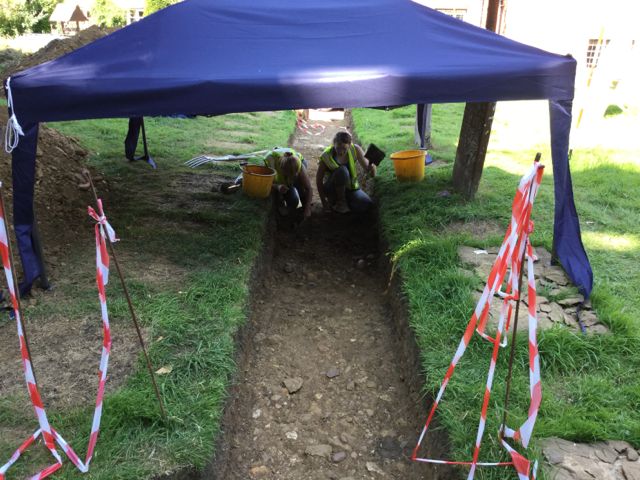
Chris digs as Sarah draws, all nicely in the shade whilst Naomi and Kathryn take their own shade with them.
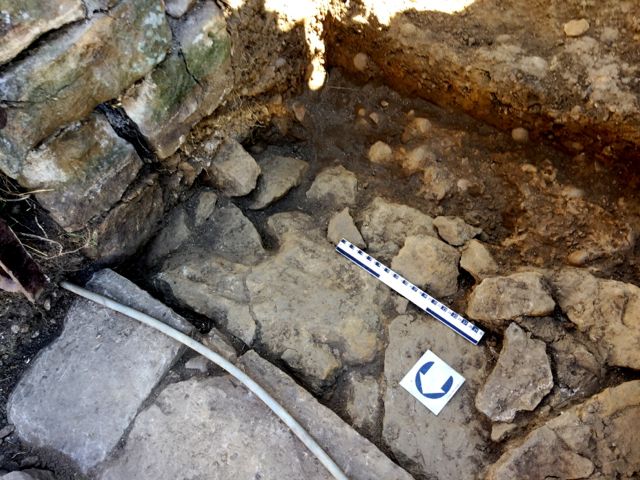
Early foundations for the churchyard wall.
FRIDAY JULY 15th.
A digger returns! Kathryn who is a veteran of Farnborough and Hanwell
excavations turned up with a friend for a day's work. The lid came of
the drain by the north aisle wall and Sarah began to carefully clean it
out and bag up samples for future study as she went.
THURSDAY JULY 14th.
There is a second trench on site, of course, from the vestry to a new
soak away so all its damp problems will be cured. It had been rather
neglected up to this point so we made some determined progress on it
finding large quantities of rubble where we had expected to see an old
boiler room. the trench immediately next to the north aisle wall
continued to give up its secrets and we were left with an impressive
collection of cobbles, foundations and drains.
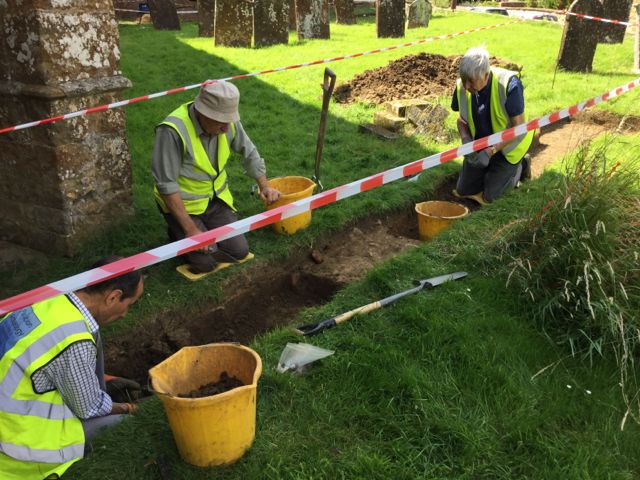
The team bend their minds towards CRB16.
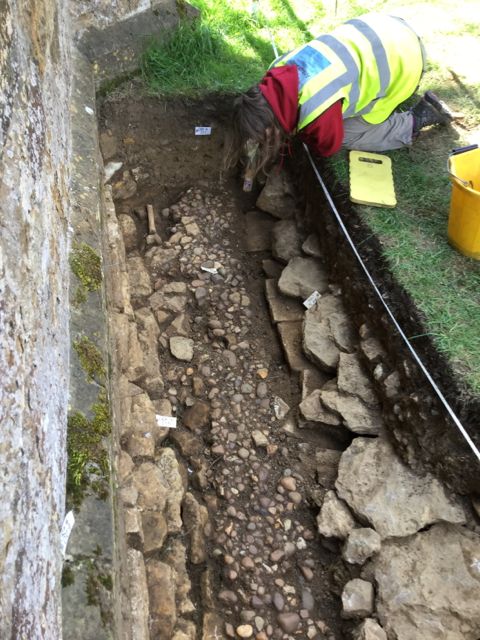
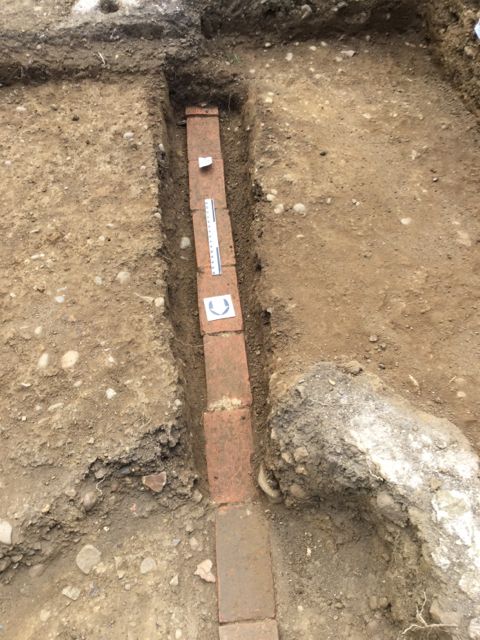
Sarah finishes the last little bit of cleaning to reveal the full
complexity of this little corner whilst down by the steps... more drain.
WEDNESDAY JULY 6th.
As the recording process came to an end it was time to remove the
gravestones to a place of comparative safety so pallets were set up
underneath the nearby conifer and after a lot of humping and hauling
the stones began to arrive at the new stone store. That morning Lee and
his crew had set up some temporary scaffolding to remove the old
rainwater goods so I had a chance to go up and get some semi-aerial
views of the dig so far. Finds washing and the dismantling of the steps
proceeded apace.
TUESDAY JULY 5th.
There was still a lot of recording to do on the gravestones and Verna
systematically continued to work her way along photographing them all.
We widened the section next to the steps and Andries pulled out the
first convincing bits of medieval pottery we had come across. other
wise it was the normal routine of scraping and scraping with a bit of
brushing only broken by the arrival of a delightful group of year
pupils from Cropredy School who came along to find out what all the
excitement was about.
SATURDAY JULY 3rd.
Although it was not an official digging day I spent most of Saturday
catching up with record keeping, particularly recording the
gravestones. As new departure for Polyolbion Archaeology we have being
doing mainly by entering data directly onto a pro forma on the iPad and
the exporting the data onto an Excel spreadsheet. Sue lester has been
doing an amazing job on researching the families whose stones have
appeared and shortly there will be a separate section of the project
web-site devoted solely to this information.I had taken advice from Lee
our site foreman on the best way to move some of our better stones
under cover and he suggested using super strong cling film to wrap them
to a board ready for lifting, thanks to Karen for assisting with this.
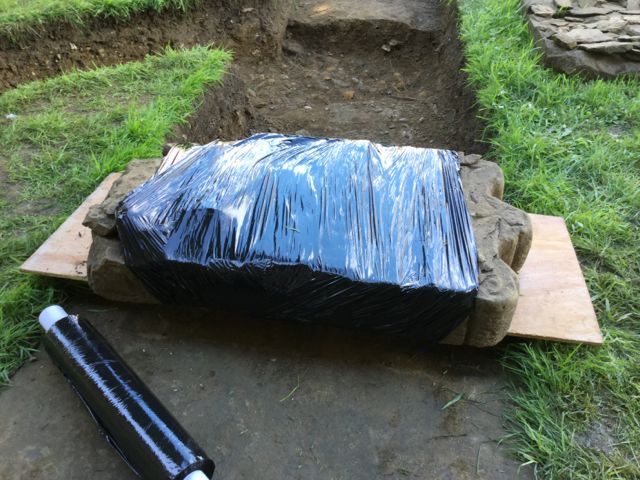
CRA16/st002 all wrapped up and ready to go.

A screen shot of some of the data we are accumulating about the stones.
FRIDAY JULY 1st.
A full day's digging with no interruptions from the rain. Peter devoted
a lot of time to cleaning up the complex bit of archaeology immediately
alongside the north aisle wall. the combination of foundations, cobbled
surface and drain will take quite some understanding but by the end of
the day we had it all photographed and now someone has to draw it all.
Meanwhile Mike began the ticklish job of dismantling the steps and
seeing what exactly was resting on what. in the mid-zone more careful
planing away of surfaces searching for earlier paths and cuts for
graves.
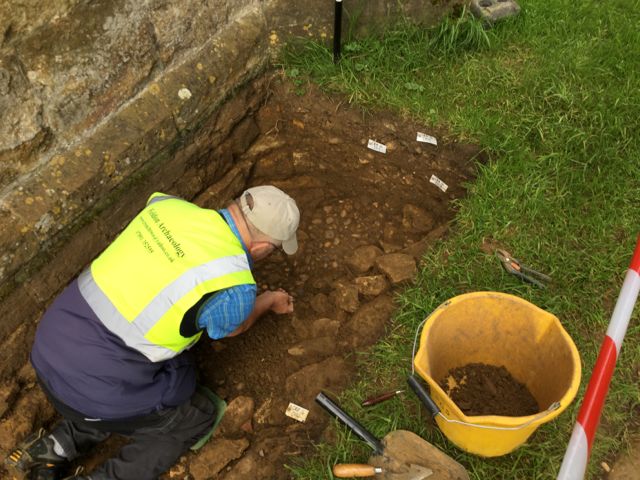
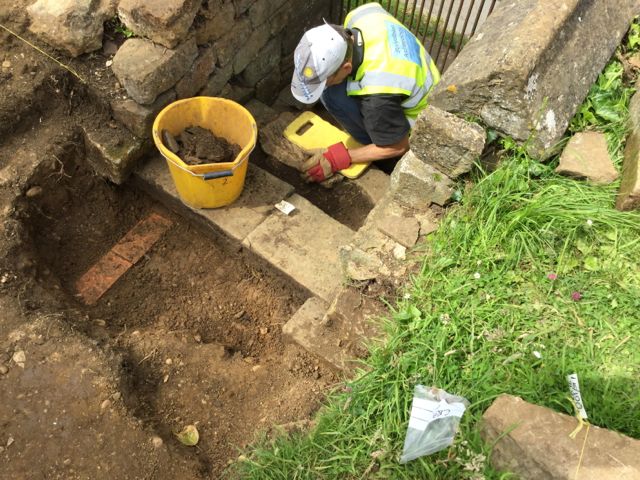
Peter
begins the big clean
up.
Mike takes out the steps.
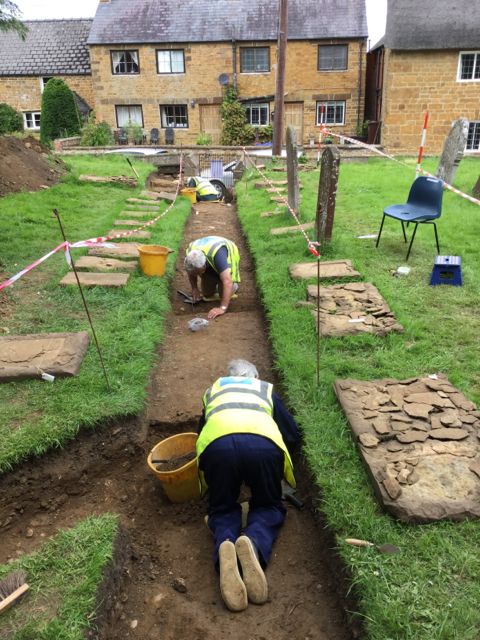
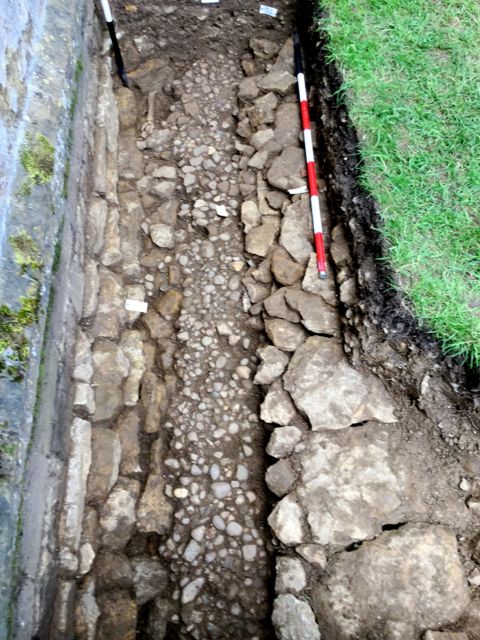
More brown silty earth to
shift.
After the big clean up, view looking west.
The scaffolding tower also went up so the contractors could start to
remove the old rainwater goods from 1873, much of it now sadly corroded
and damaged. It did however give us a chance to get up close to some of
the wonderful; faces on the corbel table and photograph them for the
record. i spent most of my time carrying on with the lengthy process of
recording gravestones that we have uncovered. A couple of points struck
me forcibly, as I emailed to Julian Munby, the diocesan archaeology
adviser the next day:
"A couple of the stones have had
elements of sculpture carefully removed by chiseling then out before
burial, specifically a rosette, some unknown motif and a kind of
Corinthian capitol (See photo below), we're struggling to establish a
context for this, collected for some purpose we assume. The second
point of interest is that some of earliest stones were painted, I'm no
great expert but the painting of gravestones for outside use is not
something I've heard of before. In the example illustrated the
shield shaped panel for the inscription was white, the area below the
shield red and a blue line outlined the whole thing - really very
colourful (see other photo below). have you come across this before? If
it is an unusual feature it may be worth the project taking specialist
advice on the pigments and what have you. The long term aim is to keep
the better preserved stones on show in the church so any further
thoughts would be most welcome."
THURSDAY JUNE 30th.
Unfortunately I could only be on hand for a
half an hour or so as I had
another job down Eynsham way, however, Verna and Peter between them
kept things rolling along. Turf was stripped from the new trench in
Peter's usual meticulous fashion and Verna made good progress with the
equally meticulous task of making an accurate photographic record of
the gravestones. We even had a Brazilian student join us for the day!
we also continued to clear the brown silty earth deposit from the south
end of the path and Roger found some useful dating material including
some slipware and a fine clay pipe bowl.
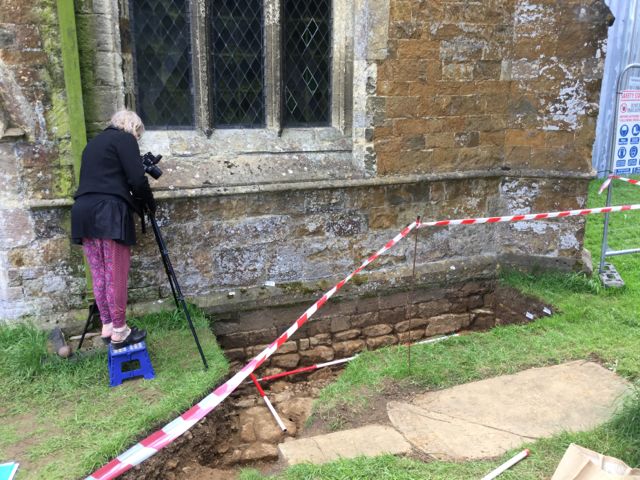
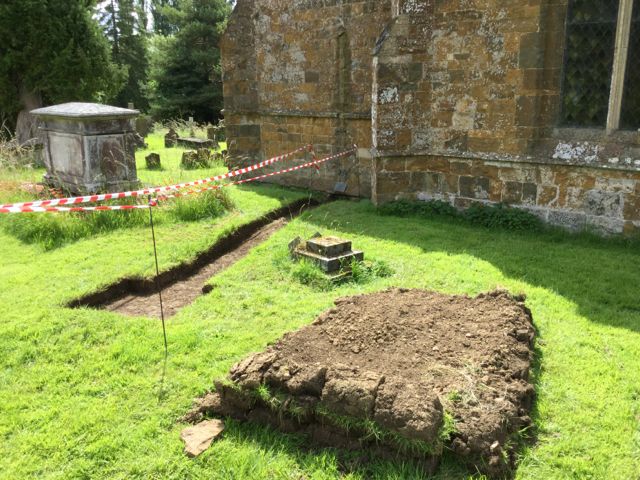
Verna uses her step up stool to get the best angle.
Now
that's how to stack spoil!
WEDNESDAY JUNE 22nd.
A surprisingly wet day given the weather forecast, we even sent Sue
home to get out of the rain. Peter however persevered and despite the
drips got on and cleaned up the area around and alongside the drain
uncovered yesterday. It turned into quite a little epic of cobble
polishing as he uncovered what appears to be the remains of a cobbled
path or yard next to the north aisle. It remains a touch messy and will
do so until things dry out a little then we can give it a final clean
and brush over. Very exciting, these are medieval cobbles. Less
exciting was my day, I finished the plan of the steps that Helen had
started yesterday and following a chat with Lee and Bryan laid out the
site of the new drain and soak away designed to keep the vestry dry.
Peter also took a look at the silver coin and suggested it may be
a silver shilling of James I. Here are some close up views should
anyone else like to follow up on this one.
And follow up there was not only
from Pater but also Chris Leslie, however, the definitive account is
probably that from Jonathan Mann, former hammered coin specialist at
Spinks who comments:
|
Thanks
for sending the link. Very interesting! I saw that someone had
identified it as a James I shilling and I would have to agree (though
it could be a sixpence depending on diameter and weight). Looking at
the king's armour and the title this piece emanates from the earliest
part of James' reign; the First Coinage of 1603-04. Luckily we can
still see IACO and SCO which are both definitive parts of the coins
dating and attribution. In full it would have read IACOBVS D G ANG SCO
FRA ET HIB REX. During the Second Coinage of 1604-19 the Scottish
title was amalgamated with the English title so you no longer see SCO
on James' coins. This secures the dating to the earlier coinage. There
is one catch. Normally you would expect to see a mark of value (VI of
XII) behind the bust. This is either completely worn away (unlikely as
this is part of the least worn area of the coin) or was not present on
the coin in the first place. There was an issue struck at London for
use in Ireland with the Irish harp surmounted by a crown on the reverse
of the coin (not pictured so I can't gauge it) which omitted the mark
of value on the obverse so it's possibly part of this Irish issue.
What you
can obviously gauge from the coin is that it had been in circulation
for a long time before being lost or deposited. Just as a bit of fun,
and an interesting thought; even Elizabethan coins turn up in civil war
hoards so it's entirely feasible that this coin would have been
circulating as currency during the civil war and could possibly have
been lost during a churchyard skirmish during the Battle of Cropredy
Bridge! Unfortunately we have no way of knowing.
|
TUESDAY JUNE 21st.
A reasonably sunny day at last. the morning saw some more cleaning on
the long section left by the removal of the gravestone path, some
interesting deposits and once nice find (see below). We spent some time
on our favourite gravestone jigsaw and Chris and Mike make great
progress on reducing levels next to the wall of the north aisle ands
around 40 cm down a feature. After lunch Chris and Roger explored it
further and it turned into a very convincing drain. As there is no
evidence of a cut and its down at a level with the foundations this may
date from the 14th. or 15th centuries when work was carried out on the
aisle. Meanwhile Helen made a start on drawing the steps, the final bit
of recording before they too have to come out.
SUNDAY JUNE 19th.
A small but select band turned out to dig on Sunday afternoon and we
spent time planing off a few more millimetres of sub-soil from along
the line of the path. Quite a useful collection of finds from this
deposit 002 but nothing much later than the eighteenth century
appearing. However, the find of the day was what appeared at first to
be a bit of foil or milk bottle top turned out on closer examination to
be a silver coin, my initial thought was possibly an Elizabethan threepenny bit. Horribly worn and not worth
anything today but it must have represented quite a loss to whoever
dropped it on their way to or from church.
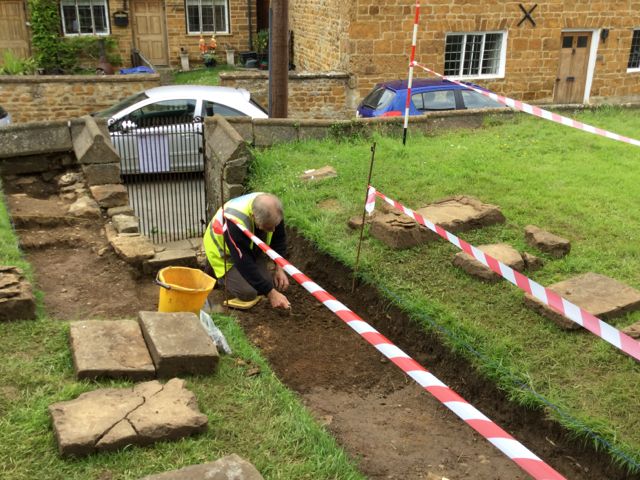
Andries moments after making his big find.
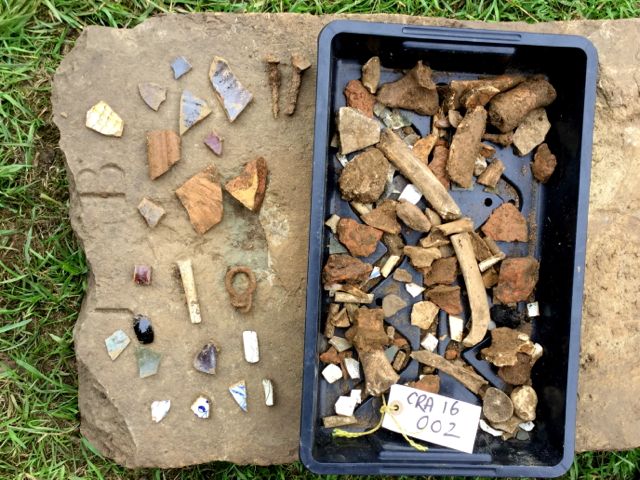
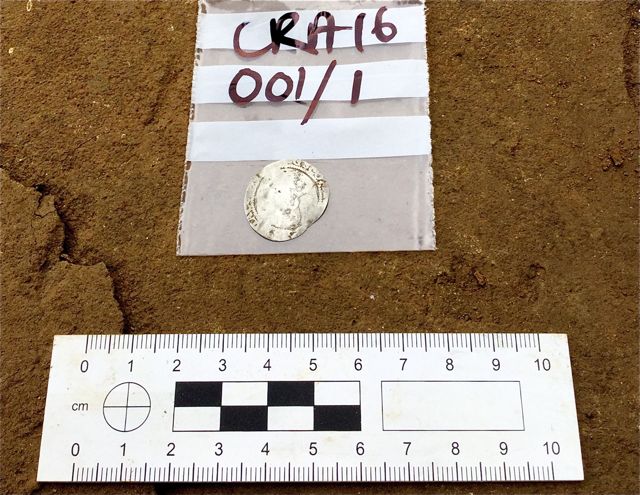
Assorted bits a pieces from below the
path.
Our second coin (the first was a 1958 half crown).
FRIDAY JUNE 17th.
J
ust a few more stones to lift, unfortunately these proved to be
some of the most badly damaged specimens and so took up a lot of our
time and effort. We were delighted to welcome a wandering group of
young school children to see the sites and Verna gave them a guided
tour. Once the stones were out we began the job of cleaning back over
the whole area to see what lay beneath, initial thinking, based on the
date range of the stones and the pottery fragments discovered below
them is that the path was probably laid late in the eighteenth century.
One particularly poignant inscription was on one of the last stones to
be lifted dating from 1664:
1664
HERE
IS INTERED Ye BODY OF
HANNAH Ye ONELY DAU
GHTER OF JOHN & HEST
ER STRATTON GRAND
CHILD TO NEHEMIAH
AND JONE MANSELL WHO
DEPARTED THIS LIFE MAR
THE 11th 1664
For to prevent my youth's
approaching crimes nature
my nurse laid me to sleepe
betimes.
A sorry thought which seems to derive from a well known monument in
Richmond Church, Yorkshire to one Timothy Hutton, son of Archbishop
Hutton of York, who died in 1629.
Verna
thrills our visitors with tales of digging, the stones are nearly
all
up.
Andy and Mark clean Hannah's stone with its sad little verse.
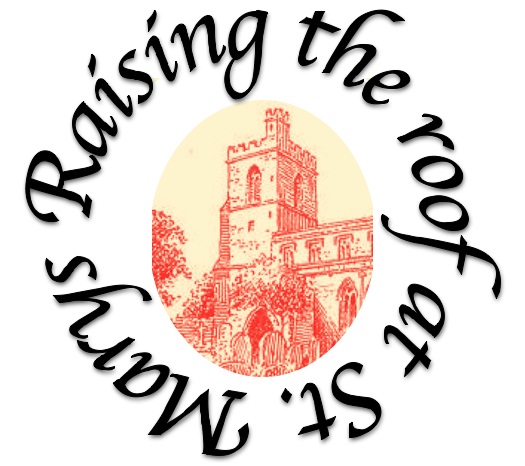 Archaeology: The Dig
Archaeology: The Dig

 Archaeology: The Dig
Archaeology: The Dig











































